Billionton Systems GCBBTCR41X Bluetooth Cardbus Card User Manual NLF GCBBTCR41X
Billionton Systems, Inc. Bluetooth Cardbus Card NLF GCBBTCR41X
Contents
- 1. User Manual 2
- 2. User Manual 1
User Manual 2
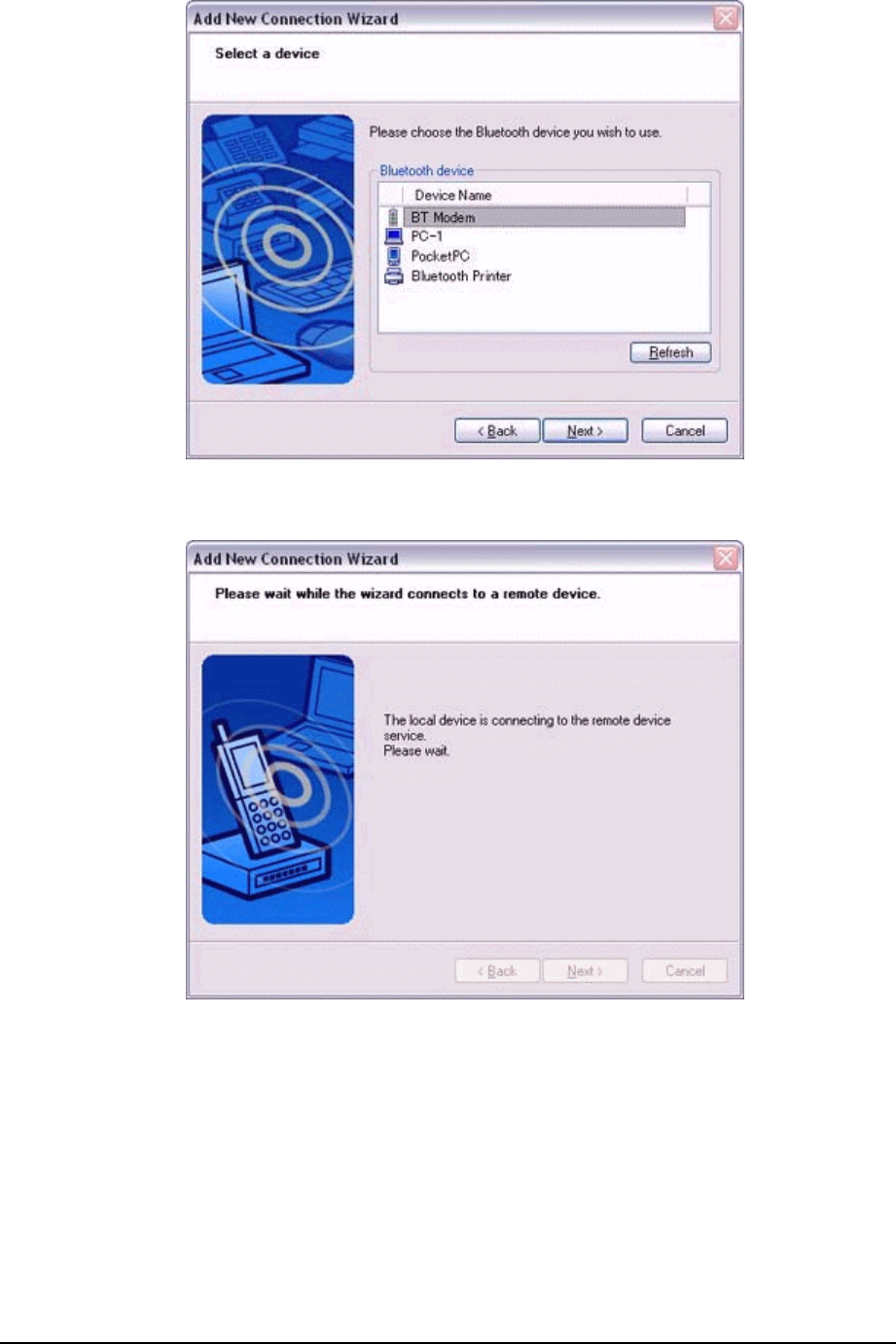
89
The [Add New Connection Wizard (Searching for Services)] window will appear.
5. If you are connecting to the wireless modem station for the first time, enter
the passkey for the device from the [Bluetooth Passkey (PIN Code)] window,
and then click on the [OK] button.
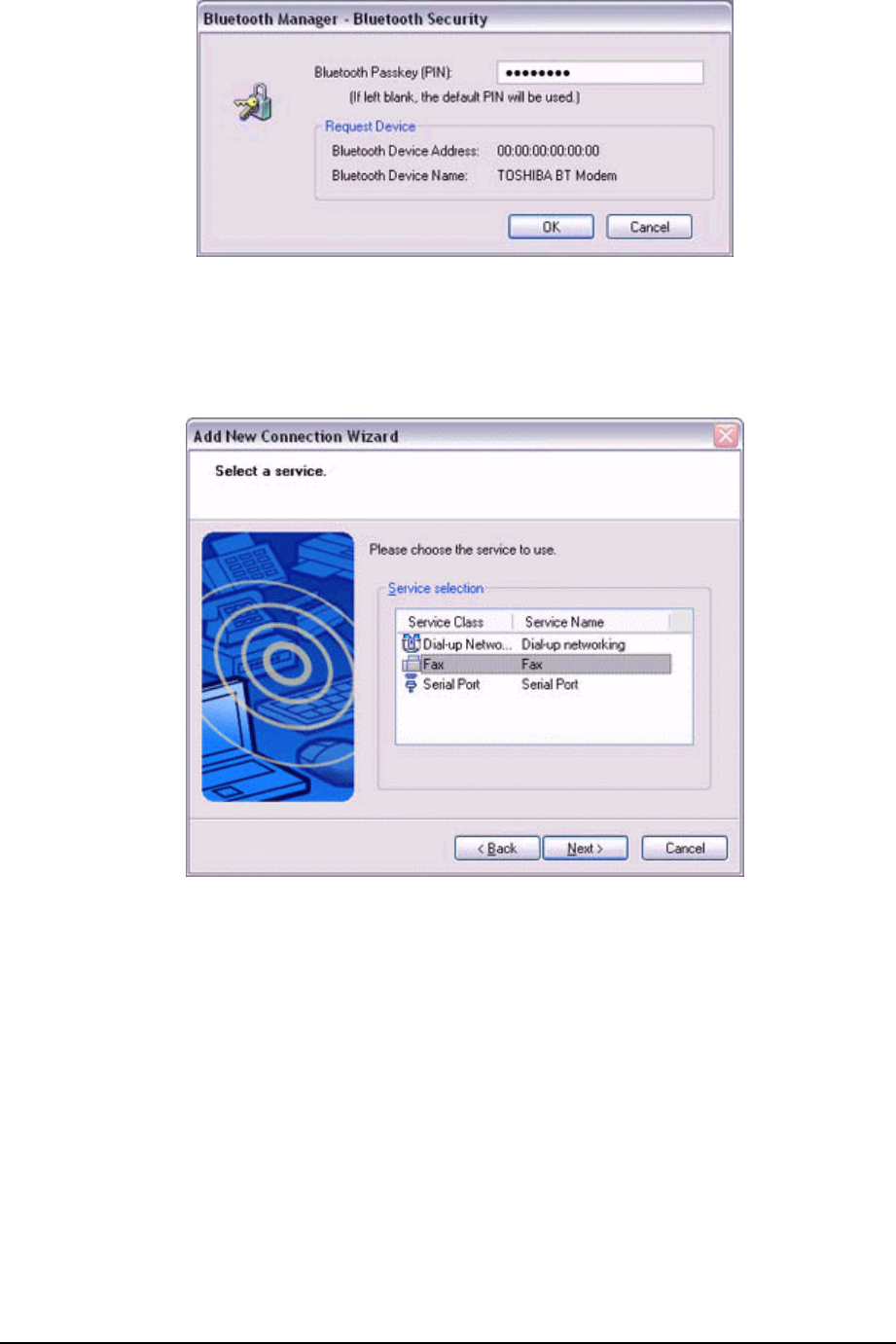
90
Once the program has finished searching for the services, the [Add New
Connection Wizard (Select Service)] window will appear.
6. Select "Fax" under [Select Service], and then click on the [Next] button.
The [Add New Connection Wizard (Select COM Port)] window will appear.
7. Check [Use default COM port], and then click on the [Next] button.
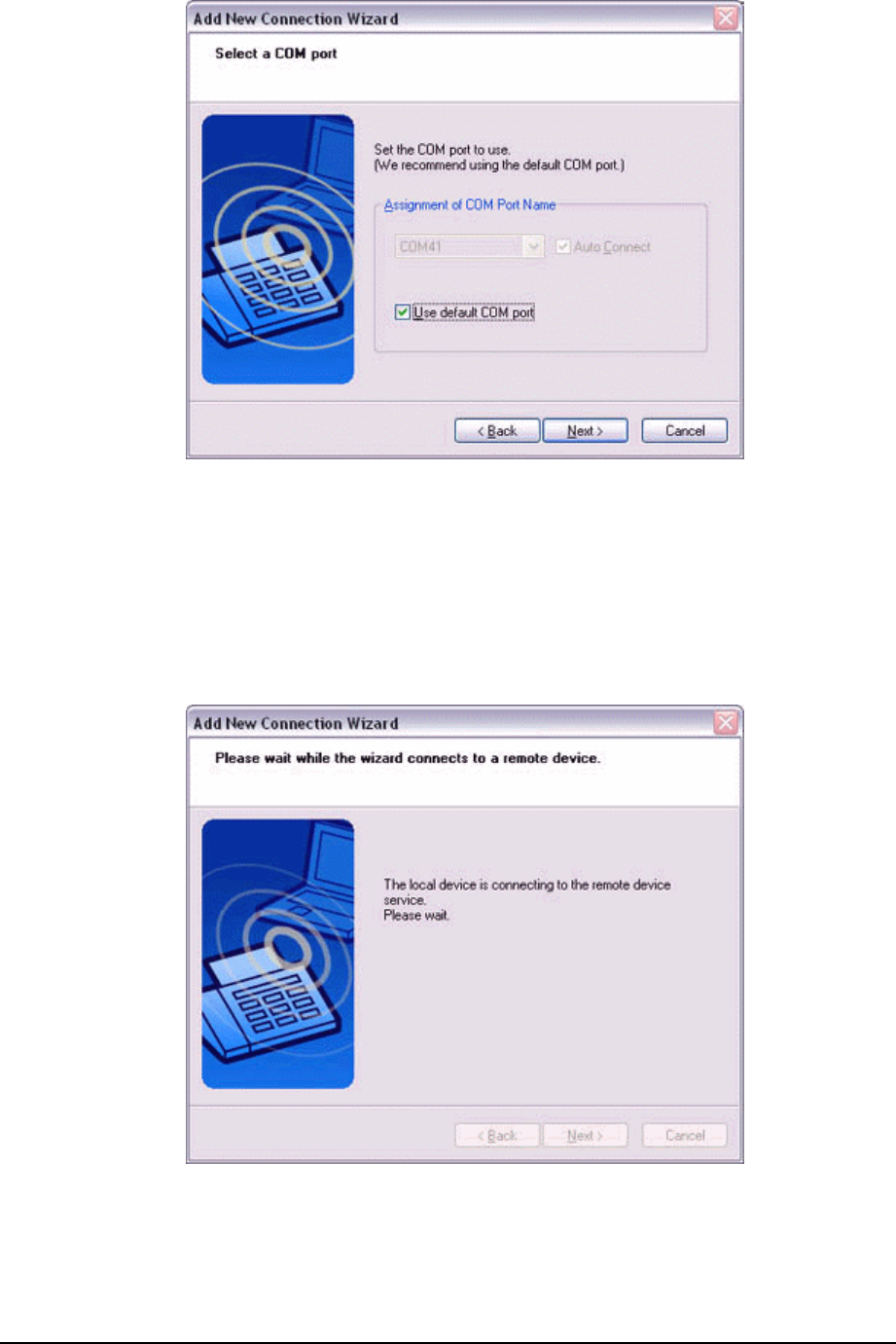
91
Note
.The modem station will be installed to the grayed-out COM port displayed under
[Assignment of COM Port] in this window. You will be specifying this COM port in
Step (3) of "●Installing a Modem", so please write it down for future reference.
The [Add New Connection Wizard (Connecting to Remote Device)] window will
appear.
The [Add New Connection Wizard (Modem Settings)] and [Phone and Modem
Options] windows will appear.
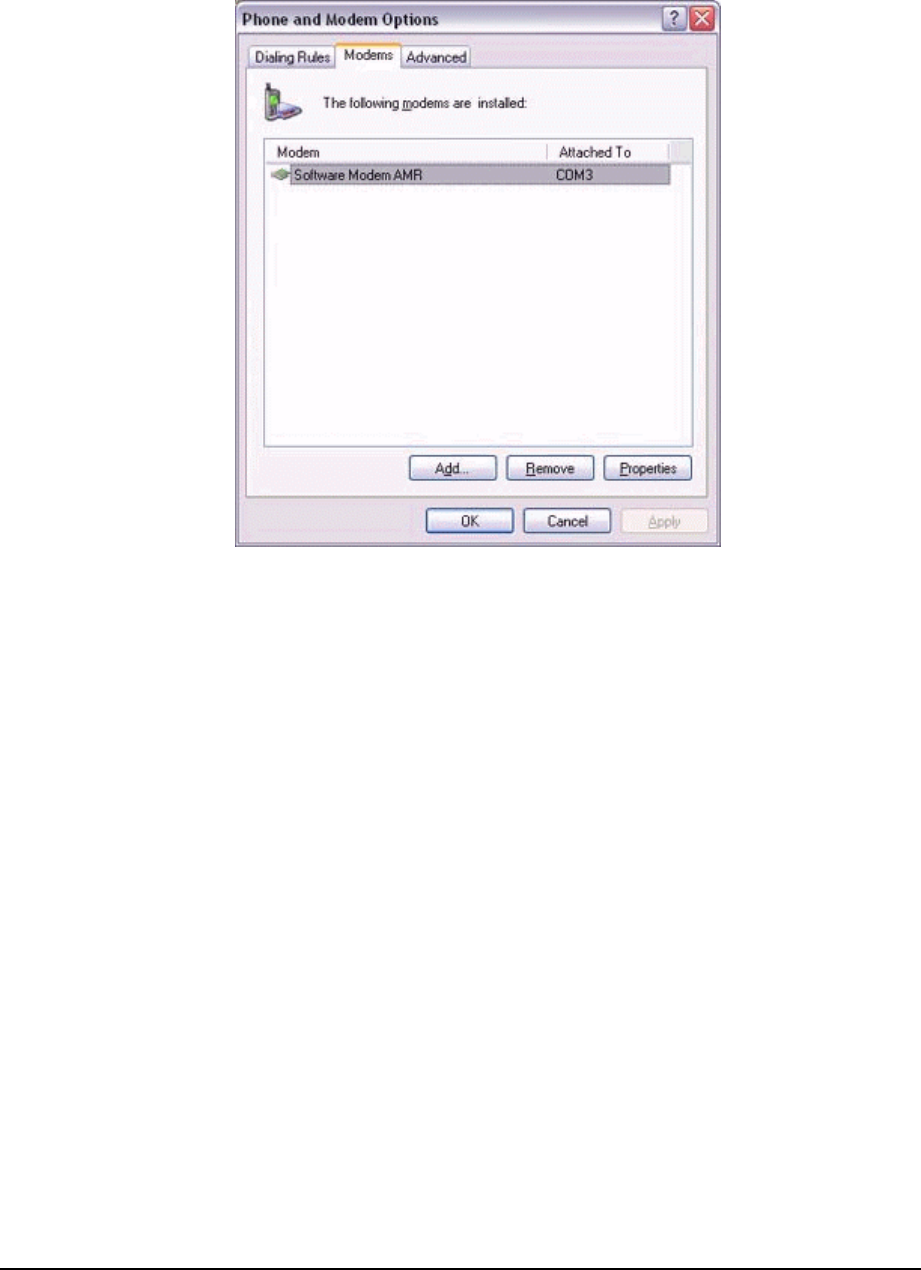
92
8. Click on the "Add..." button in the [Phone and Modem Options] window.
The [Add New Hardware Wizard (Install New Modem)] window will appear.
Install the modem by following the instructions in the windows that follow.
Installing a modem
The [Add New Hardware Wizard (Install New Modem)] window will appear.
1. Check [Don't detect my modem; I will select it from a list], and then click on
the [Next] button.
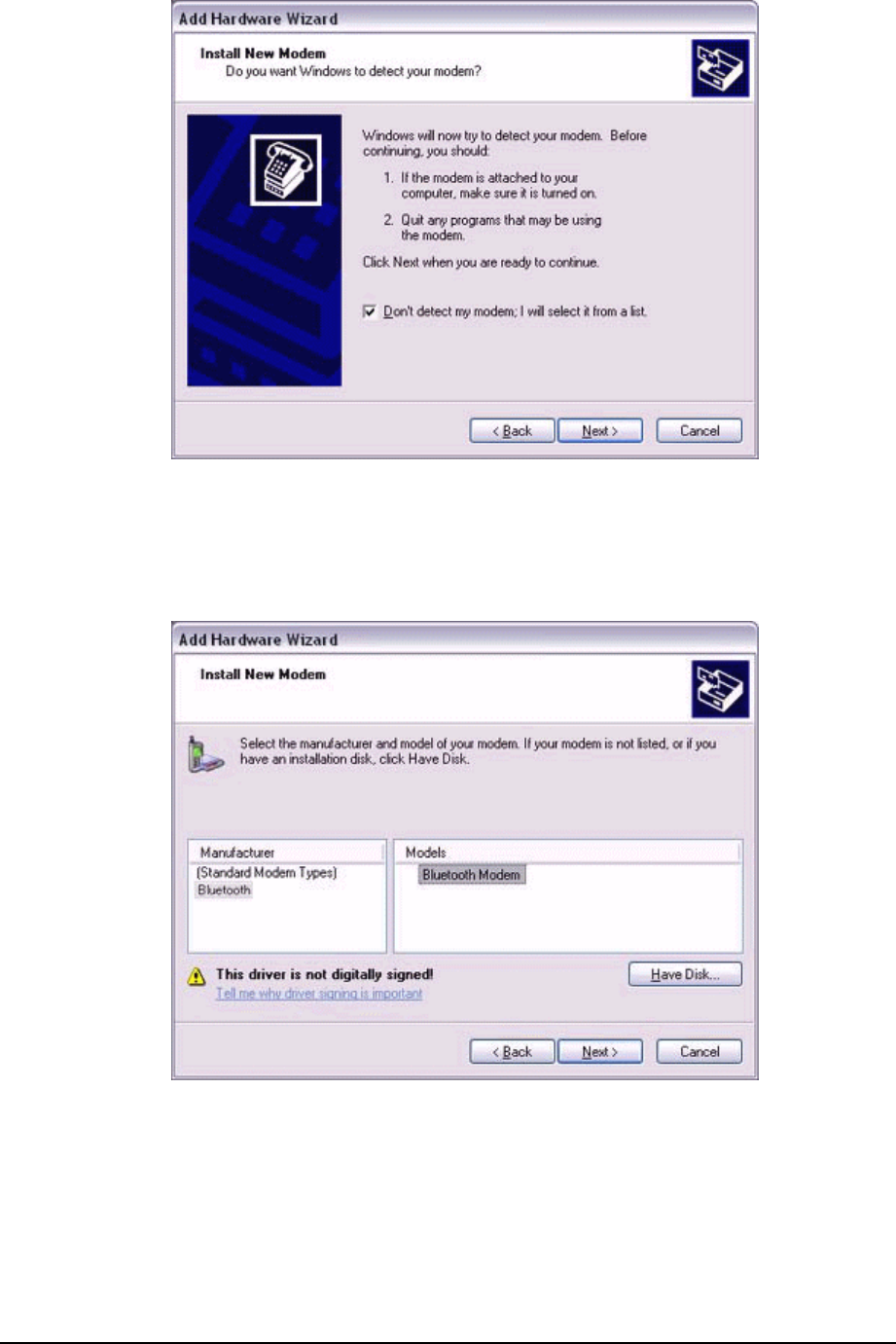
93
A list of modem manufacturers and models will appear.
2. Select the desired wireless modem from under [Manufacturer] and [Models],
and then click on the [Next] button.
Note
.If you have not yet installed a modem driver, click on the "Use Device" button to
install one from this window.
.If no modem drivers appear, please select "(Standard Modem Types)" and
"Standard 33600 bps modem."
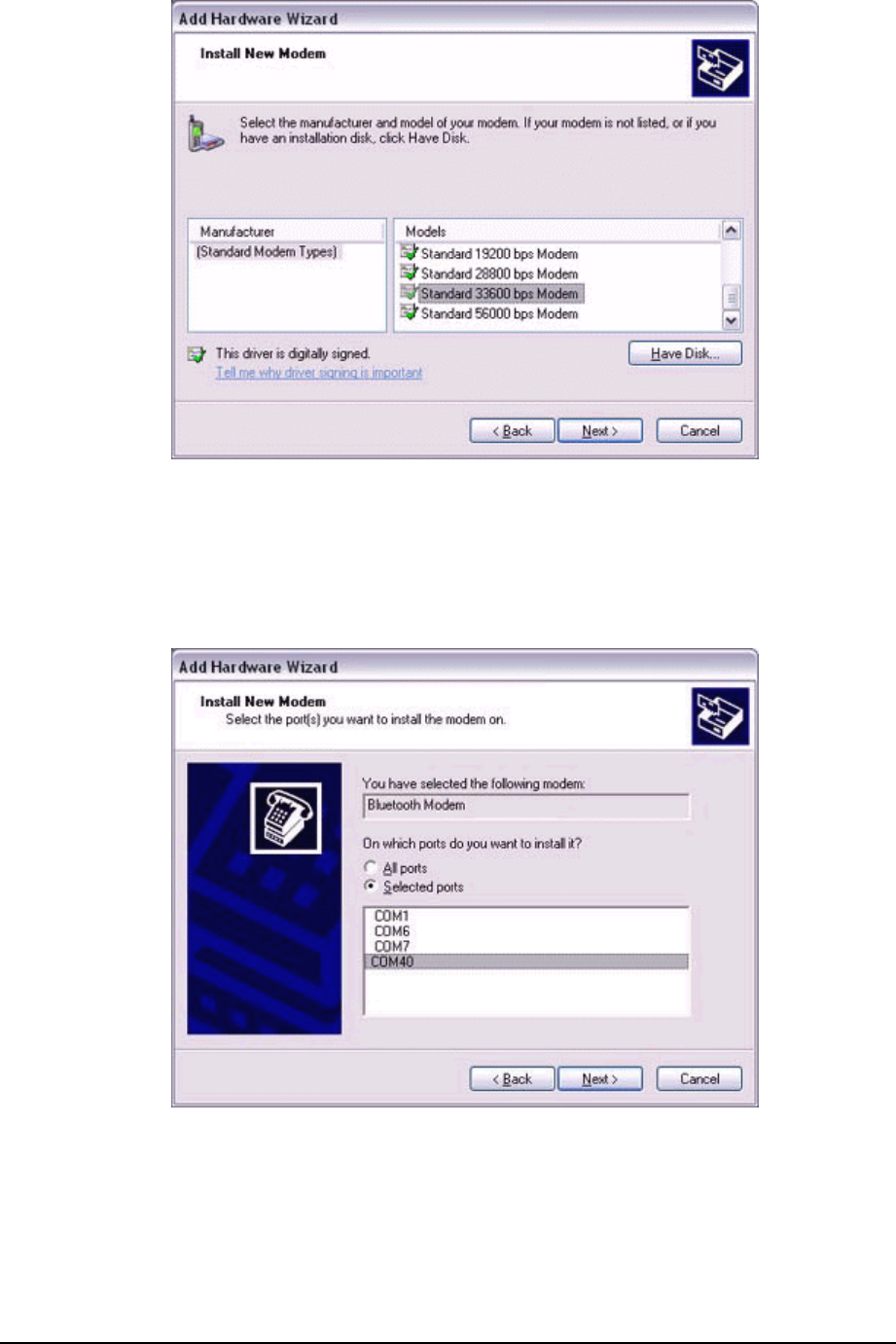
94
A window will appear where you can specify the port to which you can install the
modem.
3. Select "Selected Port", specify the COM port to which the modem will be
installed, and then click on the [Next] button.
Important
.Please specify the COM port displayed in the window pertaining to Step (7)
under "●Setting up the modem station."
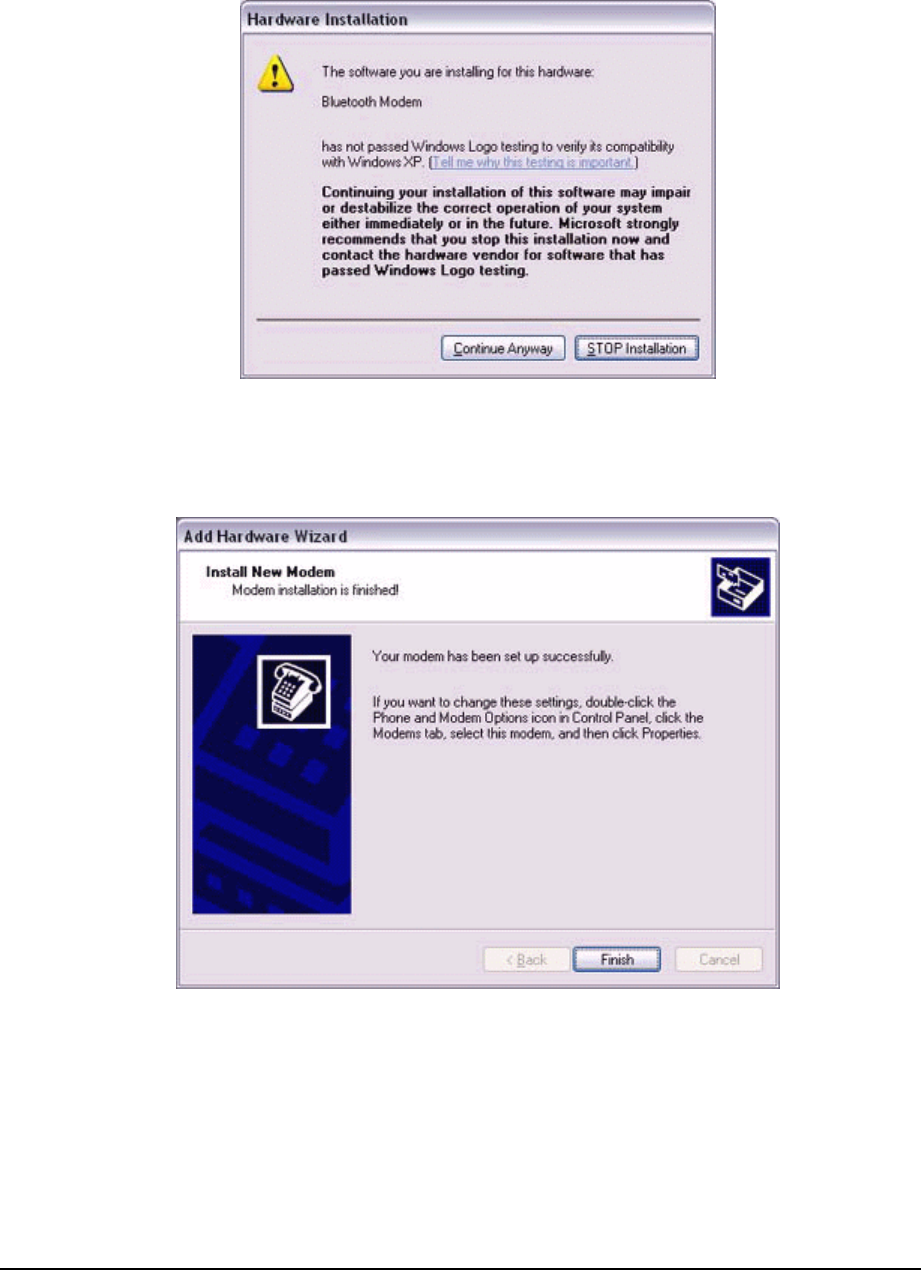
95
4. Click on the [Continue] button.
The wizard will display the following window by design, but you may disregard it
and click on the "Continue" button.
A window will appear indicating that the modem installation is complete.
5. Click on the [Finish] button.
6. Confirm that the configured modem has been added to the list in the [Phone
and Modem Options] window, and then click on the [OK] button.
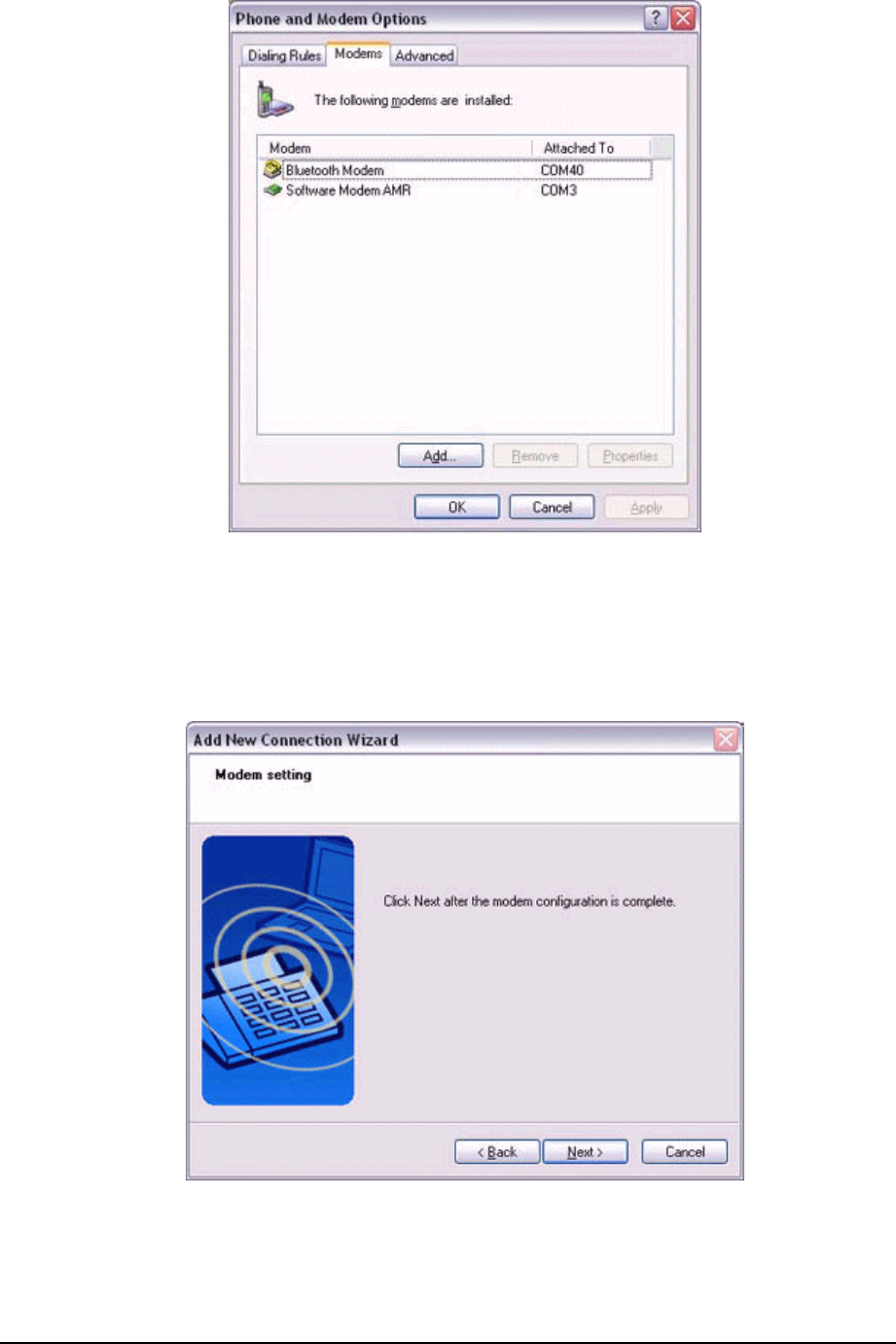
96
The [Next] button will be enabled on the [Add New Connection Wizard (Modem
Settings)] window.
7. Click on the [Next] button on the [Add New Connection Wizard (Modem
Settings)] window.
The [Add New Connection Wizard (Connection Name Settings)] window will
appear.
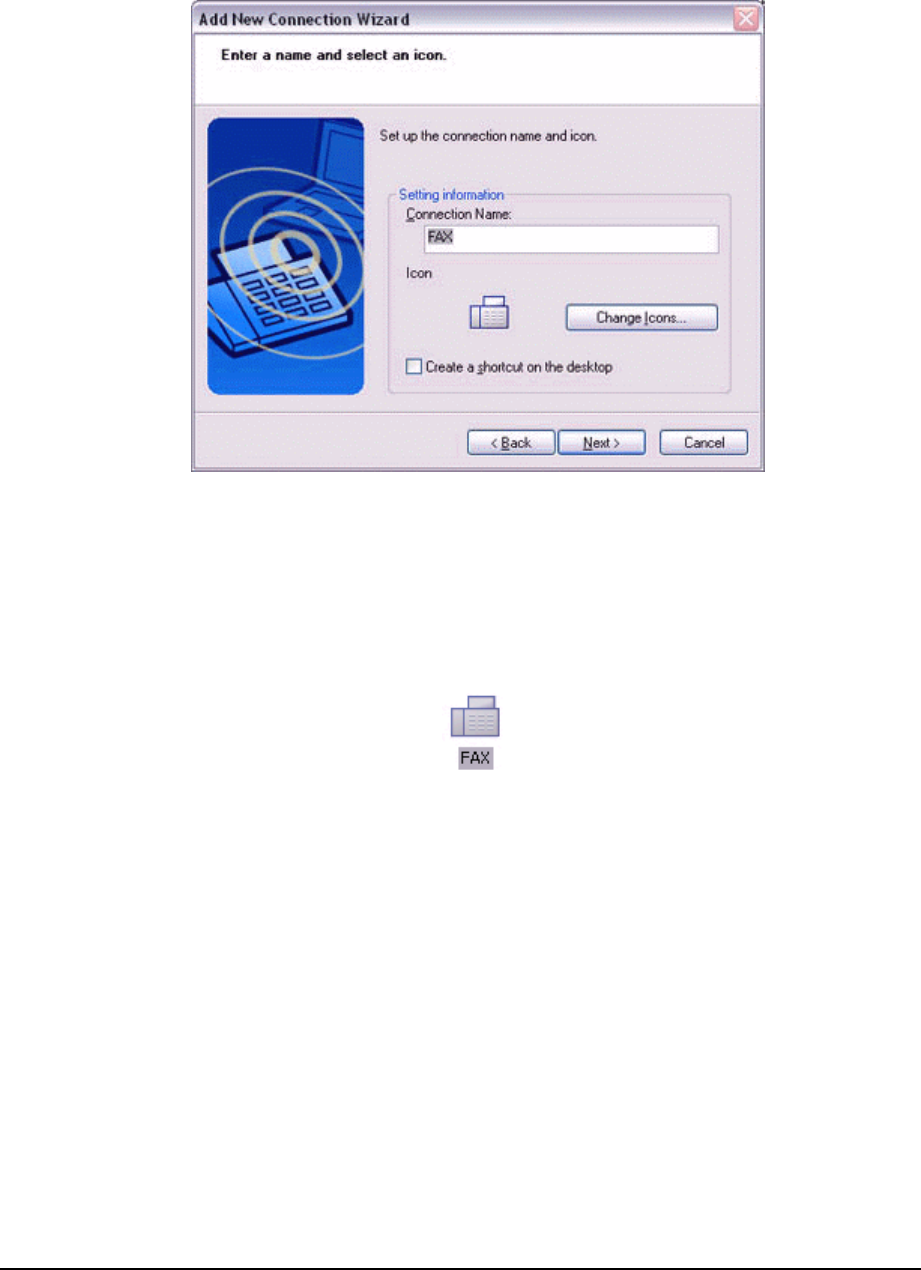
97
8. Enter the type and name of the icon displayed after registration, and then
click on the [Next] button.
Please click on the [Next] button if you are satisfied with the settings.
The [Add New Connection Wizard (Completing the Add New Connection Wizard)]
window will appear.
9. Click on the [Finish] button.
The settings will be registered, and the icon will appear in the [Bluetooth Settings]
window.
Setting fax information
Configure send/receive settings and register fax information.
1. Select [Start]Æ[Control Panel], and then double-click on the [Printers and
Other Hardware] icon.
Note
.If the control panel is displayed in "Classic view", and you use Windows 2000,
please start from Step (2).
2. Double-click on the [Printers and Faxes] icon.
The [Printers & Faxes] window will appear.
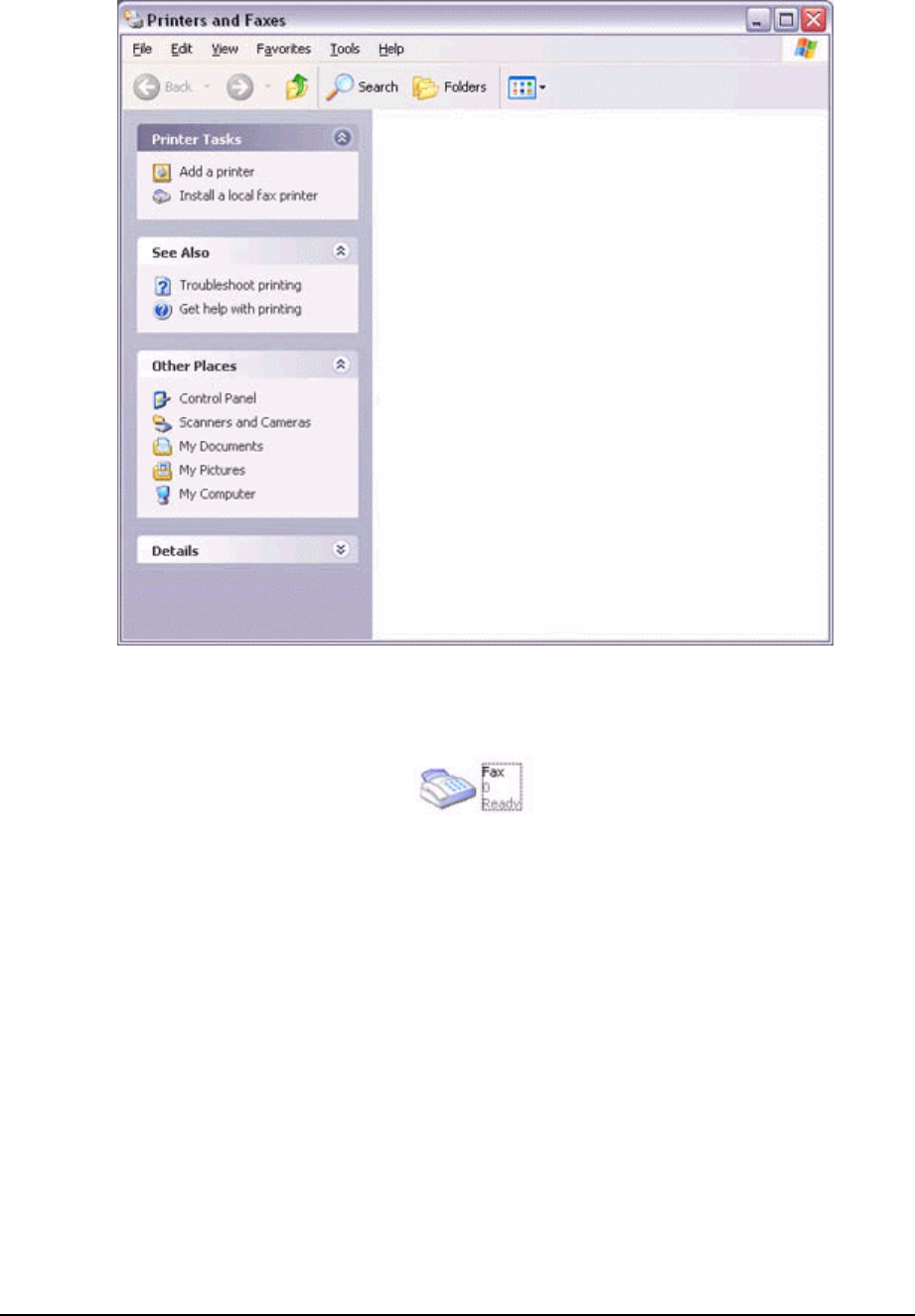
98
3. Click on "Install a local fax printer" in the [Printers and Faxes] window.
A window showing installed programs will appear, and a Fax icon will have been
created in the [Printers and Faxes] screen.
4. Click on "Send a fax" under "Printer Tasks" on the left side of the window.
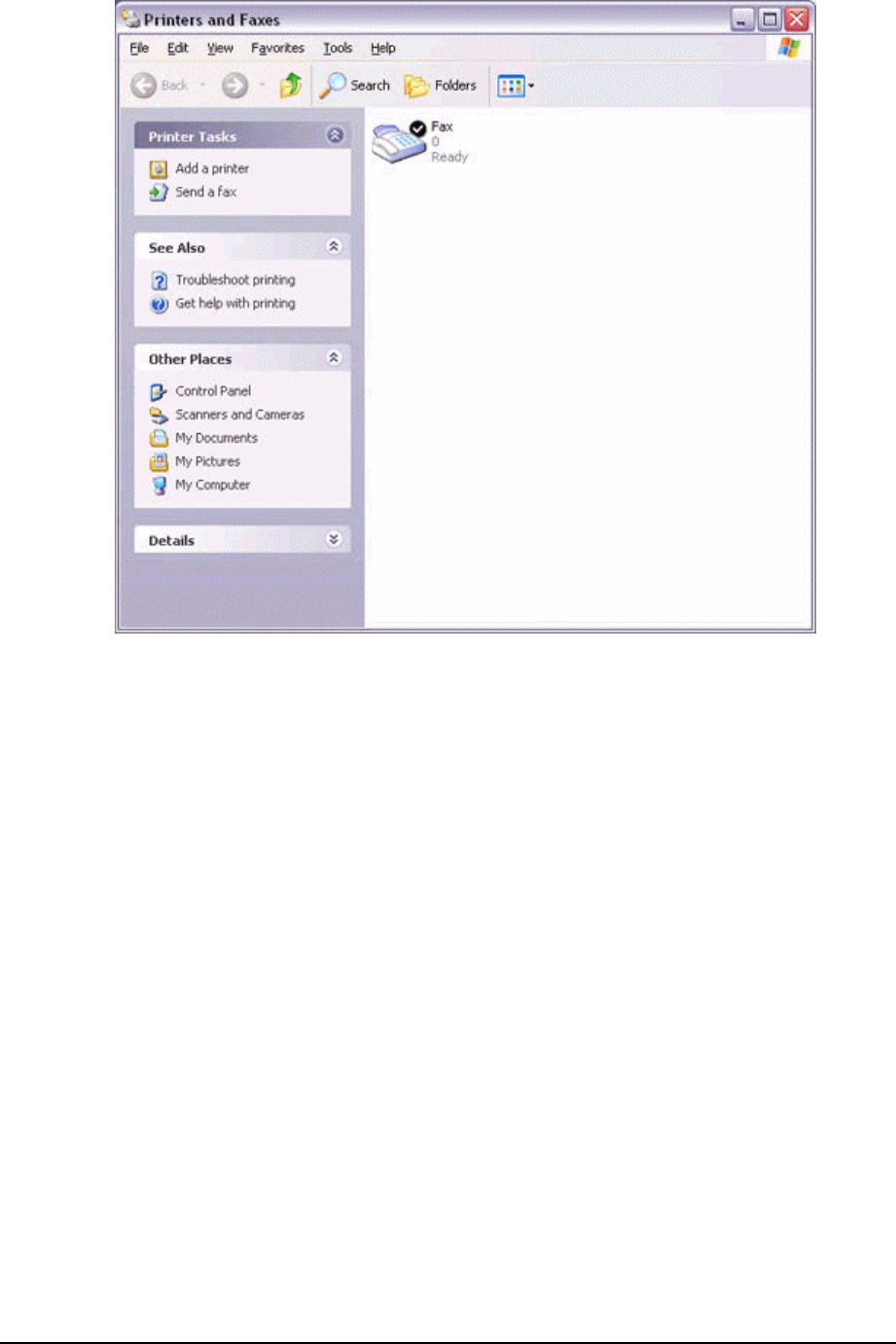
99
If you have not yet configured a fax device, the [Fax Configuration Wizard] window
will appear. In the window you can enter settings pertaining to the sender
(yourself).
Note
.If the fax configuration information has already been registered, the [Send Fax
Wizard] window, which can be viewed under "Sending a fax" below, will appear
instead of the [Fax Configuration Wizard] window.
5. Enter the sender information, and click on the [Next] button
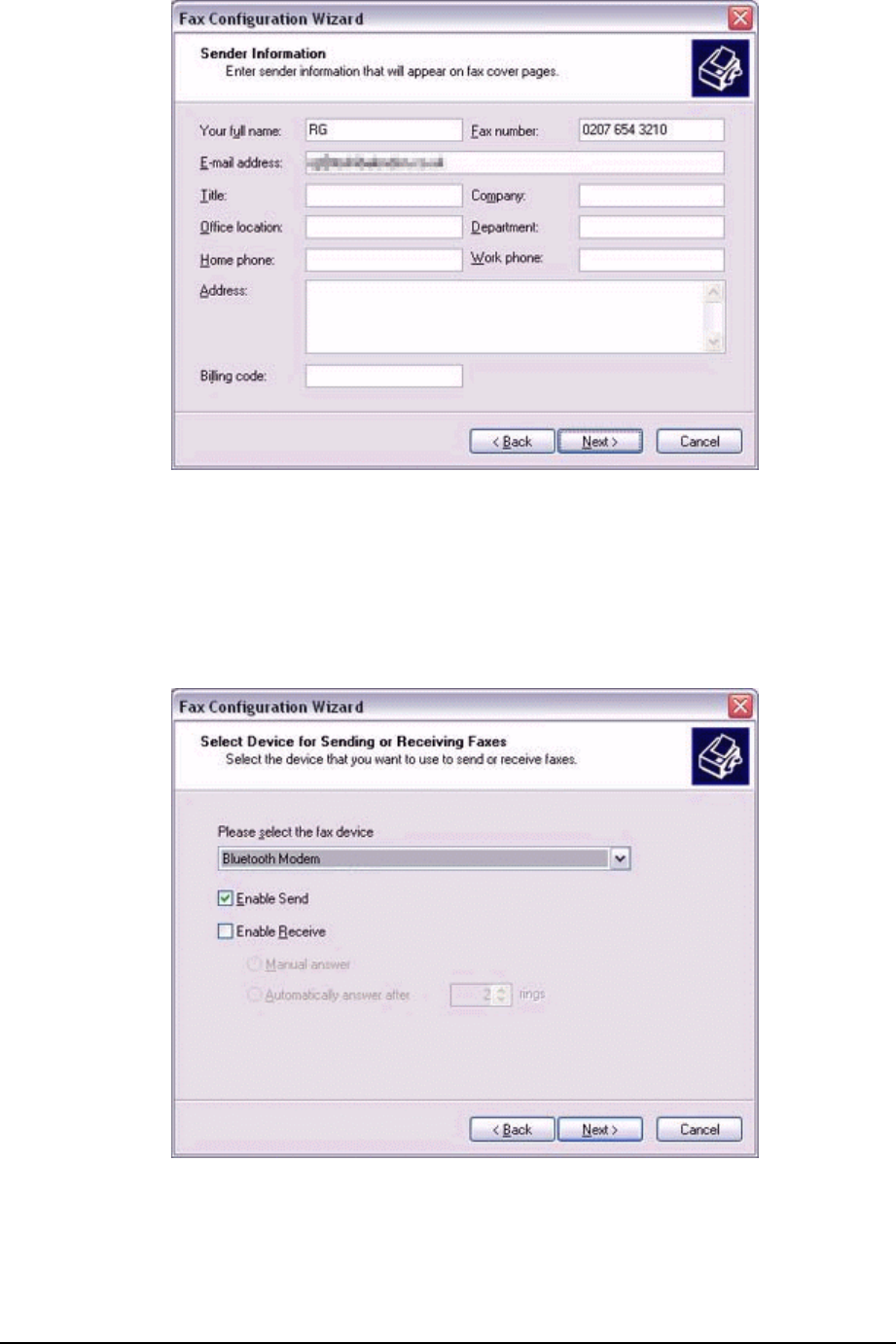
100
Note
.The sender information that you configure here will be automatically appended
as header information when you send a fax.
6. Select a device to be used for fax transmissions, enable the device for
sending or receiving, and then click on the [Next] button
Note
.If [Enable Receive] is selected, the device will be on standby for receiving faxes
even if it is not sending or receiving anything, and therefore will be in continuous
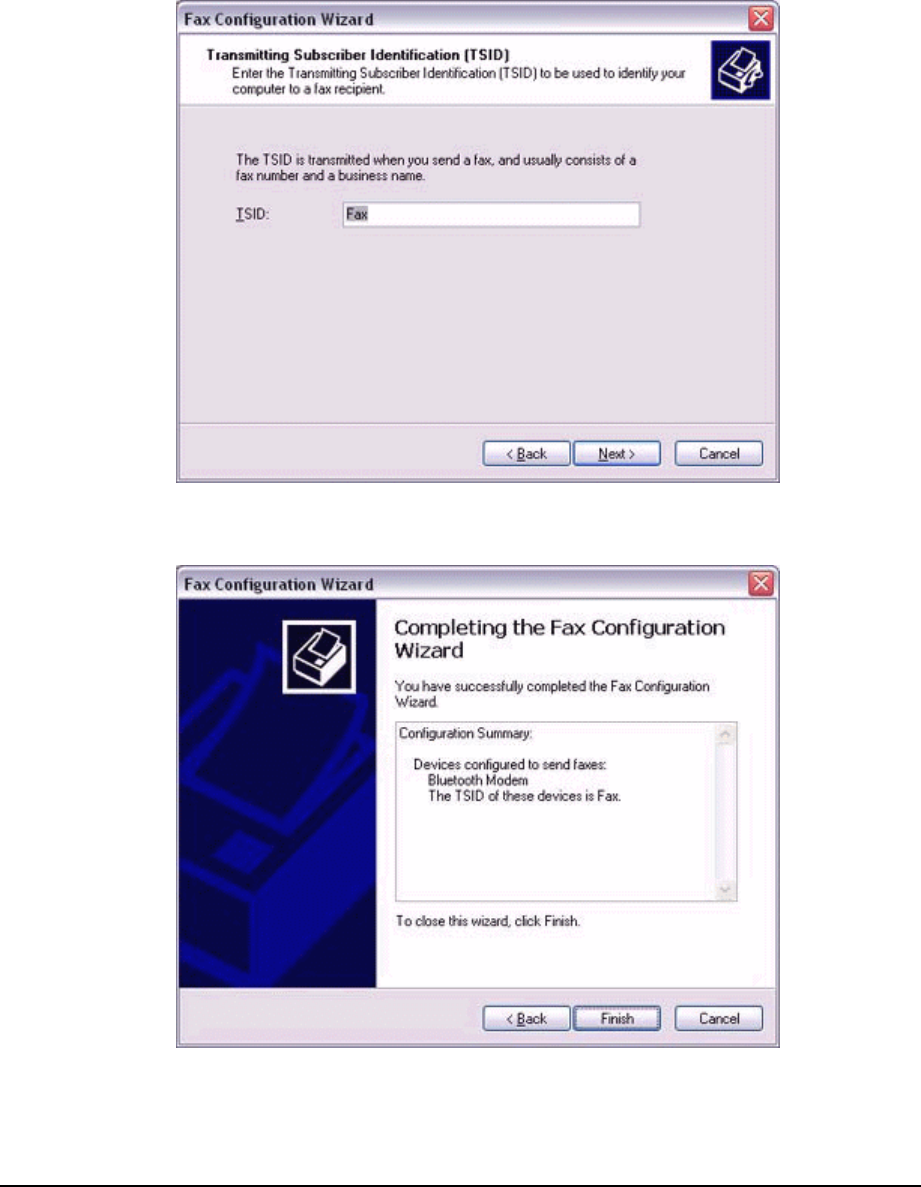
101
connection to the wireless modem (when COM Auto Connect is on).
Please decide whether to select this option based on the desired objective and/or
frequency of transmission.
7. Click on the [Next] button.
It is important that you do not change the transmitter subscriber identification.
8. Click on the [Finish] button.
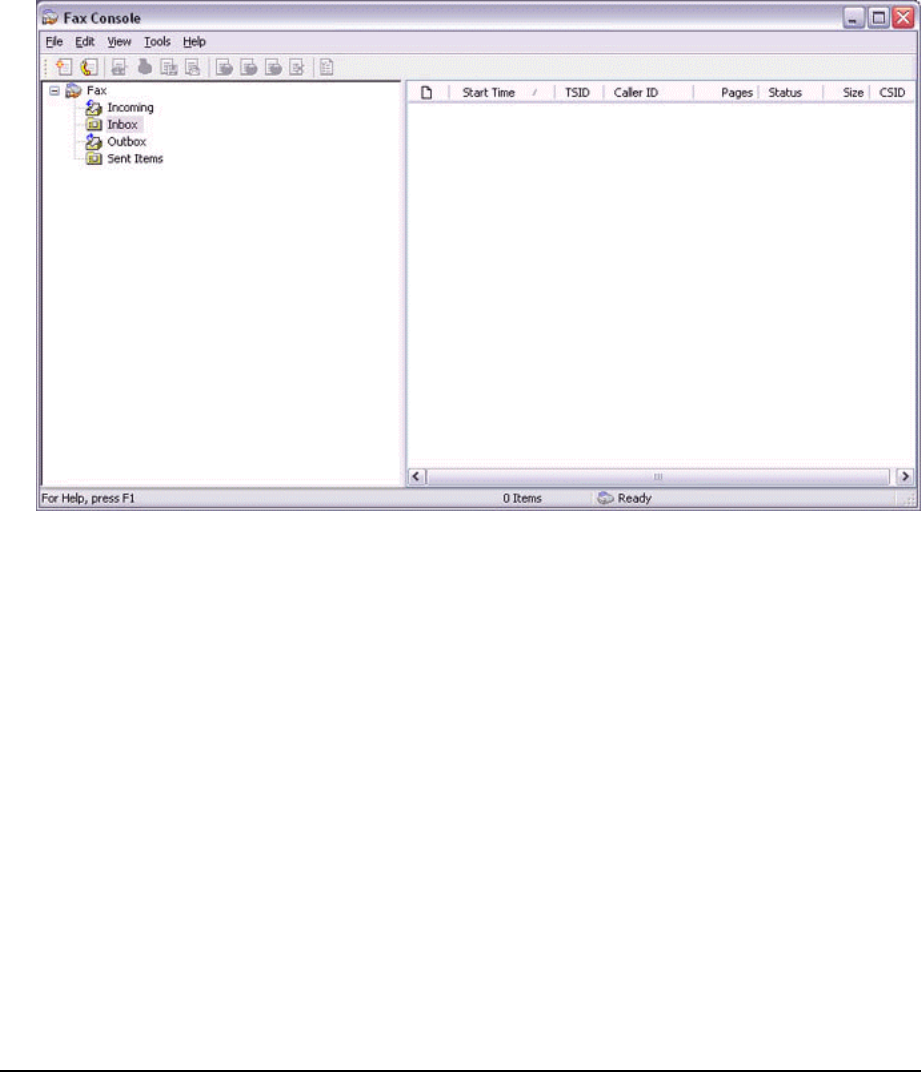
102
Setting fax information
Important
.The Fax service must be enabled for sending in order for you to send a fax.
Please refer to "Using a wireless modem station" under "Troubleshooting" for
how to change the send and receive settings once the service has been
configured.
1. Double-click on the [Fax] icon in the Control Panel.
The [Fax Console] window will appear.
2. In the [Fax Console] window, click [File]→[Send fax].
The [Send Fax Wizard (Starting the Send Fax Wizard)] window will appear.
3. Click on the [Next] button.
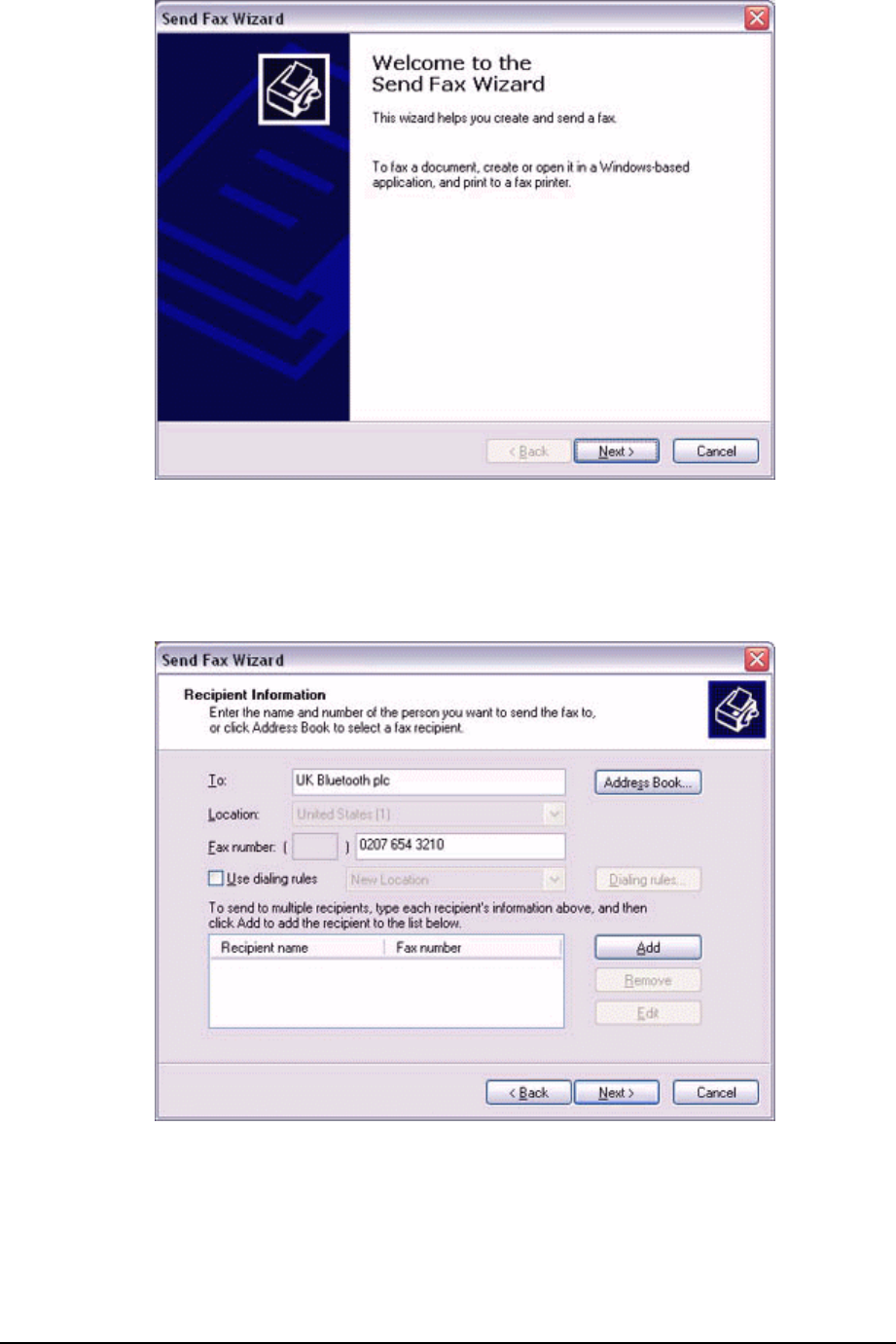
103
The [Send Fax Wizard (Recipient Information)] window will appear.
4. Enter the name and fax number of the destination party, and then click on the
[Next] button.
The [Send Fax Wizard (Preparing the Cover Page)] window will appear.
5. Specify the cover page template, subject line, and note (body text), and then
click on the [Next] button.
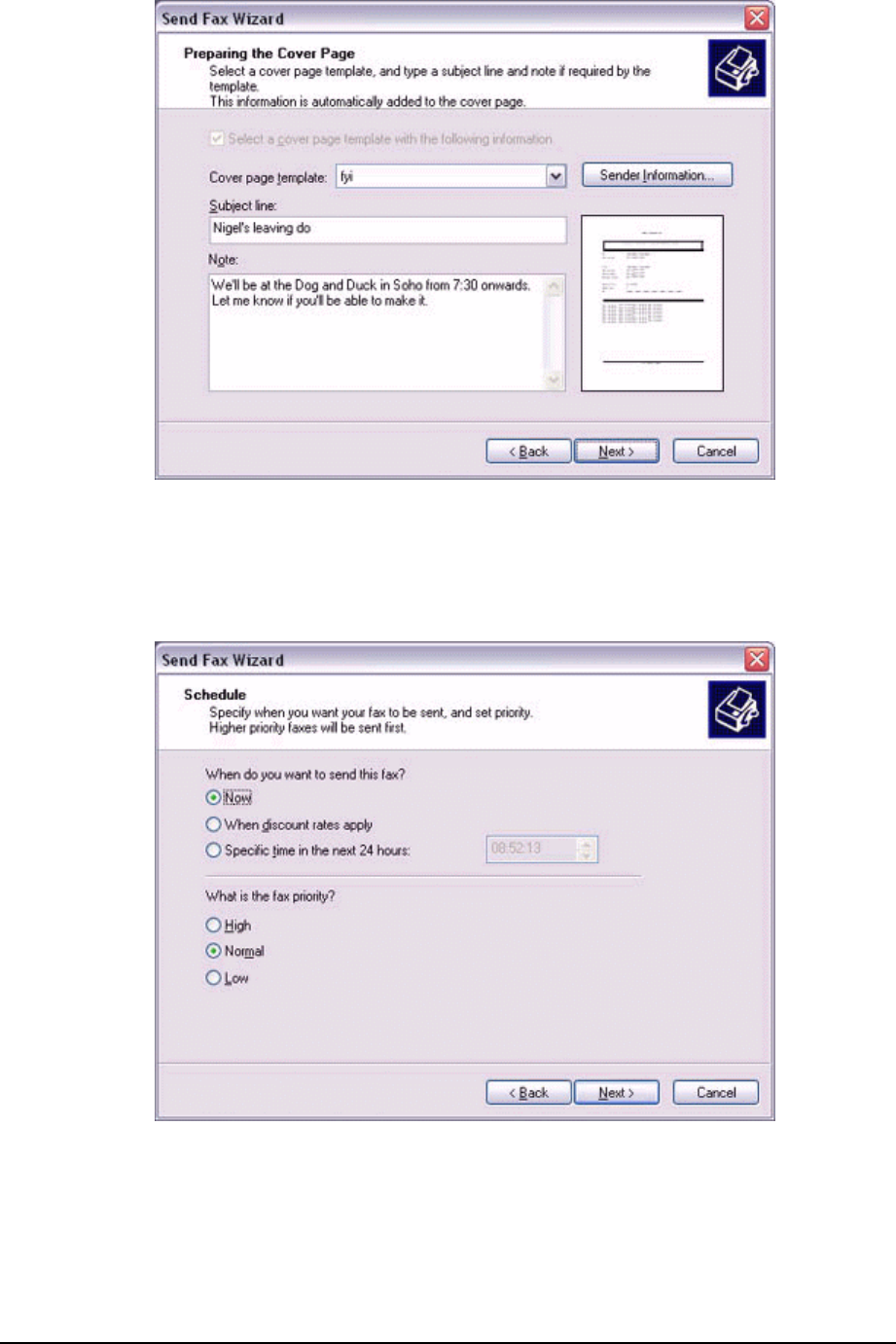
104
The [Send Fax Wizard (Schedule)] window will appear.
6. If you wish to send the fax immediately, select "Now", and then click on the
[Next] button.
The [Send Fax Wizard (Completing the Send Fax Wizard)] window will appear.
7. Confirm the destination information and transmission details, and then click
on the [Finish] button.
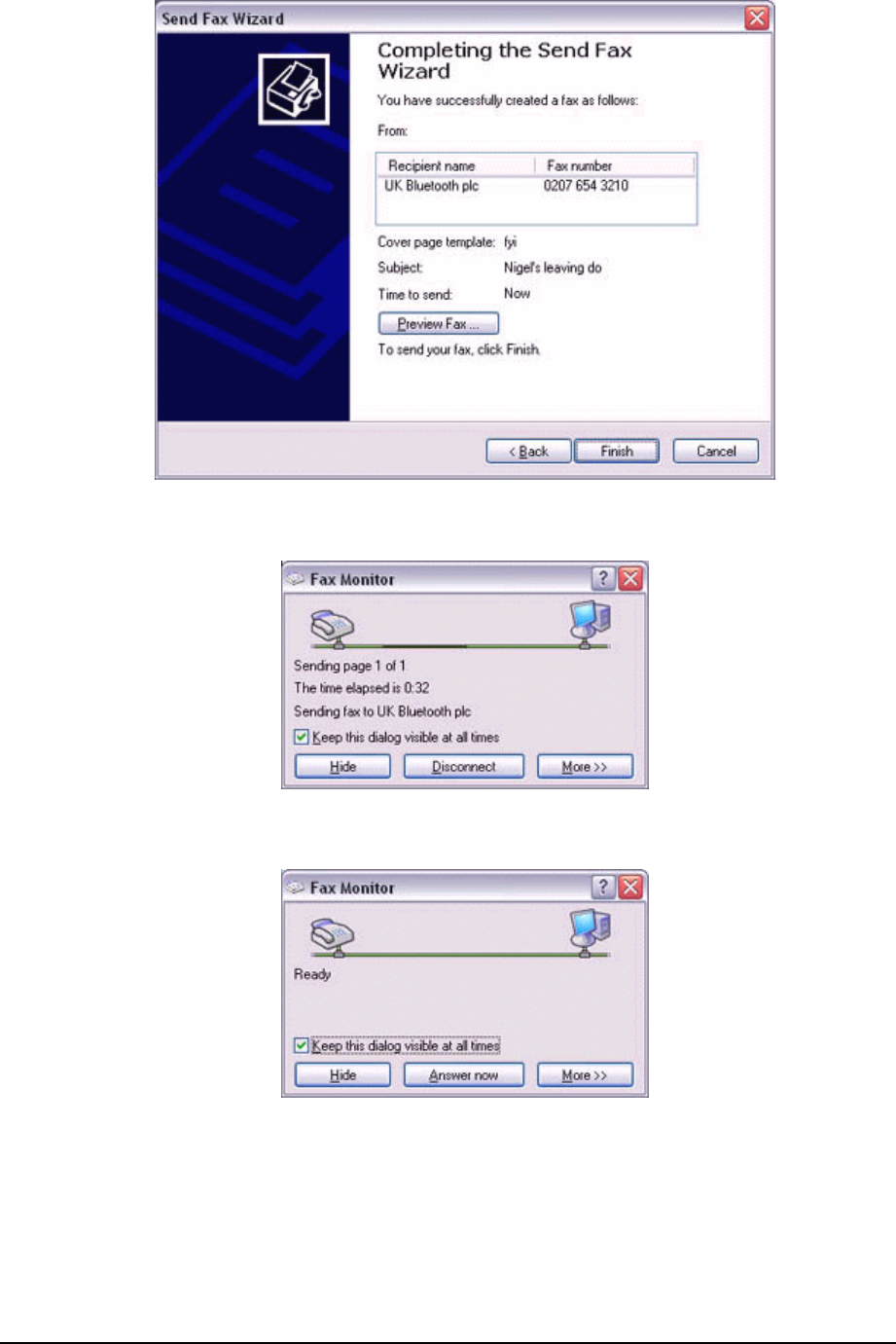
105
The software will automatically dial the number and send the fax.
Once the fax has been sent, Fax Monitor will revert to standby mode.
Receiving a fax
1. When a fax arrives, the Fax Monitor will start automatically as the fax is
received.
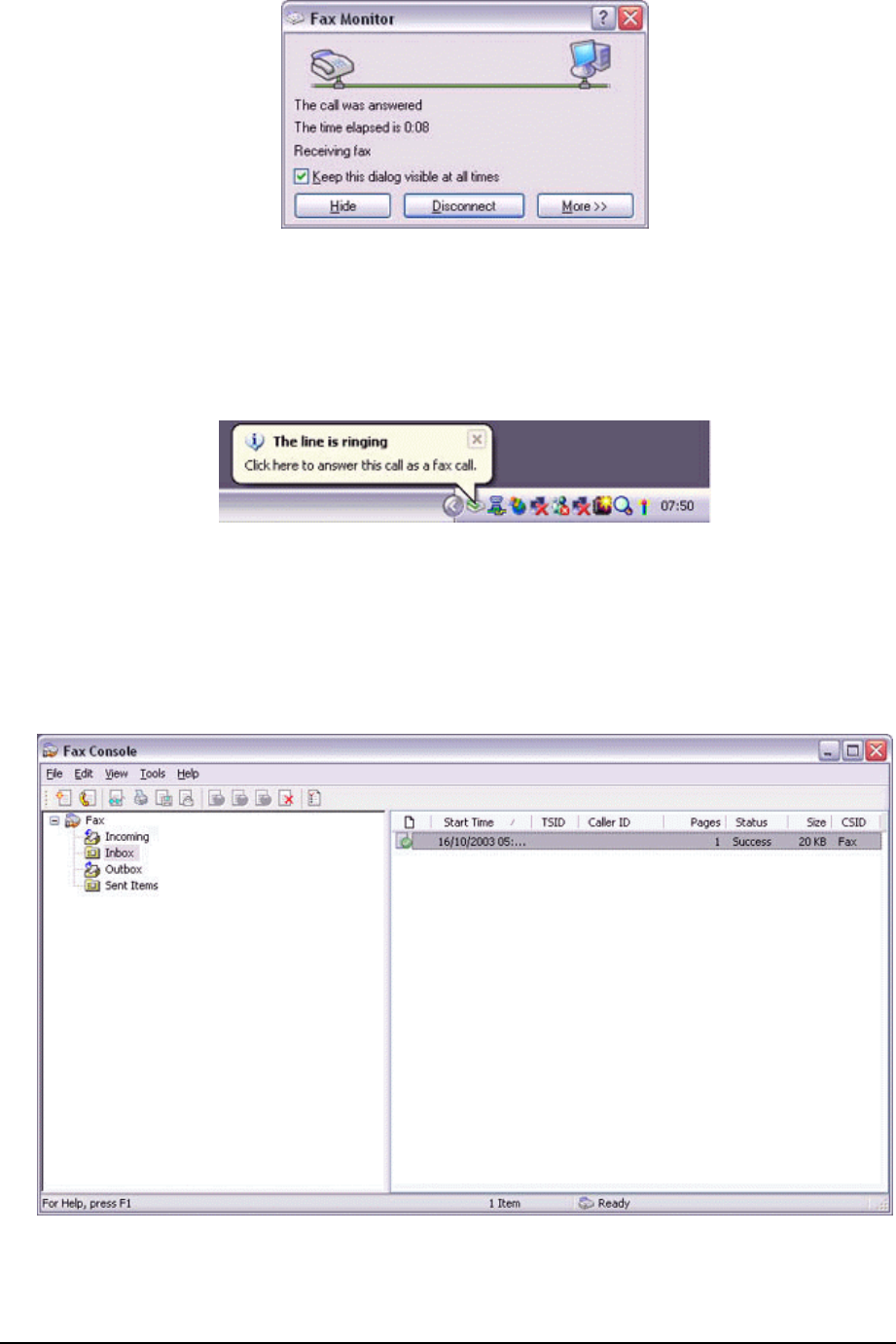
106
Once the fax has been received, the Fax Monitor will revert to standby mode.
Note
.If you have enabled manual fax reception, the message below will appear when
a fax arrives.
Click on the message with your mouse to receive the fax.
2. Double-click on the [Fax] icon in the Control Panel.
The [Fax Console] window will appear.
3. In the [Fax Console] window, double-click on the fax that has arrived.
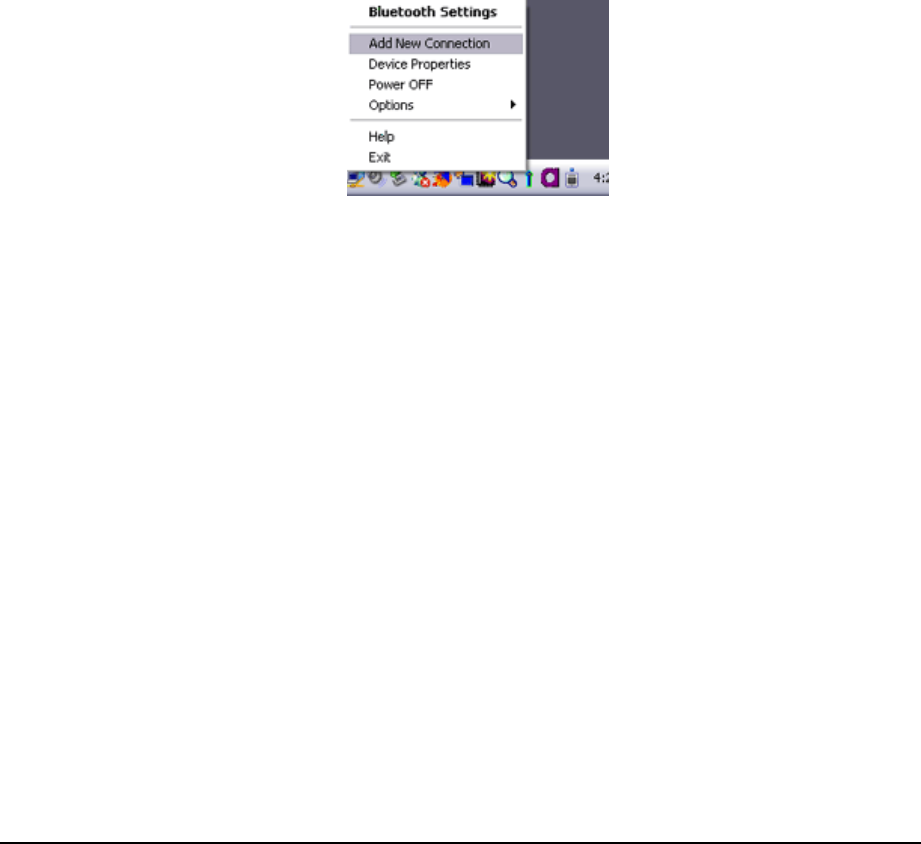
107
4.6.2 Using a mobile telephone for fax transmission
Important
.Please ensure that any drivers used to connect the PC to the mobile telephone
have been installed.
.Bluetooth passkey (PIN code) is required for you to connect to the mobile
telephone. Please make a note of your Bluetooth passkey before you start the
set-up process.
.A fax application is required for you to be able to send and receive faxes. The
description below is based on a example using Microsoft Fax, which is installed
with Windows XP as standard.
Setting up the mobile telephone
1. Turn on the mobile telephone, and set it to be connectable via Bluetooth.
2. Right-click on the Bluetooth icon in the task tray, and then click on [Add New
Connection].
Note
.Alternatively, click [Start]→[All Programs]→[Bluetooth]→[Bluetooth Settings],
and then click on [New Connection] from the active [Bluetooth Settings] window.
The [Add New Connection Wizard (Welcome to the Add New Connection
Wizard)] window will appear.
3. Select [Custom Mode], and then click on the [Next] button.
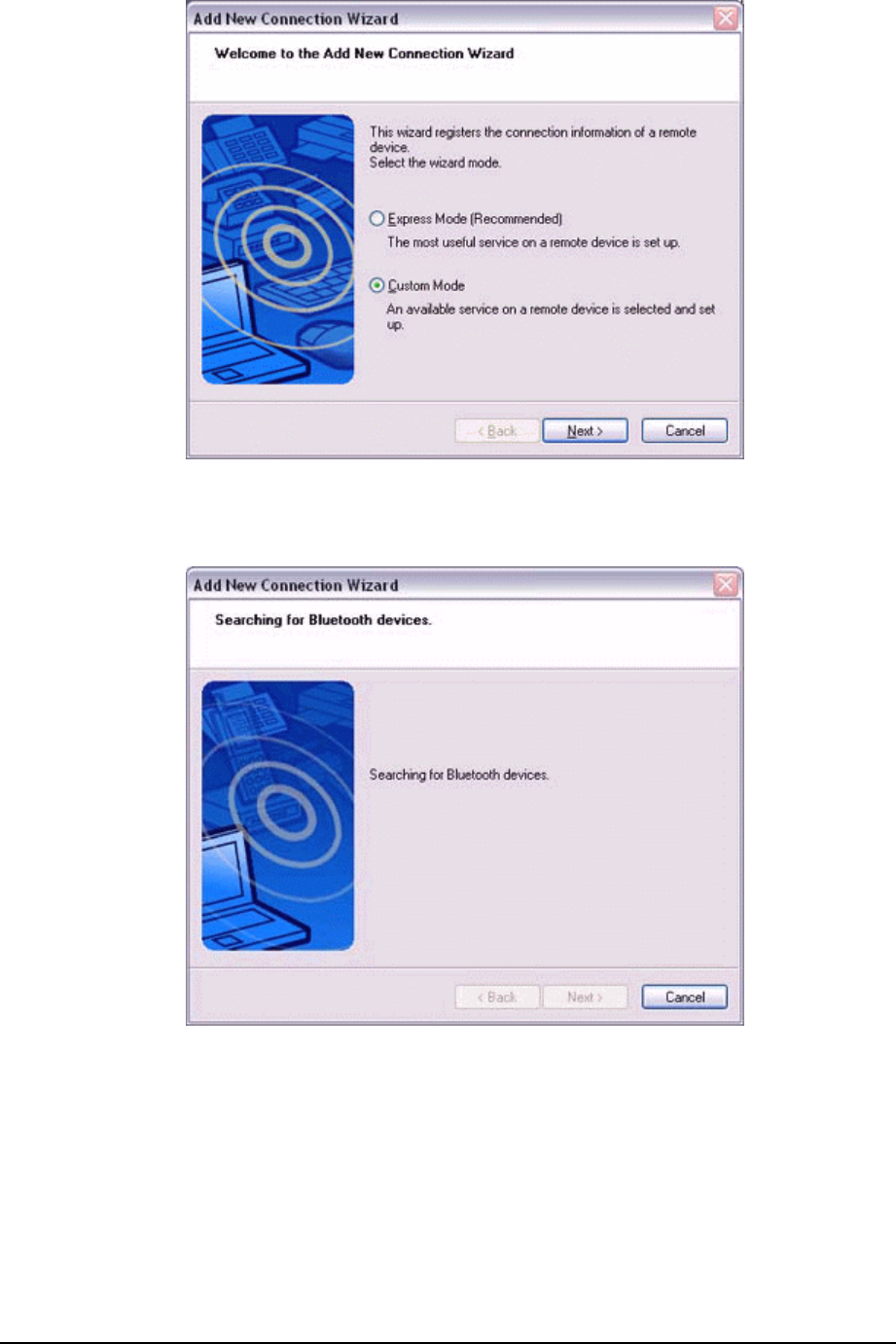
108
The [Add New Connection Wizard (Searching for Bluetooth devices)] window will
appear.
Once the program has finished searching for the devices, the [Add New
Connection Wizard (Select Device)] window will appear.
4. Select the device name of the mobile telephone from [Device List], and then
click on the [Next] button.
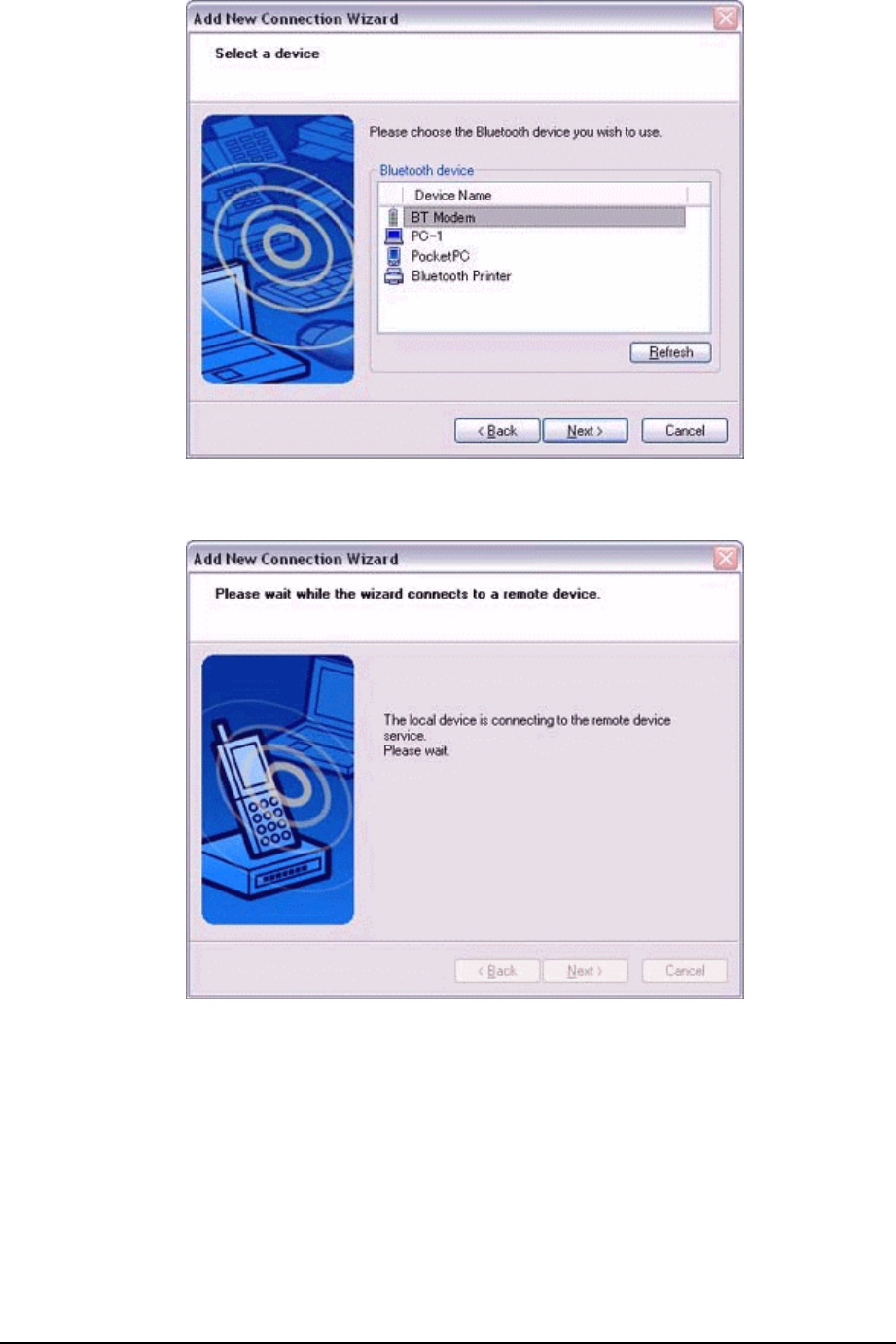
109
The [Add New Connection Wizard (Searching for Services)] window will appear.
5. If you are connecting to the mobile telephone for the first time, enter the
passkey for the device from the [Bluetooth Passkey (PIN Code)] window, and
then click on the [OK] button.
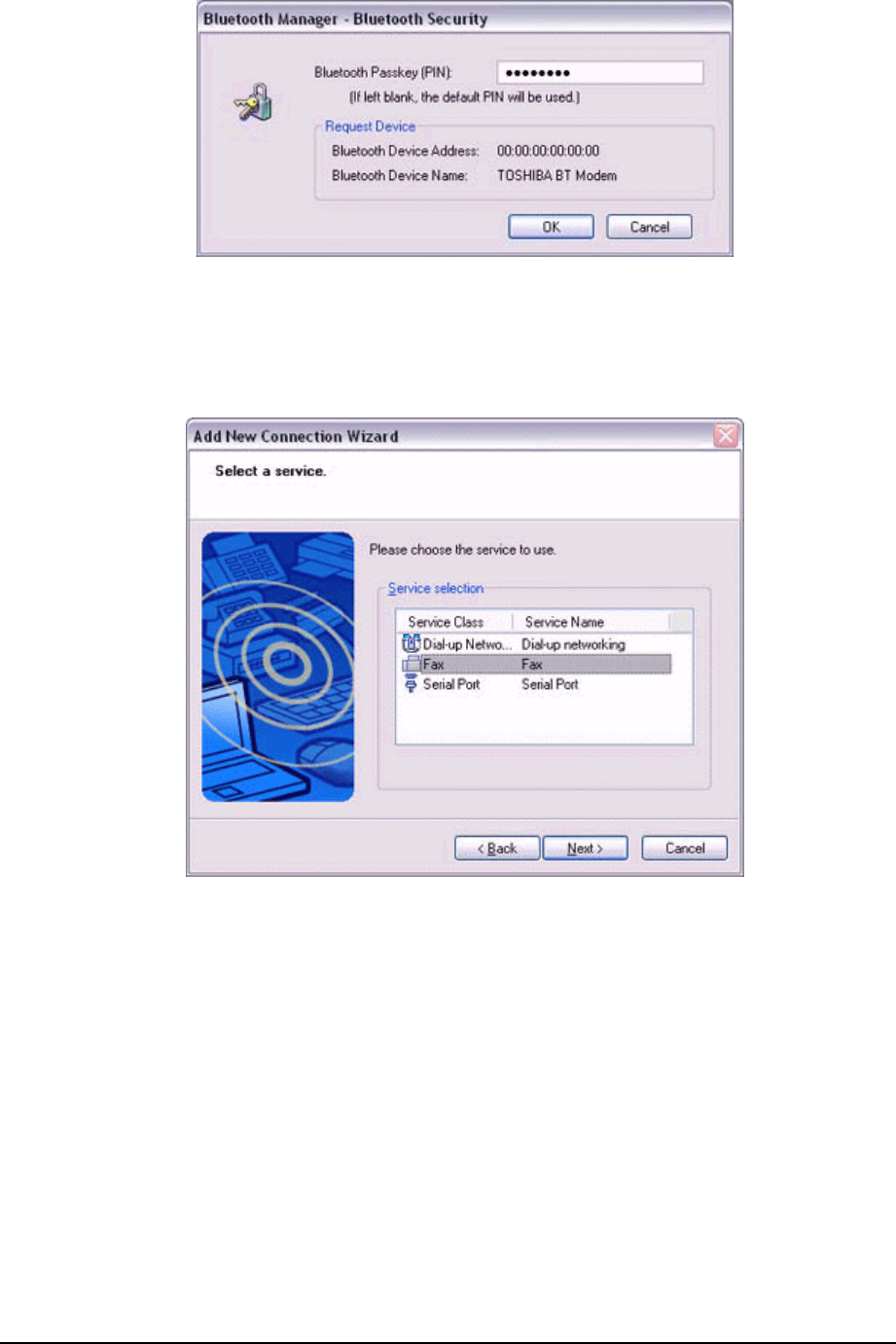
110
Once the program has finished searching for the services, the [Add New
Connection Wizard (Select Service)] window will appear.
6. Select "Fax" under [Select Service], and then click on the [Next] button.
The [Add New Connection Wizard (Select COM Port)] window will appear.
7. Check [Use default COM port], and then click on the [Next] button.
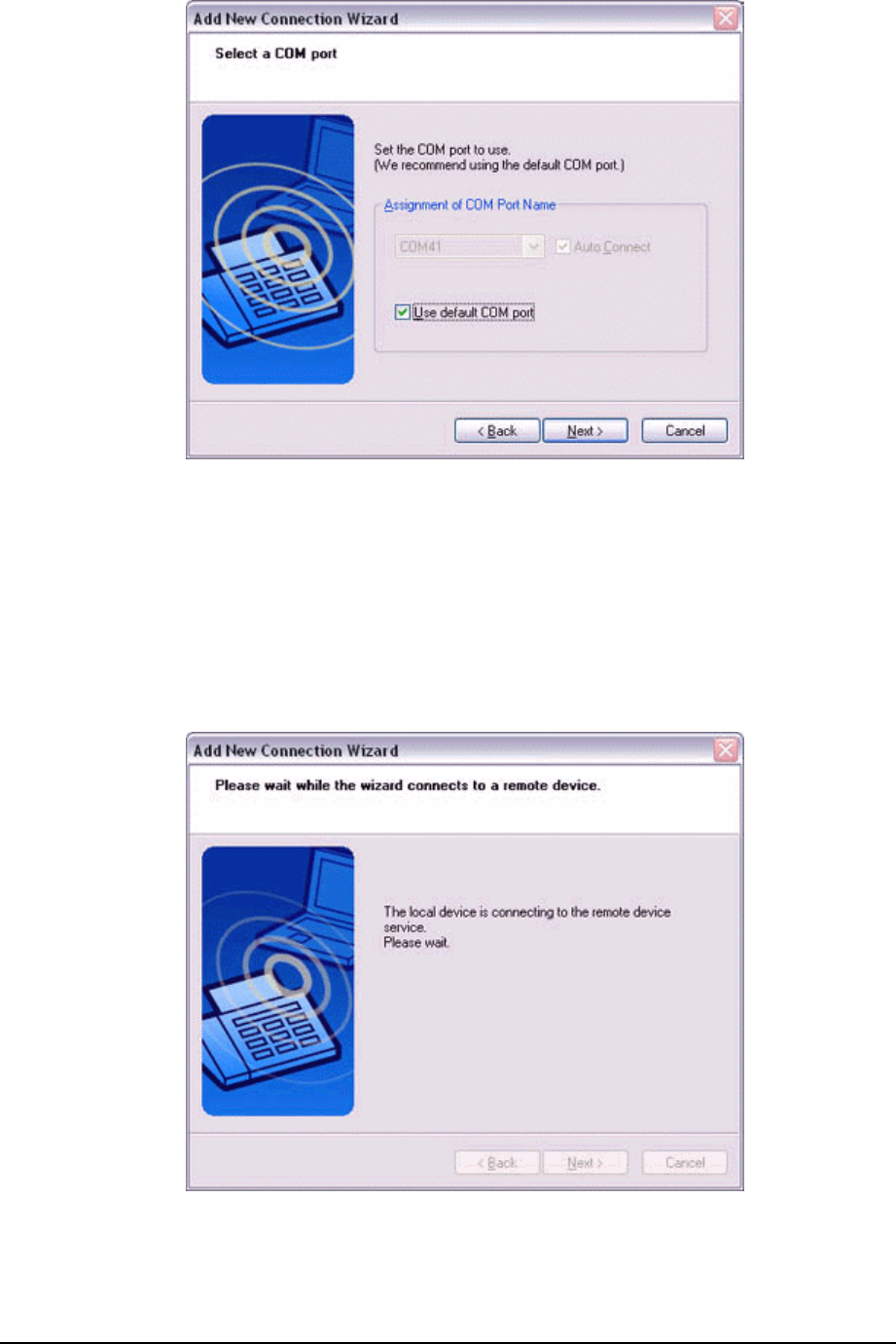
111
Note
.The mobile telephone will be installed to the grayed-out COM port displayed
under [Assignment of COM Port] in this window. You will be specifying this COM
port in Step (3) of "●Installing a Modem", so please write it down for future
reference.
The [Add New Connection Wizard (Connecting to Remote Device)] window will
appear.
The [Add New Connection Wizard (Modem Settings)] and [Phone and Modem
Options] windows will appear.
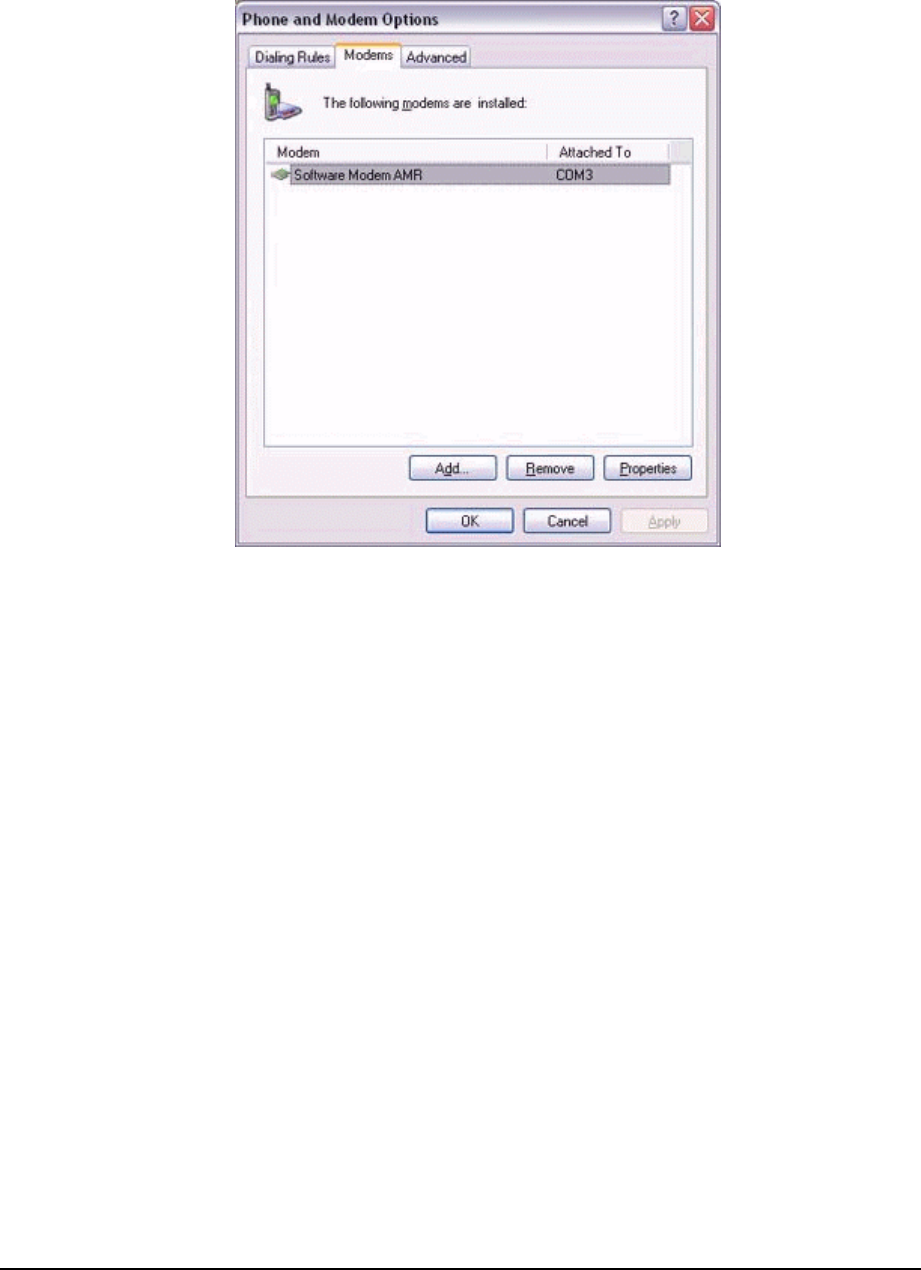
112
8. Click on the "Add..." button in the [Phone and Modem Options] window.
The [Add New Hardware Wizard (Install New Modem)] window will appear.
Install the modem by following the instructions in the windows that follow.
Installing a modem
The [Add New Hardware Wizard (Install New Modem)] window will appear.
1. Check [Don't detect my modem; I will select it from a list], and then click on
the [Next] button.
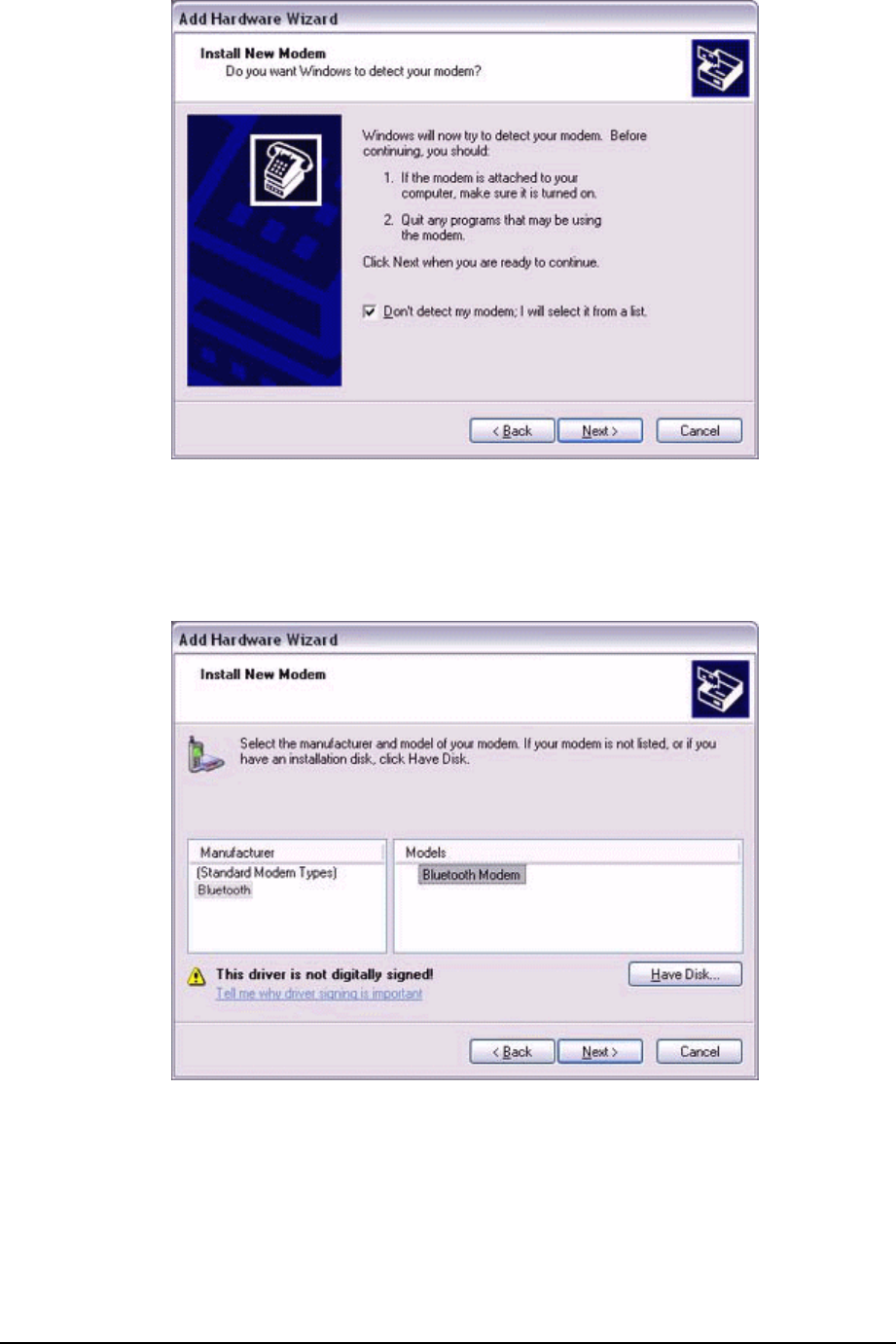
113
A list of modem manufacturers and models will appear.
2. Select the desired mobile telephone from under [Manufacturer] and [Models],
and then click on the [Next] button.
Note
.If you have not yet installed a mobile telephone driver, click on the "Use Device"
button to install one from this window.
.If no mobile telephone drivers appear, please select "(Standard Modem Types)"
and "Standard 33600 bps modem."
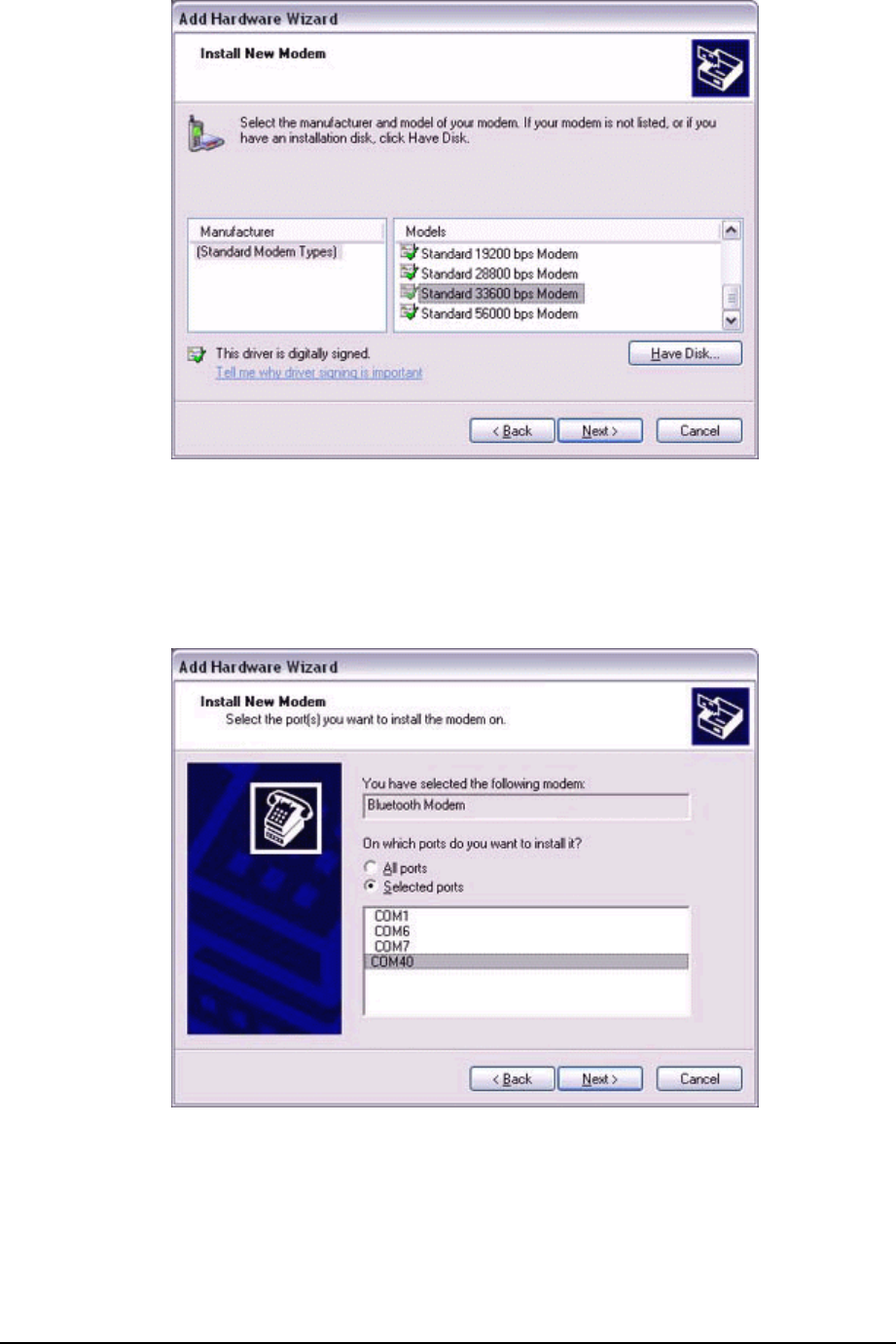
114
A window will appear where you can specify the port to which you can install the
modem.
3. Select "Selected Port", specify the COM port to which the modem will be
installed, and then click on the [Next] button.
Important
.Please specify the COM port displayed in the window pertaining to Step (7)
under "●Setting up the modem station."
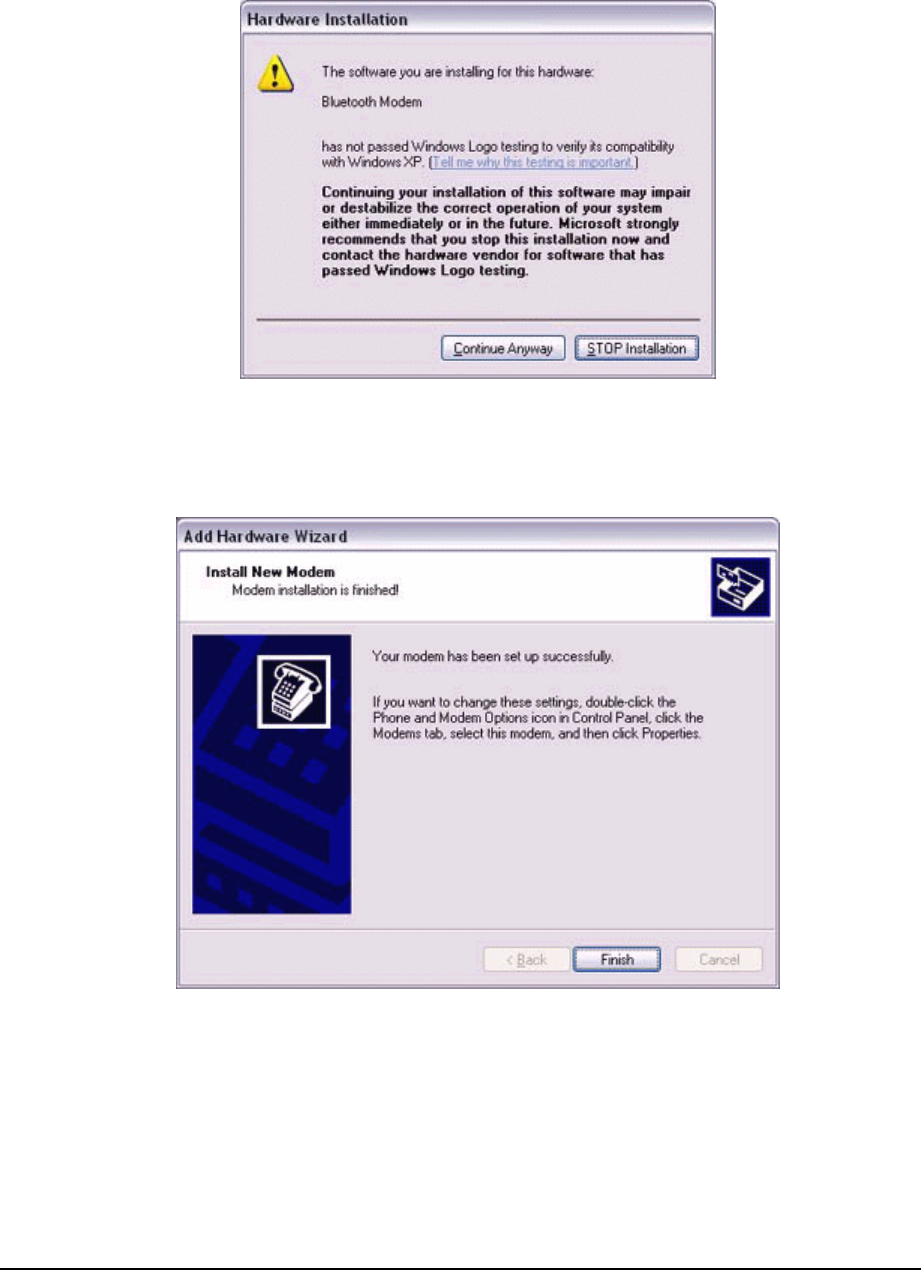
115
4. Click on the [Continue] button.
The wizard will display the following window by design, but you may disregard it
and click on the "Continue" button.
A window will appear indicating that the modem installation is complete.
5. Click on the [Finish] button.
6. Confirm that the configured modem has been added to the list in the [Phone
and Modem Options] window, and then click on the [OK] button.
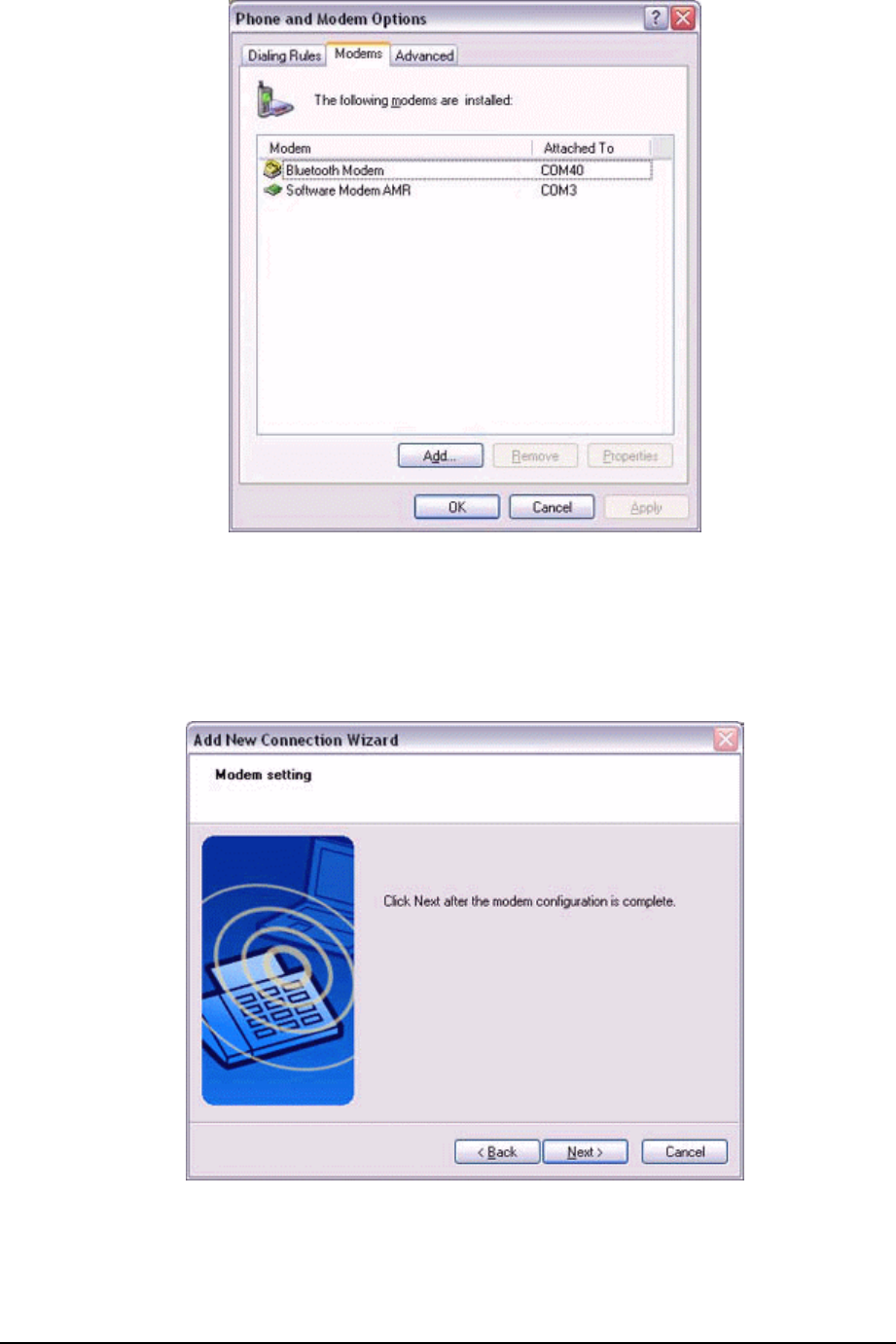
116
The [Next] button will be enabled on the [Add New Connection Wizard (Modem
Settings)] window.
7. Click on the [Next] button on the [Add New Connection Wizard (Modem
Settings)] window.
The [Add New Connection Wizard (Connection Name Settings)] window will
appear.
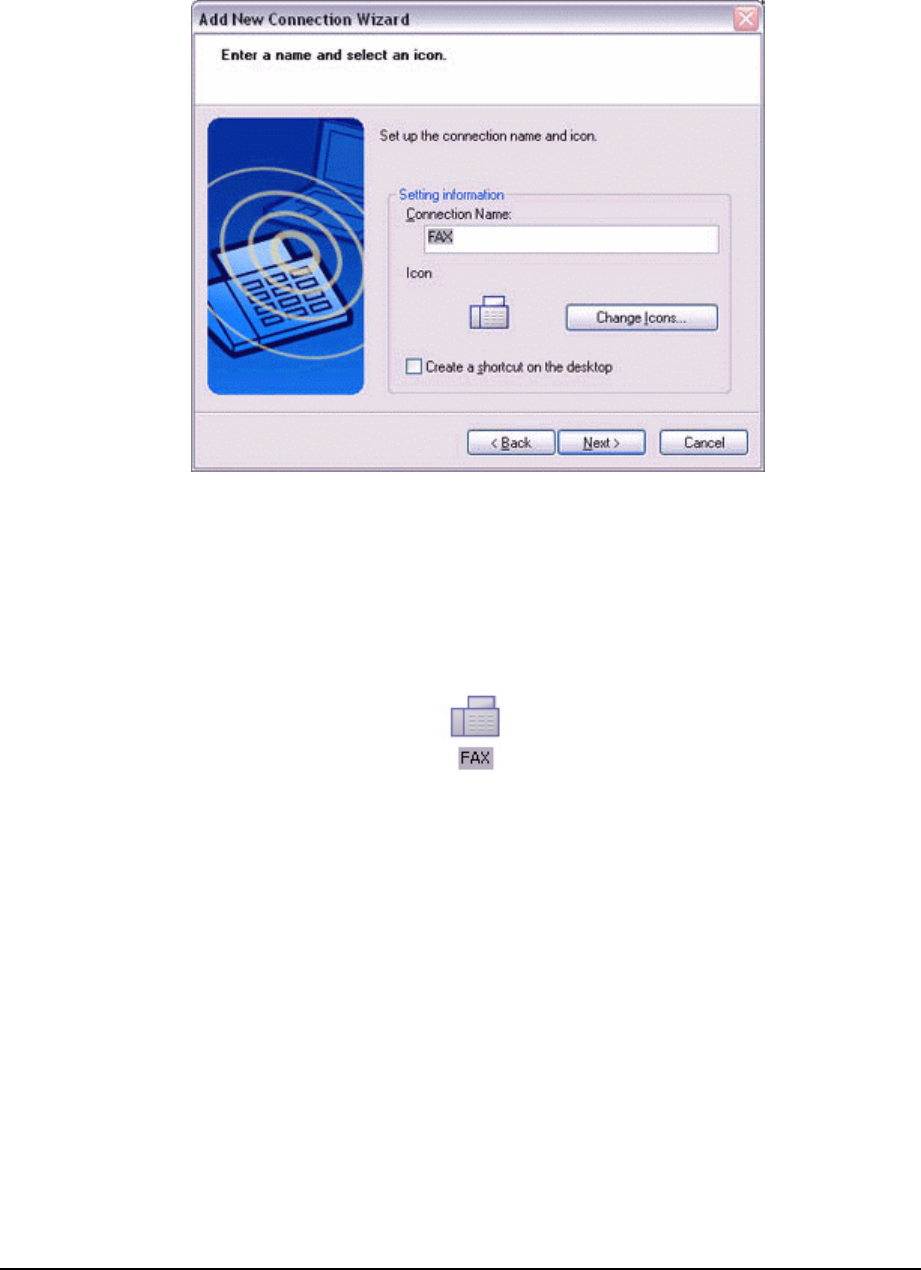
117
8. Enter the type and name of the icon displayed after registration, and then
click on the [Next] button.
Please click on the [Next] button if you are satisfied with the settings.
The [Add New Connection Wizard (Completing the Add New Connection Wizard)]
window will appear.
9. Click on the [Finish] button.
The settings will be registered, and the icon will appear in the [Bluetooth Settings]
window.
Setting fax information
Configure send/receive settings and register fax information.
1. Select [Start]Æ[Control Panel], and then double-click on the [Printers and
Other Hardware] icon .
Note
.If the control panel is displayed in "Classic view", and you use Windows 2000,
please start from Step (2).
2. Double-click on the [Printers and Faxes] icon.
The [Printers & Faxes] window will appear.
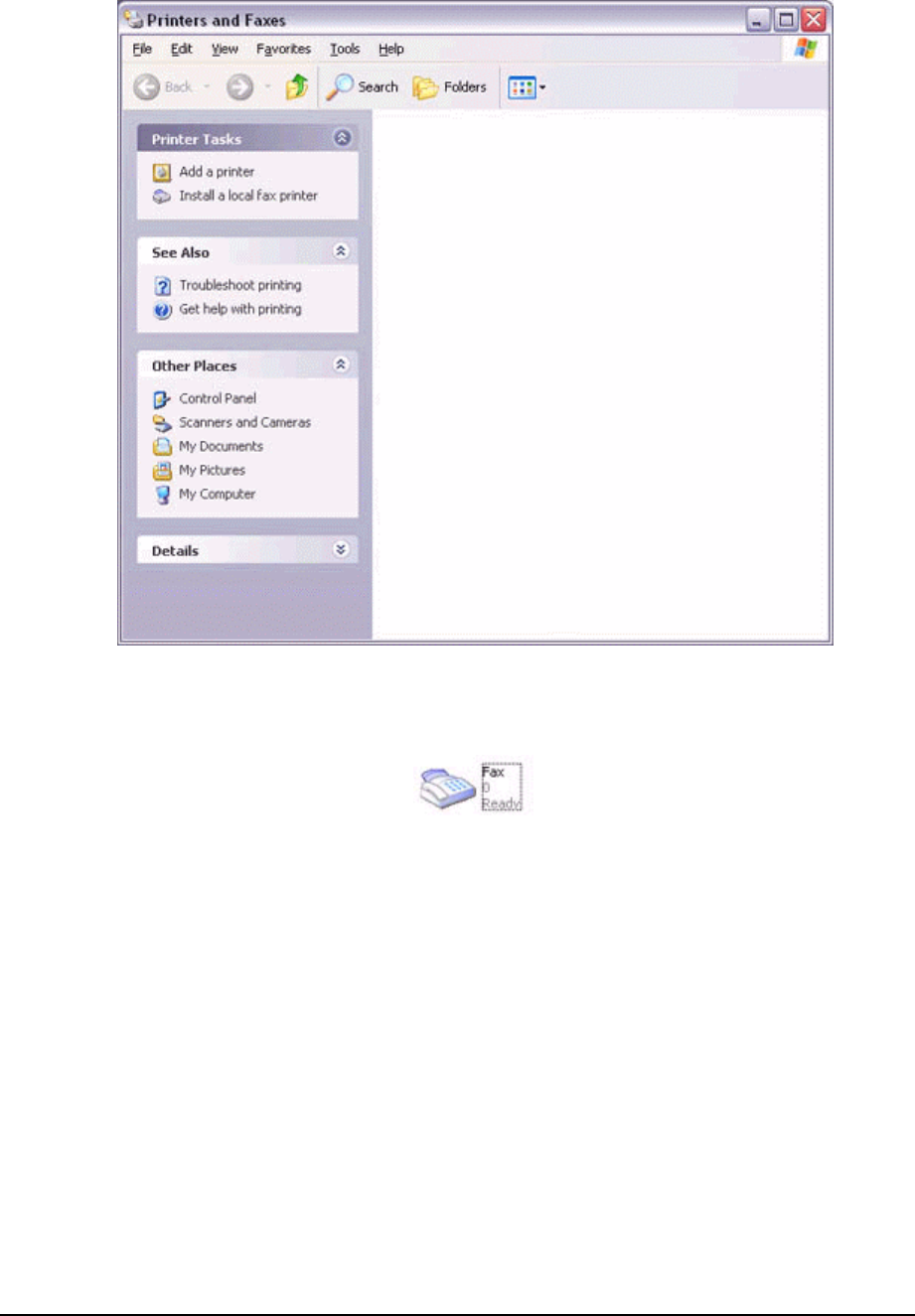
118
3. Click on "Install a local fax printer" in the [Printers and Faxes] window.
A window showing installed programs will appear, and a Fax icon will have been
created in the [Printers and Faxes] screen.
4. Click on "Send a fax" under "Printer Tasks" on the left side of the window.
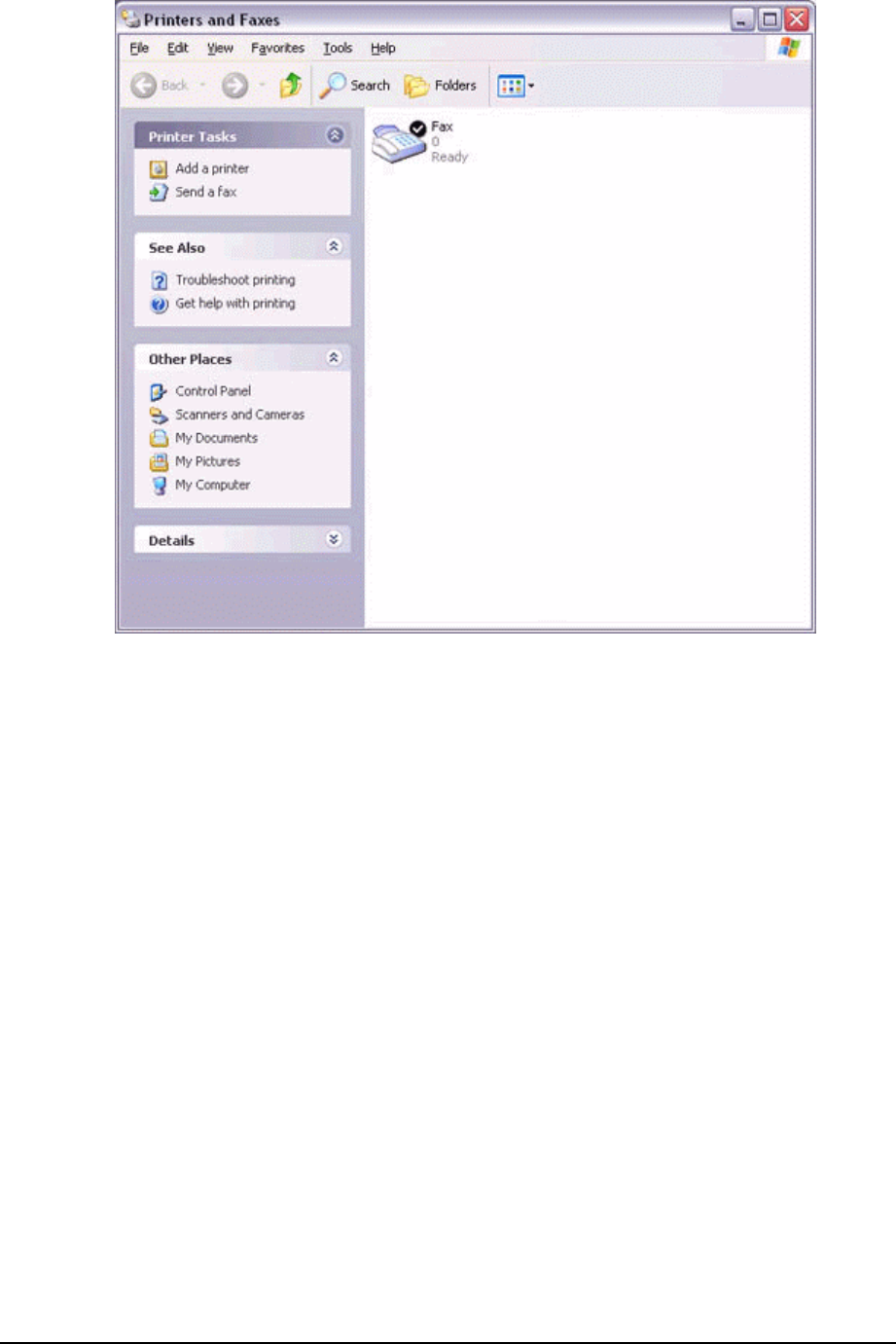
119
If you have not yet configured a fax device, the [Fax Configuration Wizard] window
will appear. In the window you can enter settings pertaining to the sender
(yourself).
Note
.If the fax configuration information has already been registered, the [Send Fax
Wizard] window, which can be viewed under "Sending a fax" below, will appear
instead of the [Fax Configuration Wizard] window.
5. Enter the sender information, and click on the [Next] button
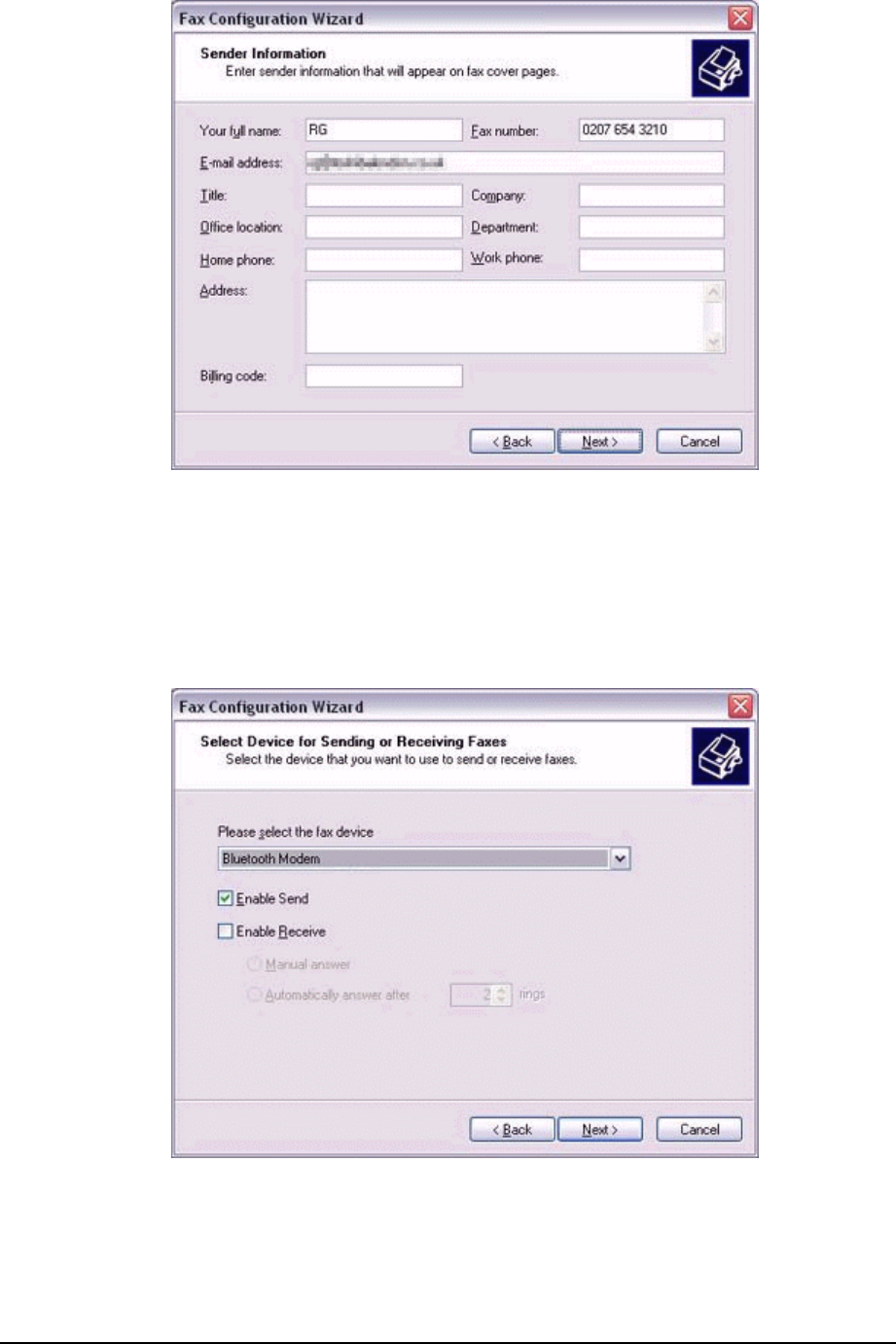
120
Note
.The sender information that you configure here will be automatically appended
as header information when you send a fax.
6. Select a device to be used for fax transmissions, enable the device for
sending or receiving, and then click on the [Next] button
Note
.If [Enable Receive] is selected, the device will be on standby for receiving faxes
even if it is not sending or receiving anything, and therefore will be in continuous
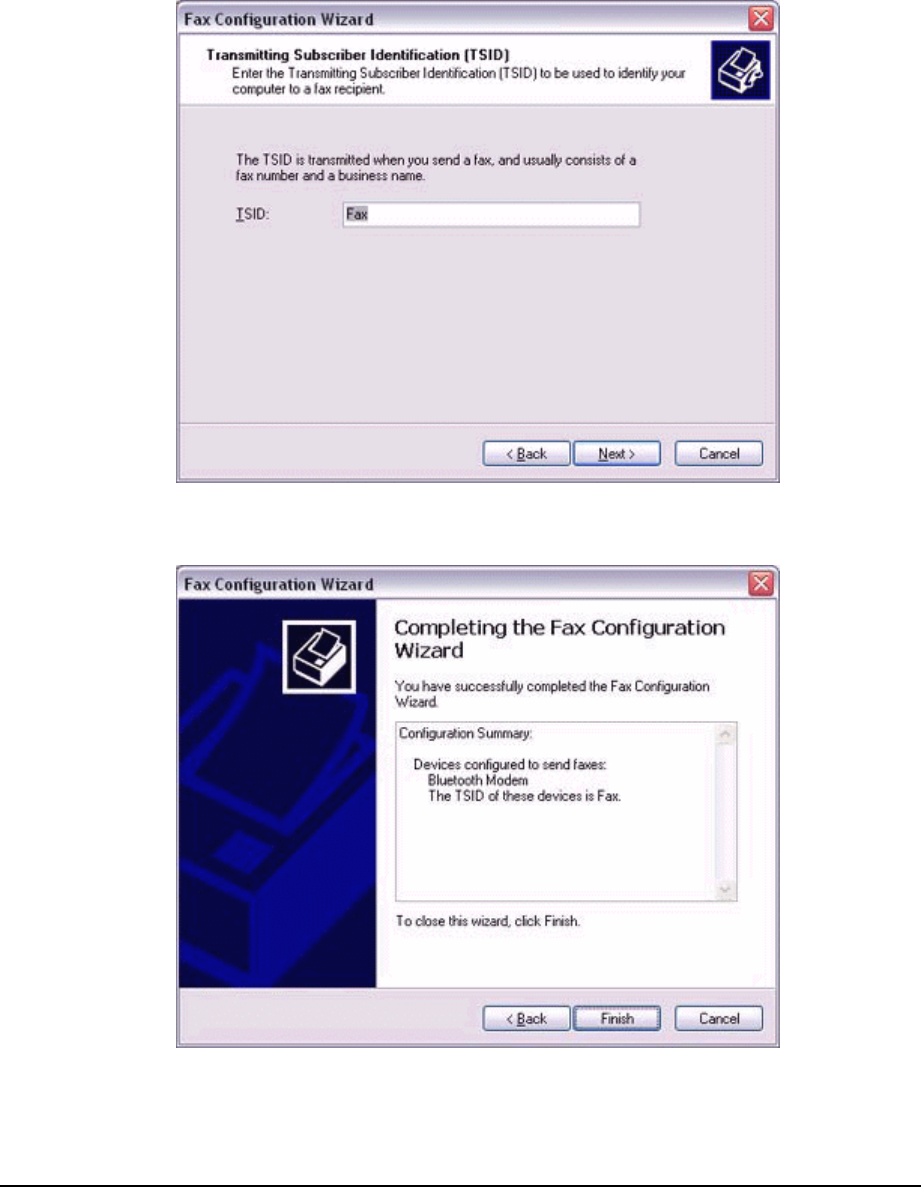
121
connection to the wireless modem (when COM Auto Connect is on).
Please decide whether to select this option based on the desired objective and/or
frequency of transmission.
7. Click on the [Next] button.
It is important that you do not change the transmitter subscriber identification.
8. Click on the [Finish] button.
Please refer to the same procedure of “Sending a fax” and “receiving a fax” in the “using a
modem station for transmission” section.
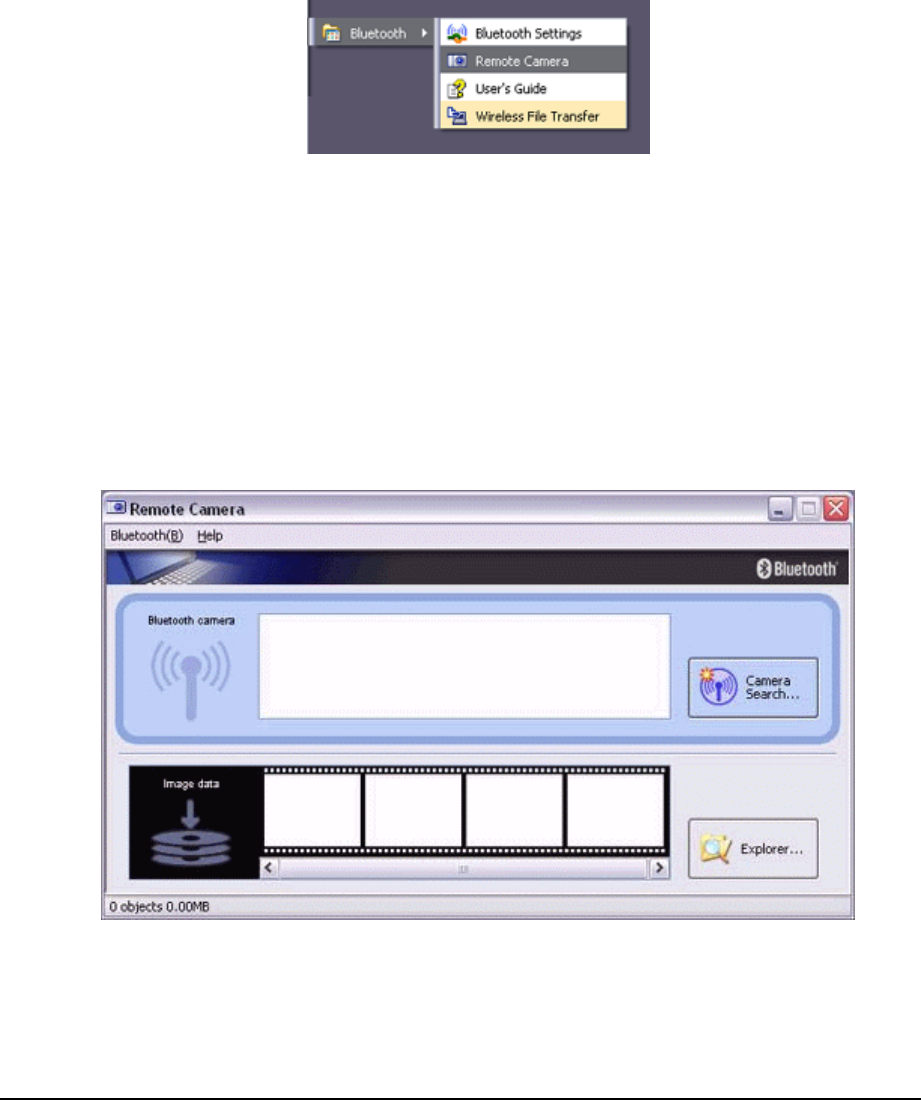
122
4.7 Using a Bluetooth-compatible camera
Connecting the camera
1. Click on [Start ]Æ[All Programs]Æ[Bluetooth]Æ[Remote Camera].
Note
.In Windows 2000, click on [Start]→[Programs]→[Bluetooth]→[Remote
Camera].
The [Remote Camera] window will appear.
2. Turn on the camera, and set it to be connectable via Bluetooth.
Note
.Different cameras are operated in different ways, depending on the
manufacturer and model used. Please refer to the instruction manual for further
details on how to operate your camera.
3. Click on the [Camera Search...] button.
The camera will be detected and its icon displayed.
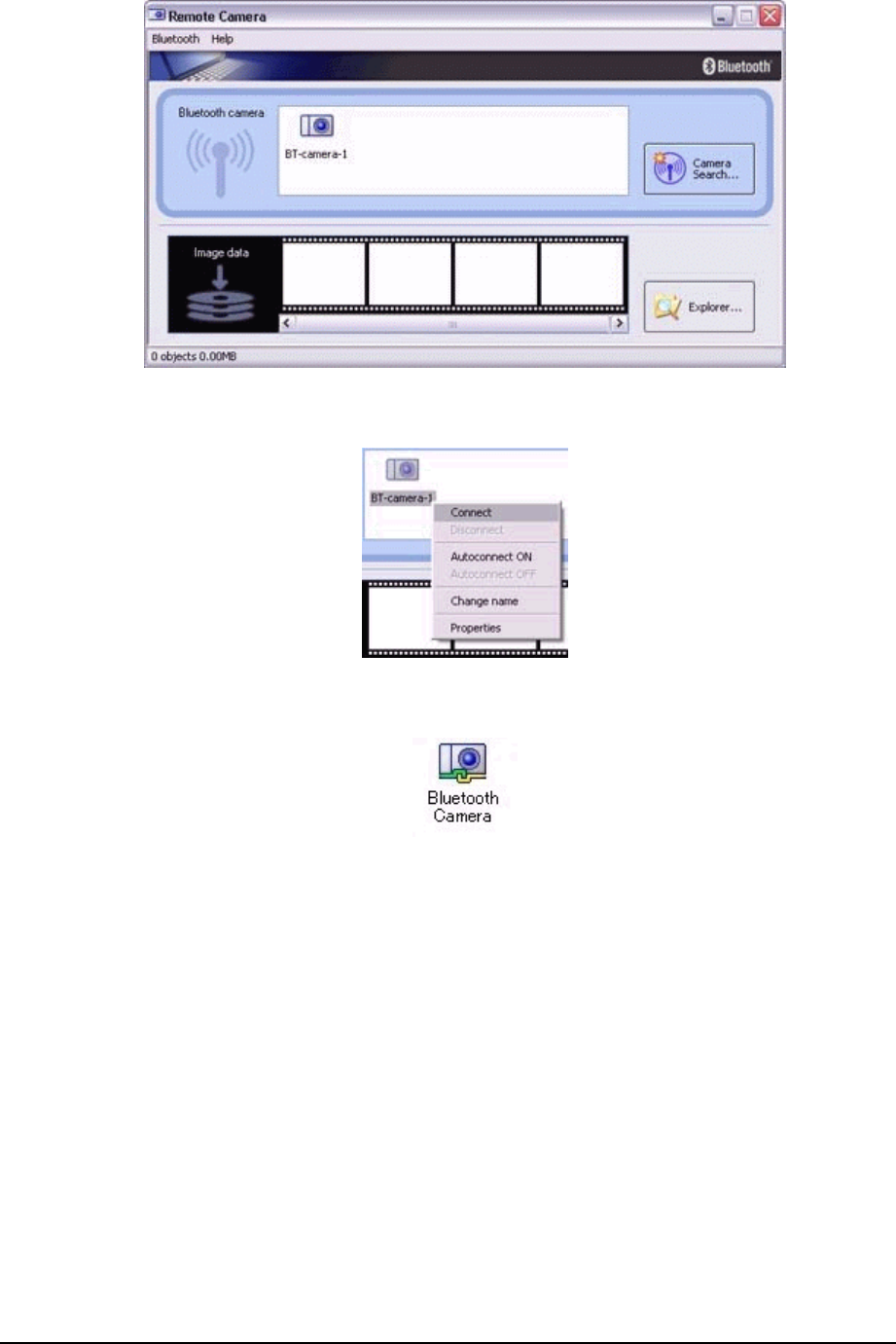
123
4. Right-click on the camera icon, and select [Connect].
The camera will be connected, and images from the camera will appear on-screen.
Taking a signal picture
By placing the mouse cursor over the on-screen image, the camera's operating window
will appear.
You can operate the camera from this window.
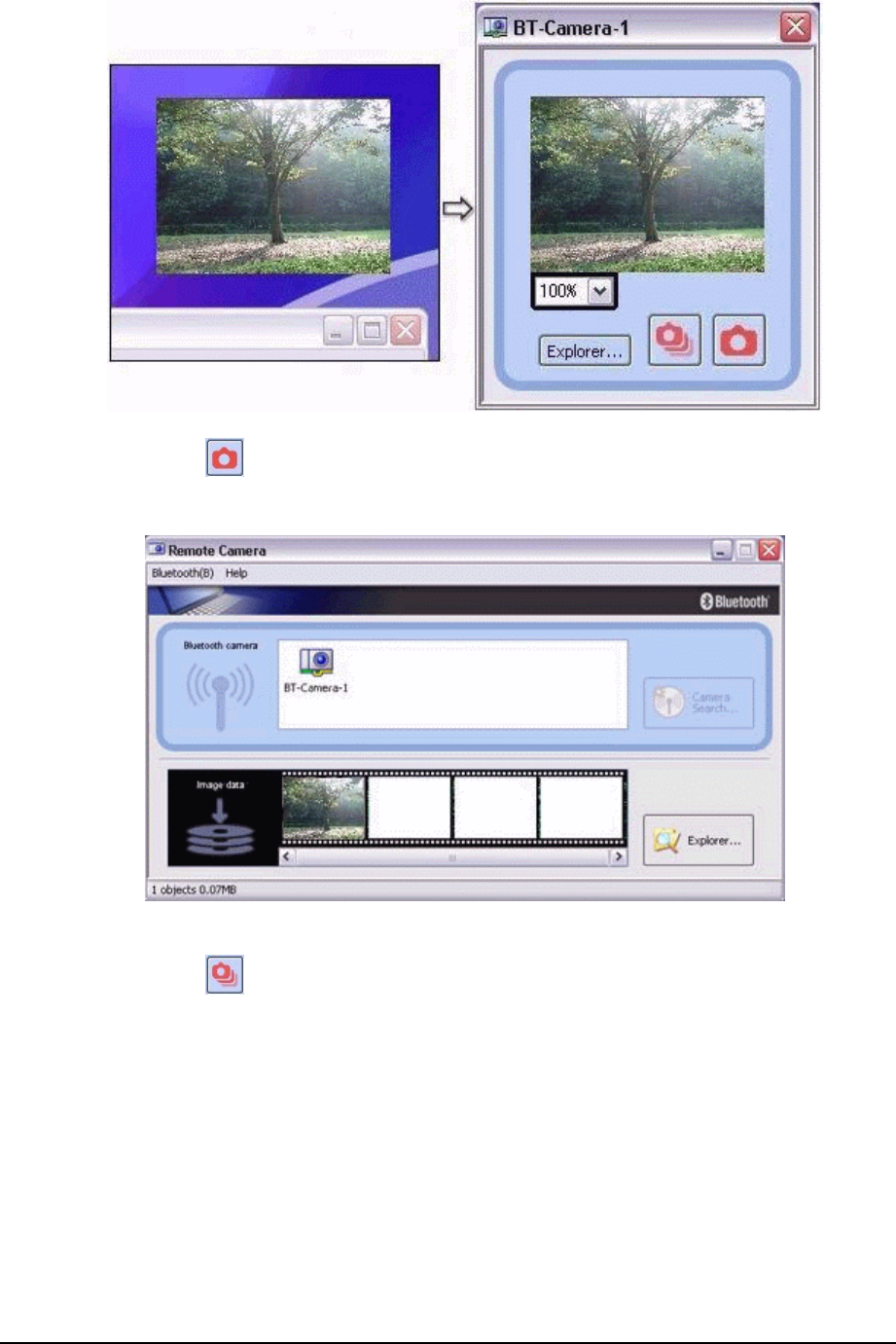
124
1. Click on the button in the operating window.
A single image will be captured and sent to the PC.
Taking several consecutive frames
1. Click on the button in the operating window.
A succession of images will be captured and sent to the PC.
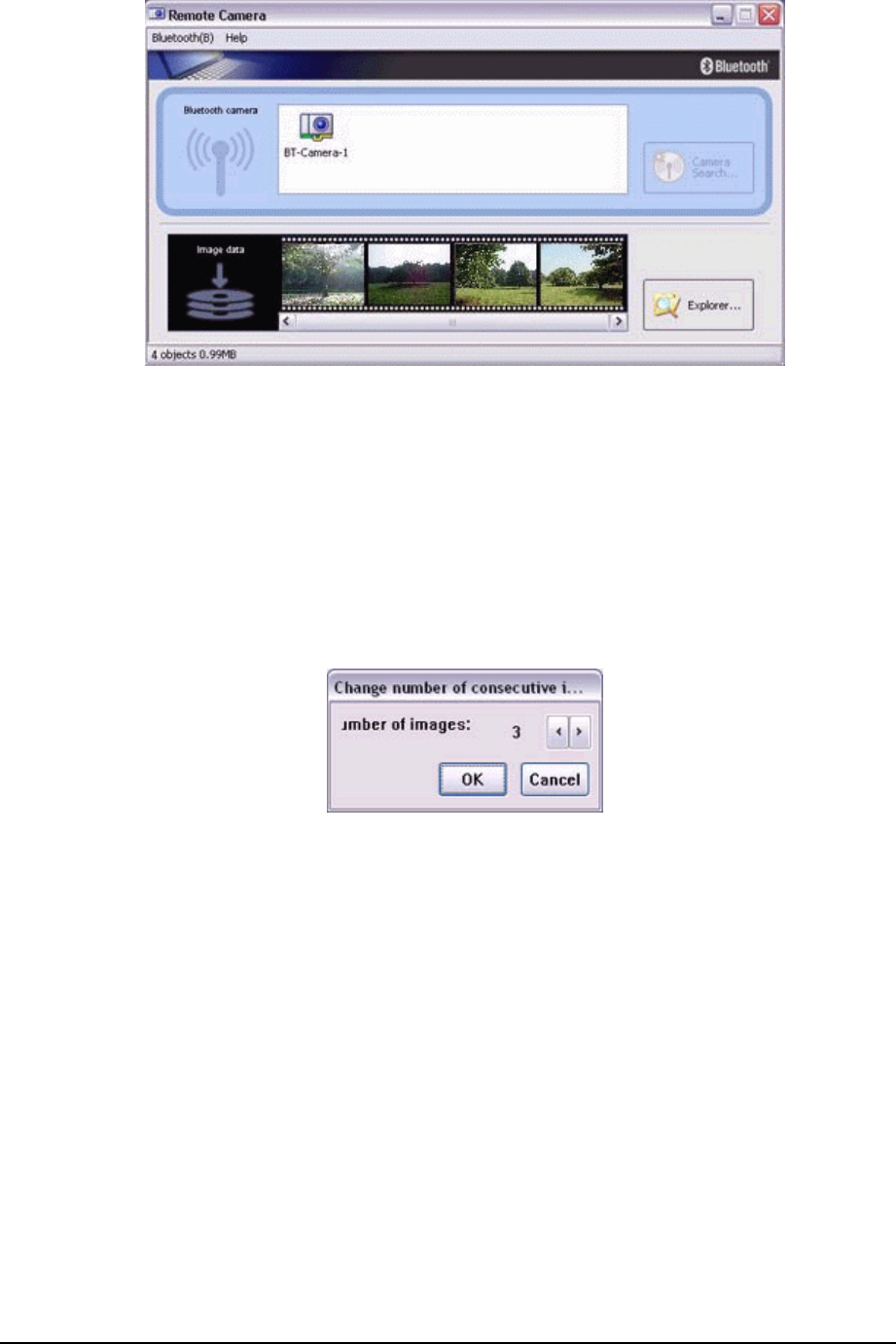
125
Note
.The remote camera shutter cannot be operated while the camera is connected
to the PC.
.The number of consecutive pictures taken can be set to anywhere between 2
and 16.
1. In the [Remote Camera] window, click on [Bluetooth]→[Properties]Æ
[Consecutive Image Settings].
2. Click on the [<][>] buttons to select the number of consecutive images
to be captured.
Note
.Images are not only sent to the PC, but are stored in the camera's on-board
memory as well.
Please be aware of the remaining memory capacity when you are taking a large
number of pictures.
.Large file sizes are common for high-resolution images, and may take some
time to be transferred to the PC.
Viewing images saves on your PC
A "Remote Camera" folder will be created in the "Bluetooth" folder under "My Documents"
during initial set-up. A folder bearing the same name as the camera will be created in it,
and images will be saved in this folder.
Click the [Explorer] button in the [Remote Camera] window to display the folder where the
images have been saved.
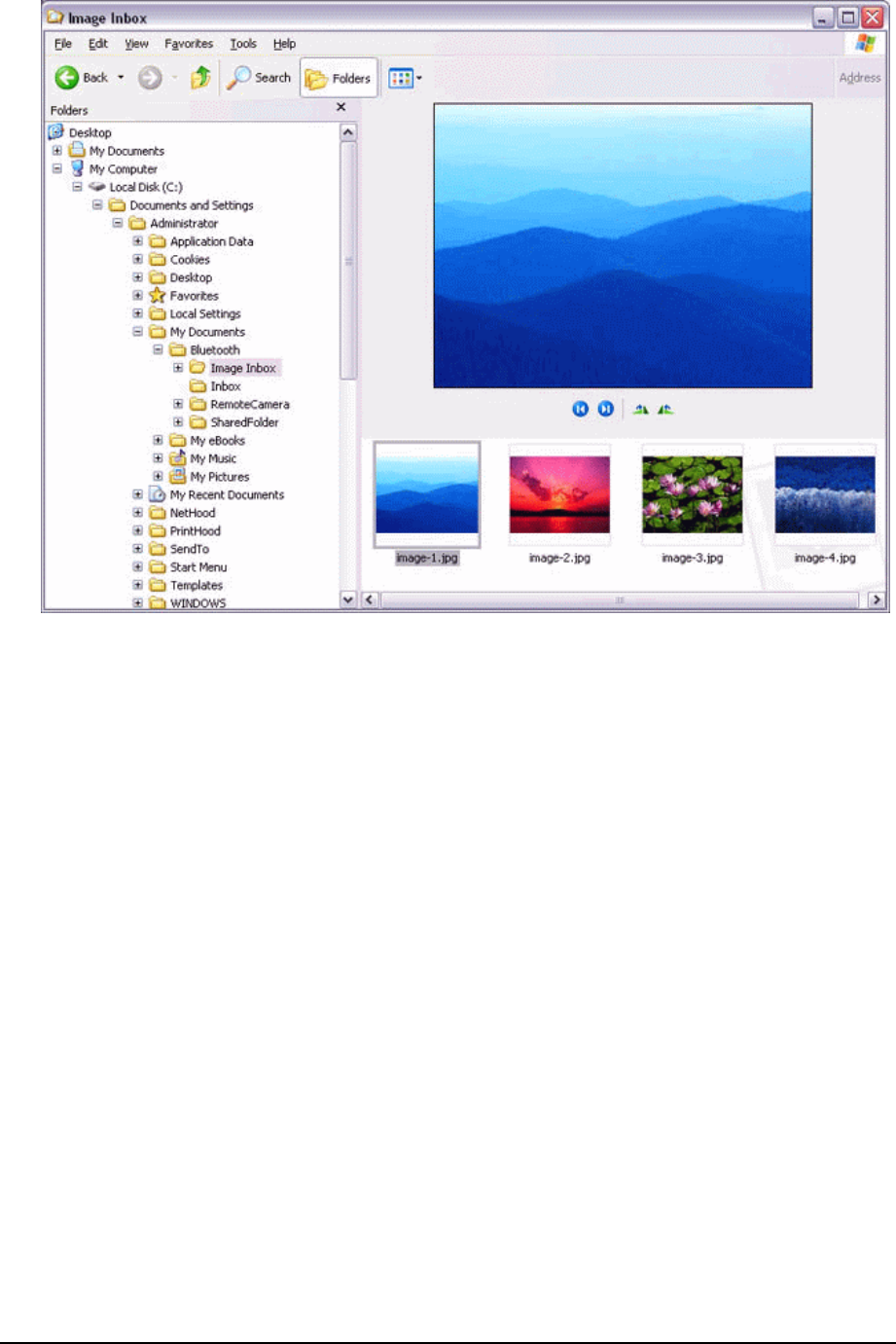
126
Note
.This window is an example showing pictures when [Filmstrip] has been selected
from the [View] menu in Explorer.

127
4.8 Using a headset to communicate
Registering the headset
1. Right-click on the Bluetooth icon in the tasktray, then click on [Add New
Connection Wizard].
Note
.Alternatively, you can click on [Start]>[All Programs]>[Bluetooth]>[Bluetooth
Settings], then click on [New Connection] in the [Bluetooth Settings] screen that
has opened.
The [Add New Connection Wizard (Welcome to the Add New Connection Wizard)]
screen will appear.
2. Turn the headset power on.
Once you have turned on the headset, set the mode to enable a Bluetooth
connection.
Important
.The procedure for operating the headset may differ depending on the
manufacturer and model.
Please consult your user guide for a detailed description of how to operate the
unit.
3. Confirm that [Express Mode] has been selected, then click on the [Next]
button.
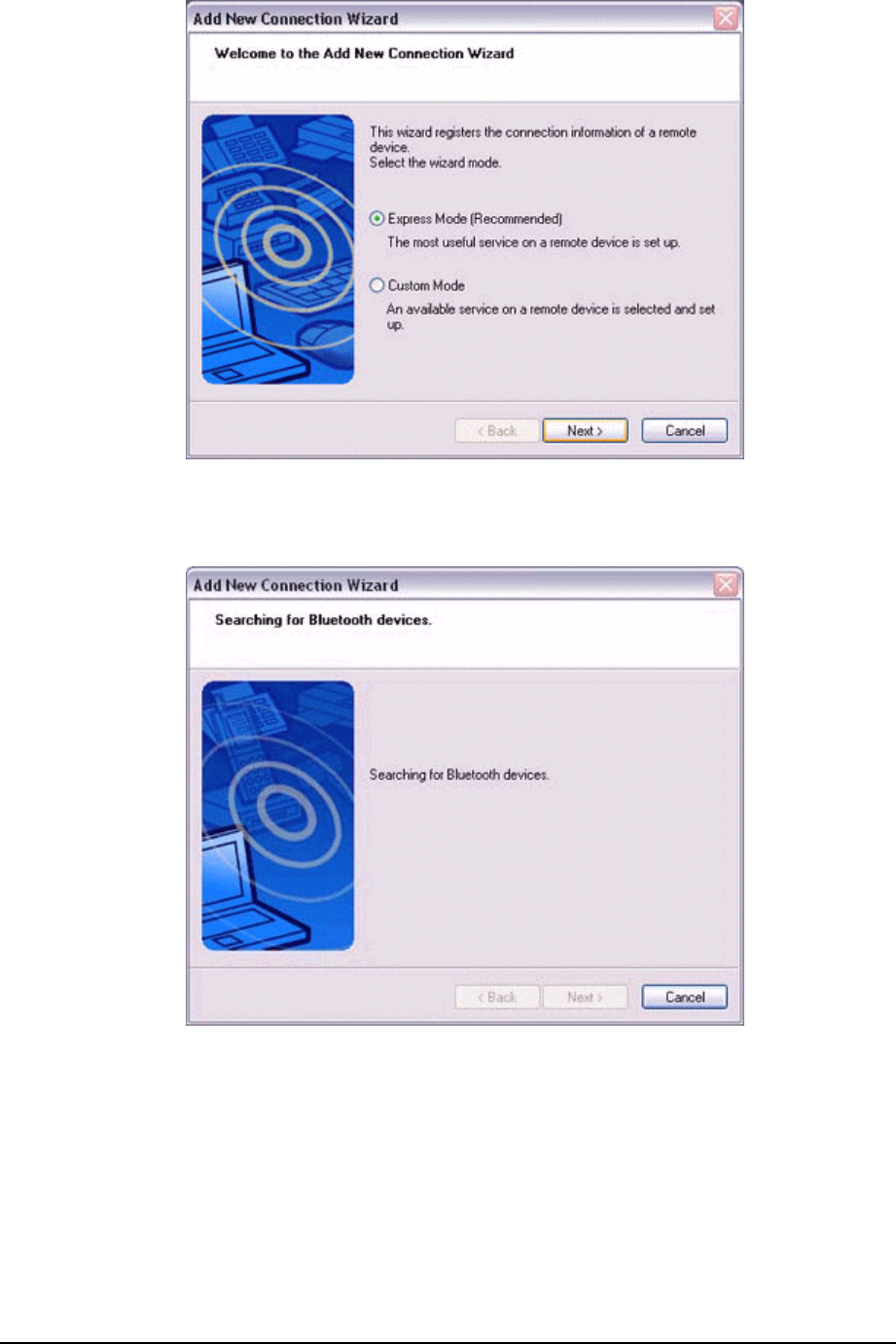
128
The [Add New Connection Wizard (Searching for Bluetooth Devices)] screen will
appear.
Once the device search has been completed, the [Add New Connection Wizard
(Select a Device)] screen will appear.
4. Select the name of the headset device from the list, then click on the [Next]
button.
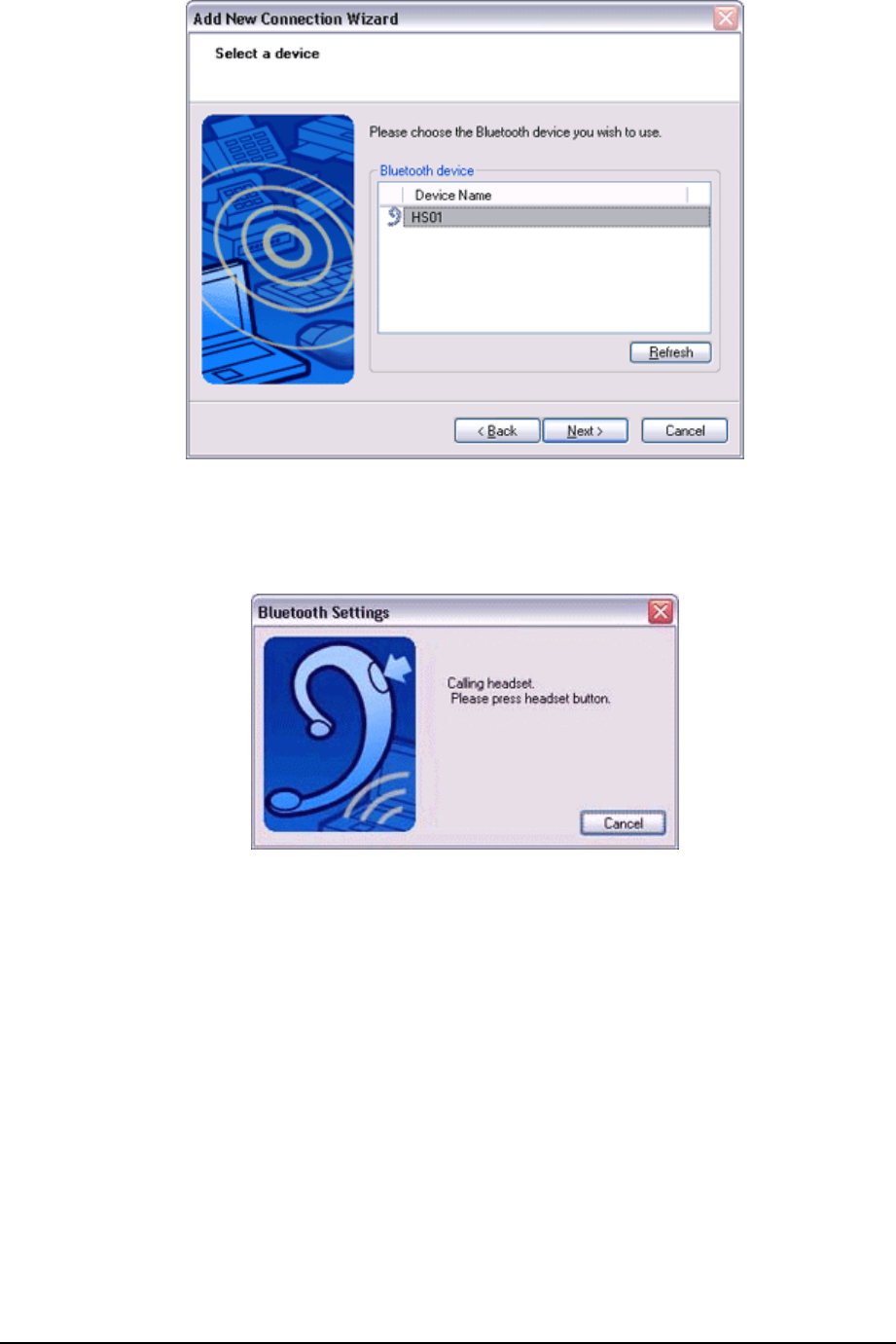
129
5. Answering with the headset.
If the service has been properly detected, a screen will appear indicating that the
headset is being called, and a tone will accordingly sound in the headset.
Please press the headset switch.
Important
.The procedure for operating the headset may differ depending on the
manufacturer and model.
Please consult your user guide for a detailed description of how to operate the
unit.
The [Add New Connection Wizard (Configuring (Connecting to Voice Circuit))]
screen will appear, and device configuration will be performed.
Note
.If you are connecting to the headset for the first time, or if another Bluetooth
audio device (for example, the TOSHIBA Speech Recognizer) has not yet been
registered, the following [Found New Hardware Wizard] screen will appear, from
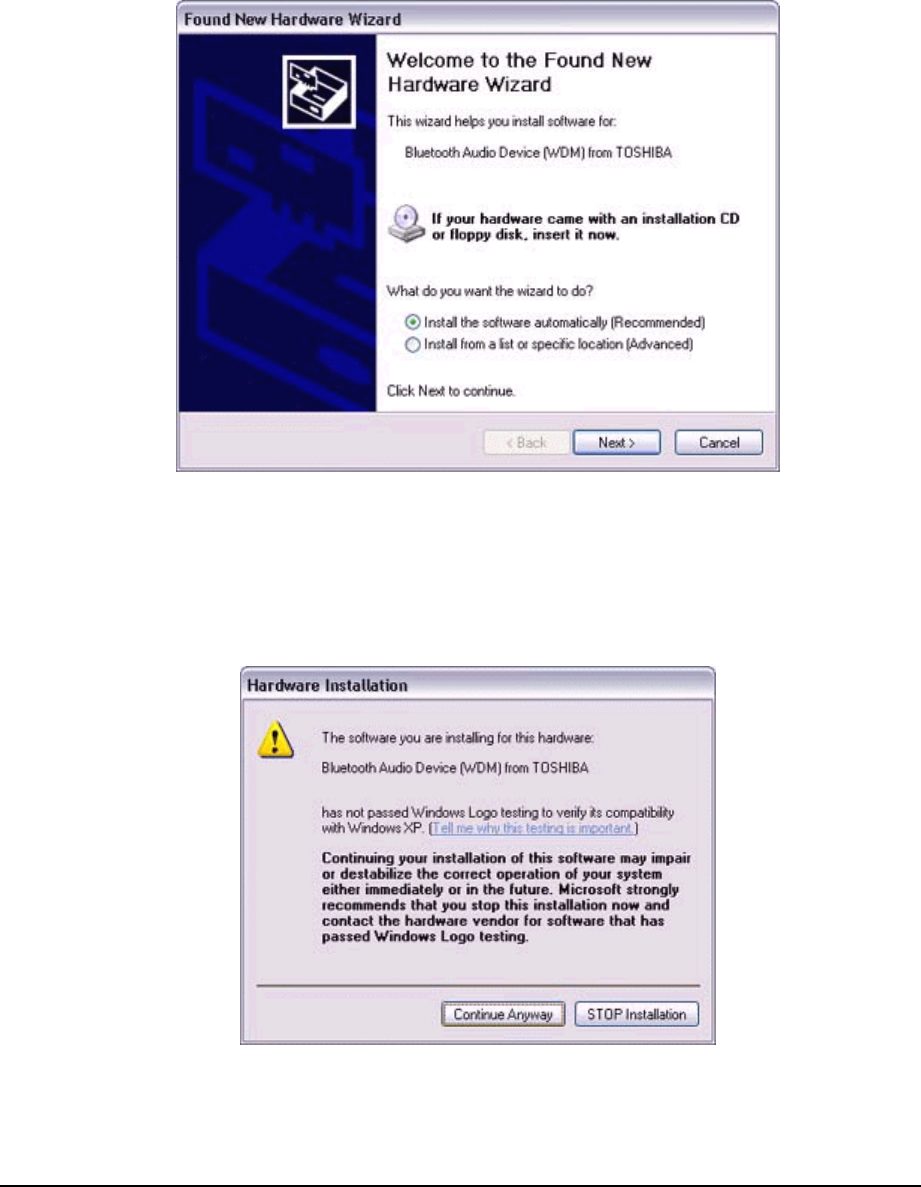
130
which you can proceed to install the driver.
If another audio device has already been registered (i.e., the driver has been
installed), you can proceed to Step 9 without having to install the driver.
6. Click on the [Next] button.
The [Install Hardware] screen will appear.
7. Click on the [Continue Anyway] button.
The following screen will appear automatically. You may disregard it and click on
the [Continue Anyway] button.
The [Add New Connection Wizard (Completing the Found New Hardware Wizard)]
screen, which is the final screen of the installation wizard, will appear.
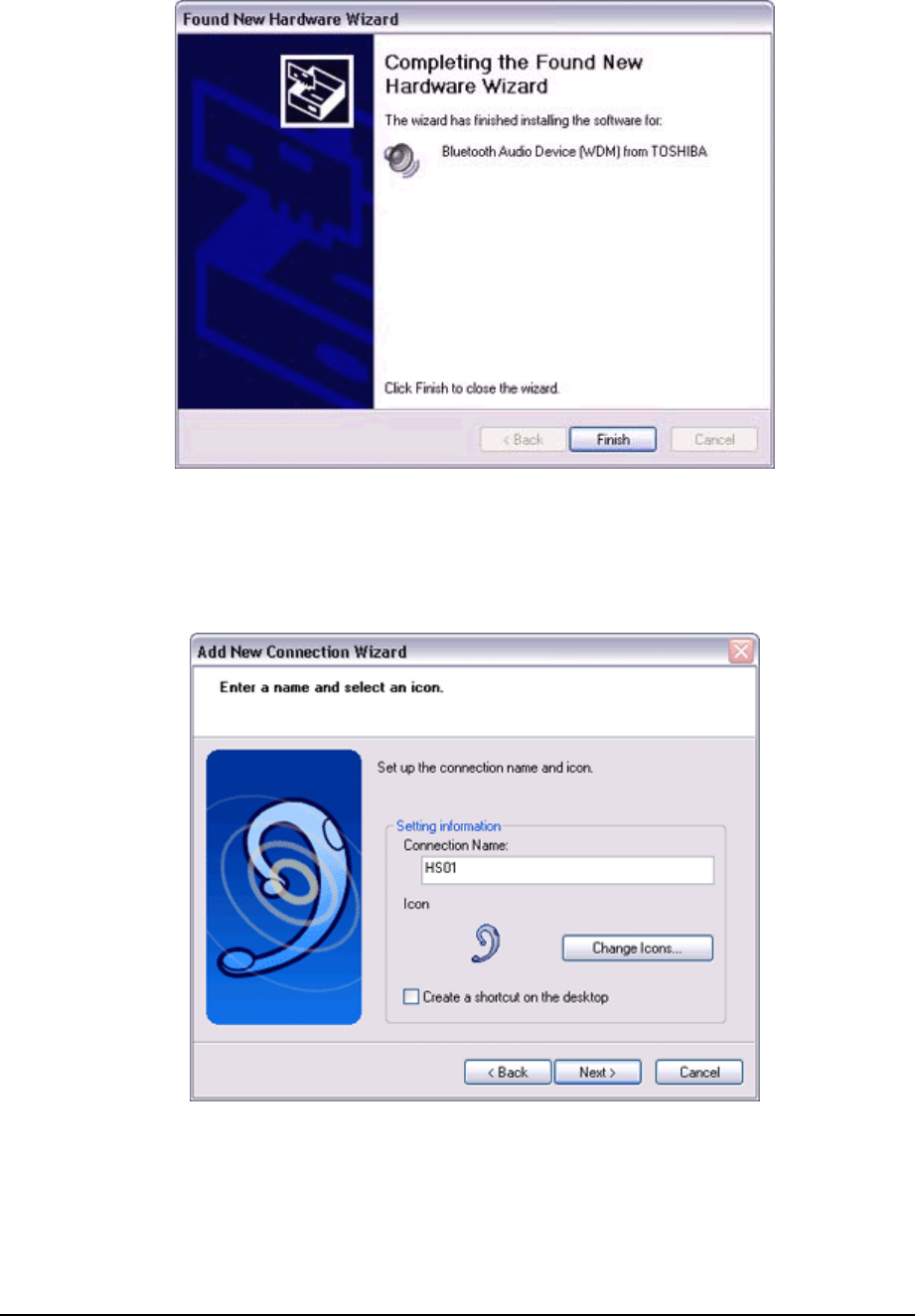
131
8. Click on the [Finish] button.
Once driver installation is complete, the [Add New Connection Wizard (Enter
Connection Name)] will appear.
9. Confirm the information you have entered, and click on the [Next] button.
The [Add New Connection Wizard (Completing the Add New Connection Wizard)]
screen will appear.
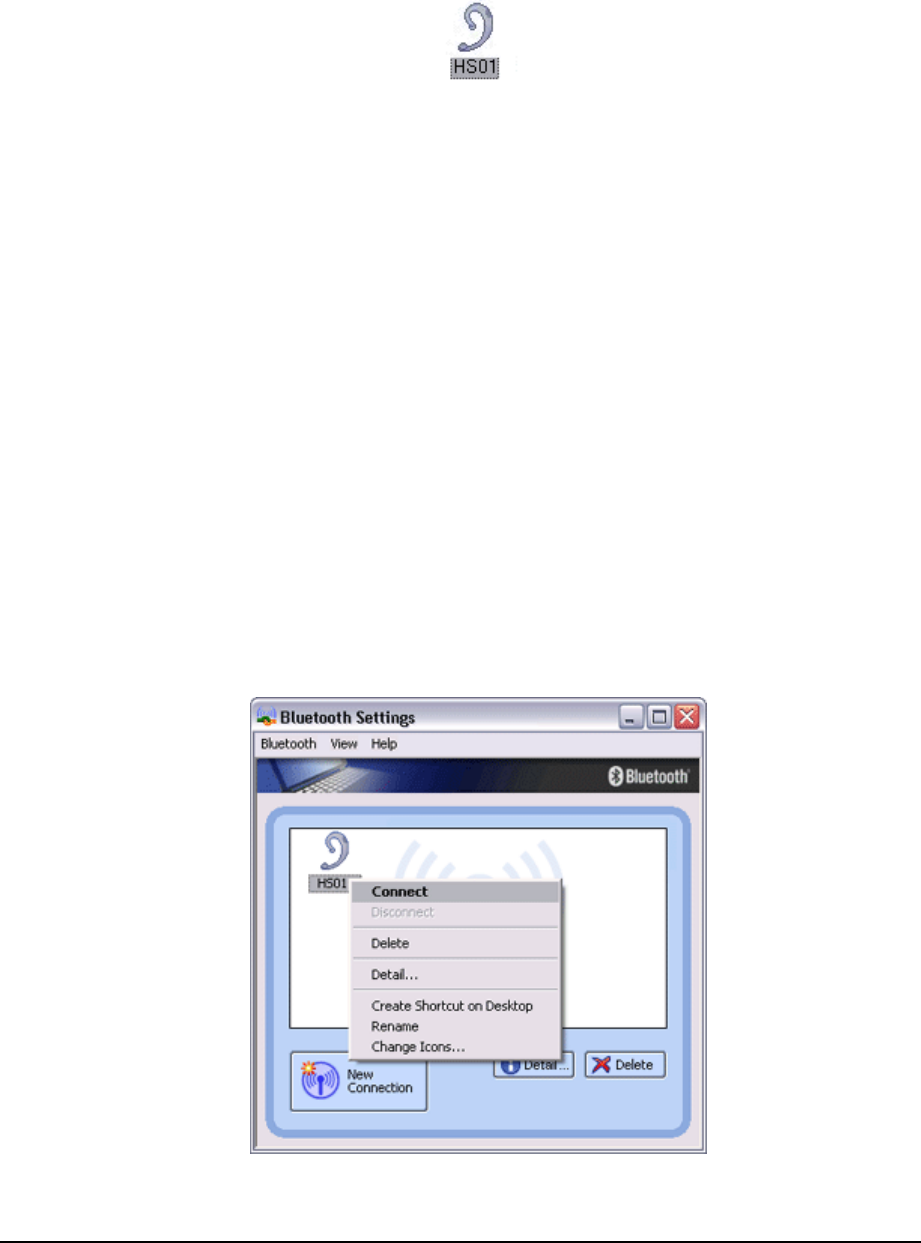
132
10. Click on the [Finish] button.
The configuration information will be registered, and an icon will be displayed in the
[Bluetooth Settings] screen.
Making a connecting to the headset
You can make a connection to the headset from an icon that has been registered in
[Bluetooth Settings].
Important
.Before making a connection to the headset, please check that you have turned
on the headset's power, and it has been enabled for a Bluetooth connection.
Please ensure that the following audio-related applications have been closed
before you connect the headset to your PC.
o Windows Media Player, BeatJam, InterVideo WinDVD and other
music/audio playback software
o Windows Messenger and other e-conferencing software
o LaLaVoice and other voice-recognition software
If you wish to use these applications, please terminate the headset connection
before you launch them.
1. Right-click on the headset icon, then click on [Connect].
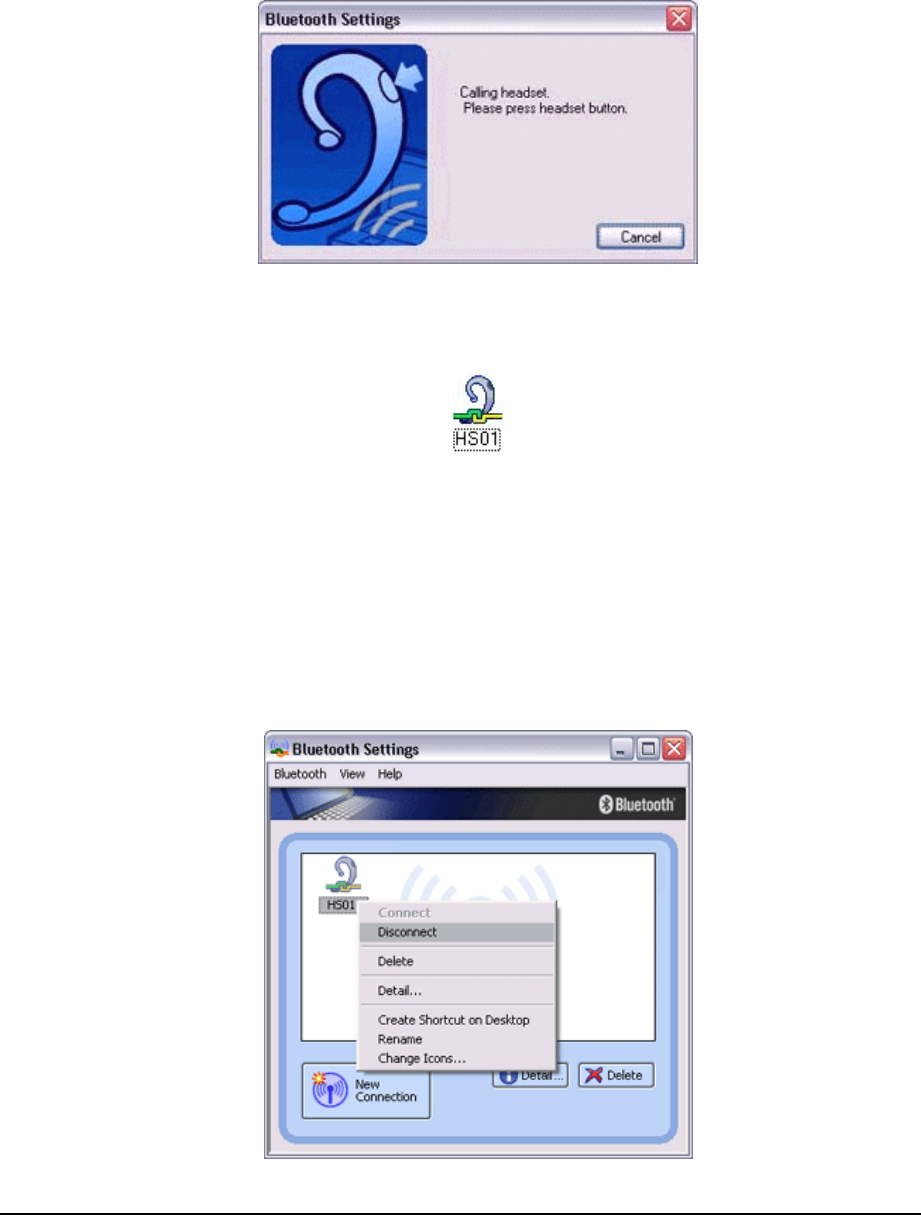
133
2. Answer with the headset.
A screen will appear indicating that the headset is being called, and a tone will
accordingly sound in the headset.
Please press the headset switch.
If the connection has been properly established, the icon's appearance will change
to indicate a connected state.
You may now launch conferencing and voice-recognition software and use the headset.
Disconnecting from the headset
Please follow the steps below to disconnect from the headset.
1. Right-click on the headset icon in the [Bluetooth Settings] screen, then click
on [Disconnect].

134
A message will appear, requesting confirmation that you wish to disconnect. Click on
the [Yes] button.
The icon on the [Bluetooth Settings] screen will appear as shown below, indicating that
the device has been disconnected.
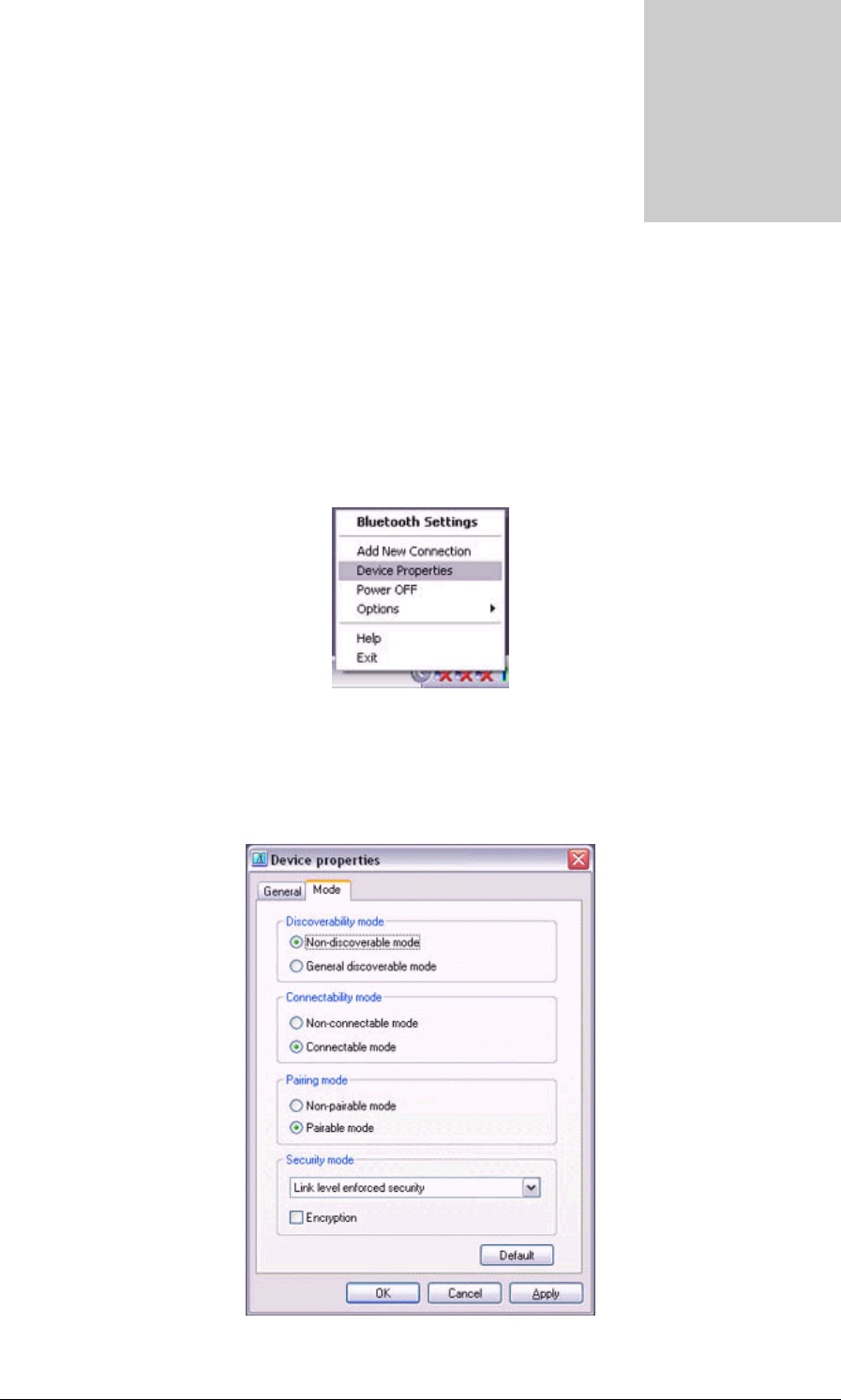
135
Chapter 5
Advanced features
5.1 Making a device undiscoverable to other users
1. Right-click on the Bluetooth icon in the task tray, and then click on
[Device Properties].
The [Device Properties] window will appear.
2. Select [Non-discoverable mode] in [Discoverability mode] under the
[Mode] tab, and then click on the [OK] button.
4
5
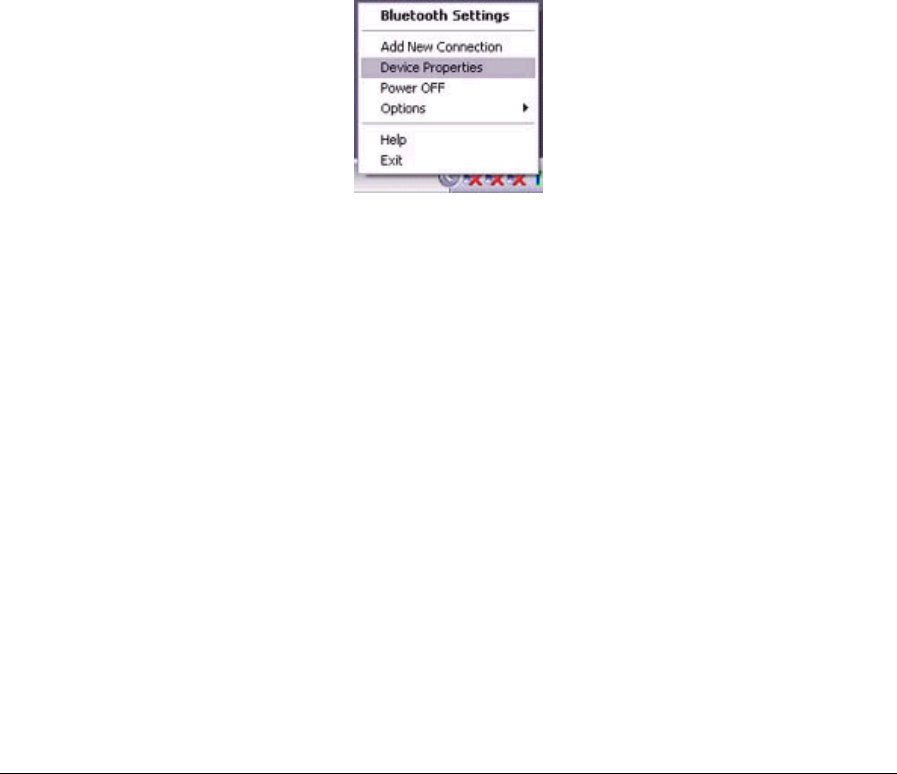
136
Your device will now be undetectable by other users, even when they search
for other devices.
Note
.Other devices are still able to establish connections with your device even
if you have enabled the Non-discoverable mode.
Please enable "Non-connectable mode" if you wish to reject connections
from other devices.
5.2 Encrypting the content of your transmissions
Since Bluetooth communication is conducted wirelessly, there is always the
possibility that a third party may be able to intercept your transmissions.
You can use encryption to render the content indecipherable to anyone who
manages to intercept it.
Important
.Encrypting your transmissions will still not guarantee complete security.
Accordingly, please be aware that transmitting data is conducted with an
element of risk for the user.
1. Right-click on the Bluetooth icon in the task tray, and then click on
[Device Properties].
The [Device Properties] window will appear.
2. Select [Link Level Enforced Security] in [Security Mode] under the
[Mode] tab, put a check next to [Encryption], and then click on the [OK]
button.
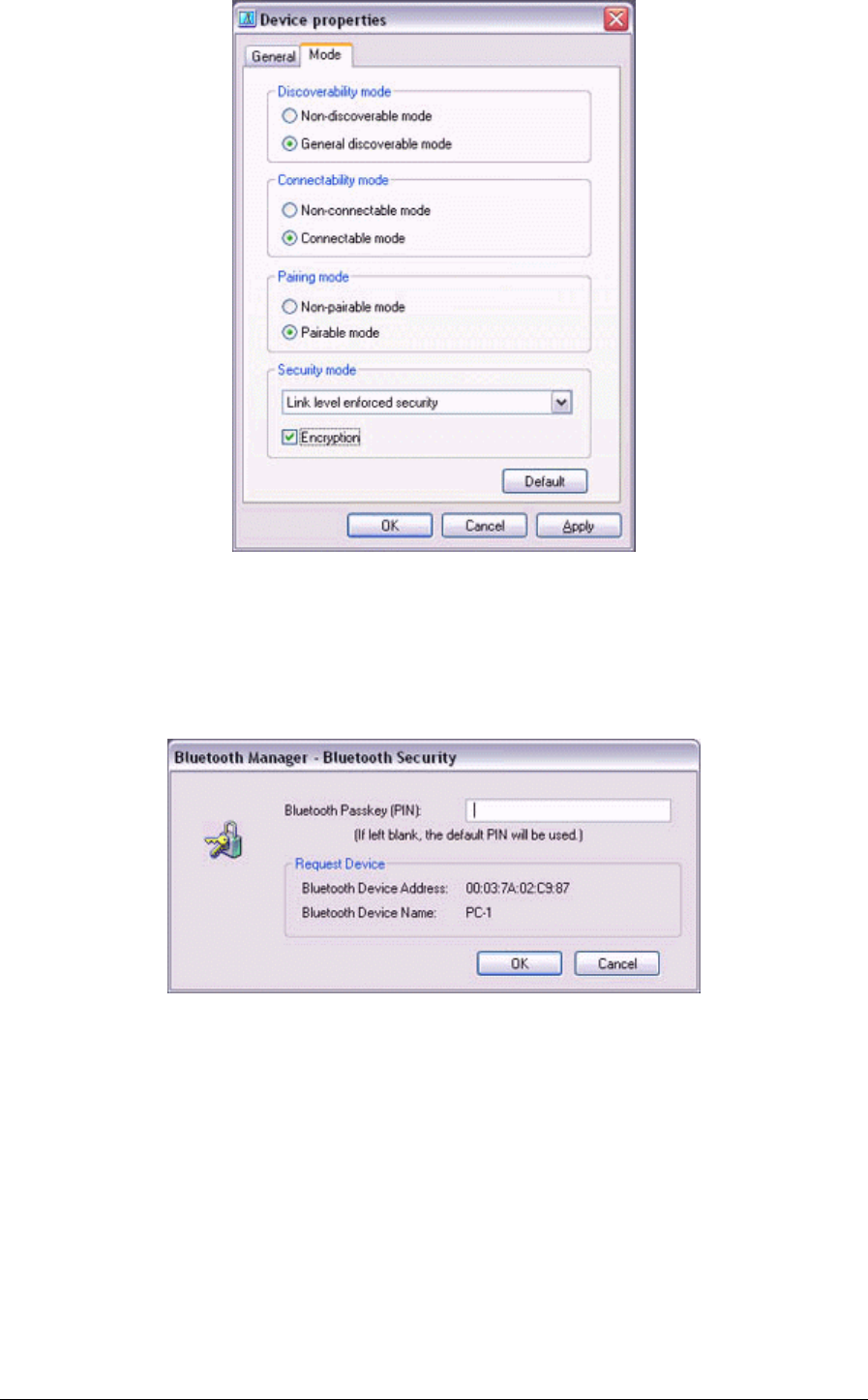
137
Note
.Once you have configured the security mode, a window will appear when
you first make a connection to another device, prompting you to enter a
Bluetooth passkey (PIN code).
Please click on the [OK] button after you have entered the passkey.
.The window in which you enter the passkey will not appear once you have
connected more than two times to the device.
5.3 Changing the default connection
The "default connection" refers to the dial-up connection configured for use
whenever a connection is made to the Internet.
If several connections have been registered, you can change the default connection
by following the procedure below.
1. Start Internet Explorer.
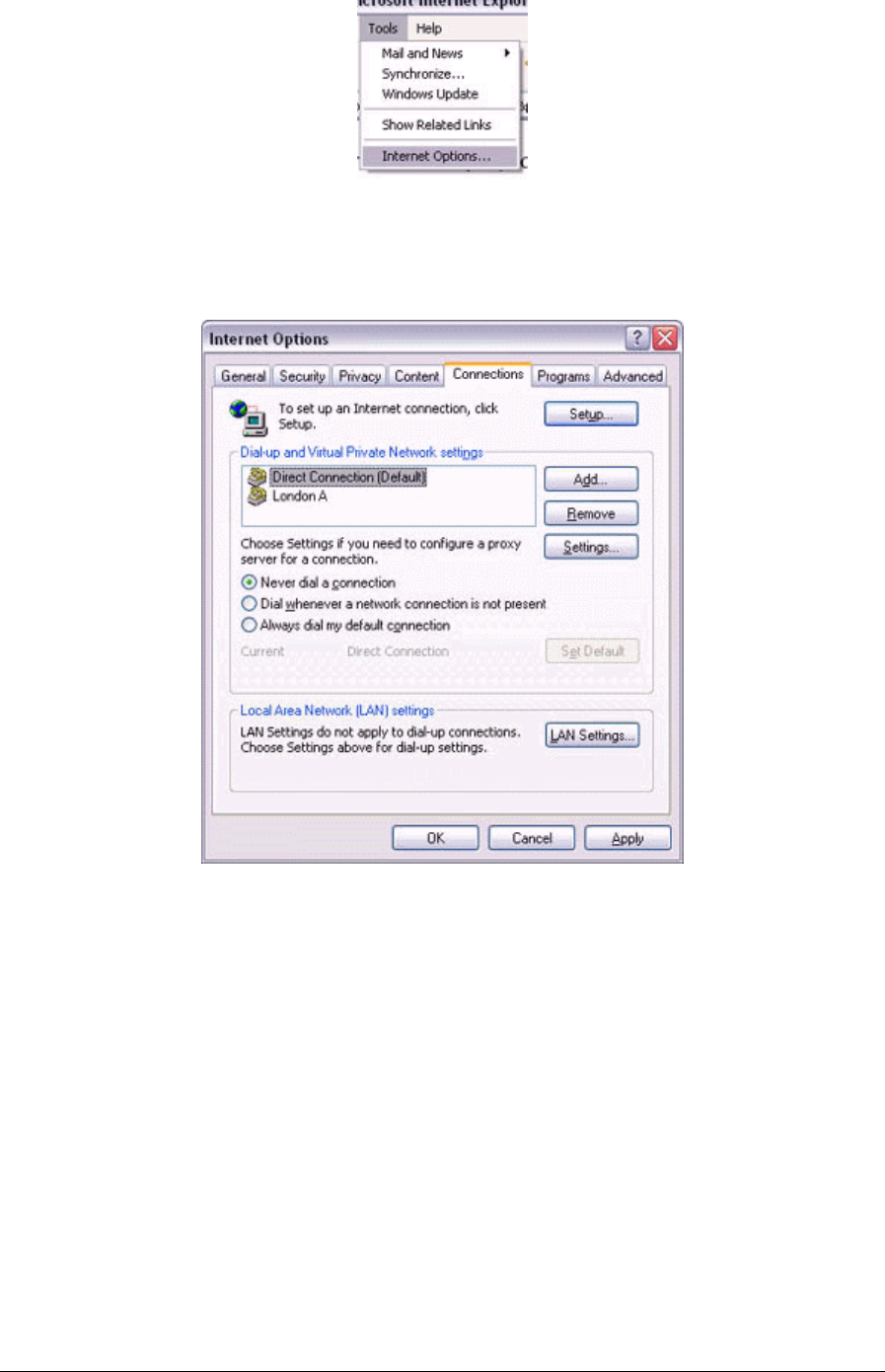
138
2. Click on [Tools]→[Internet Options...].
The [Internet Options] window will appear.
3. Click on the [Connections] tab.
In this window, "Direct Connection" is set as the default, and "Never dial a
connection" has been selected.
Change the settings so that "London A" will always be dialled when you
connect to the Internet.
4. Select "Always dial my default connection".
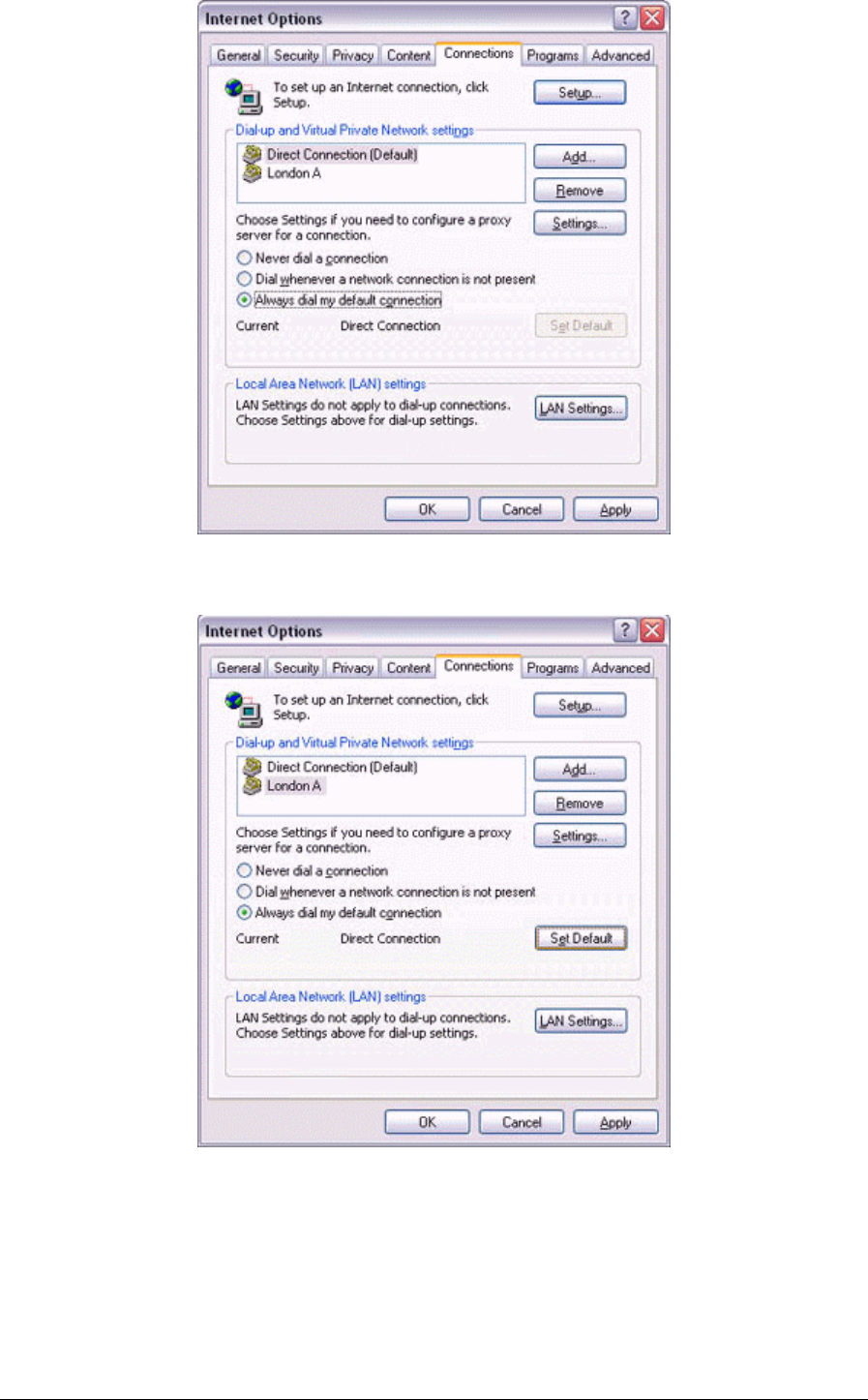
139
5. Click on "London A", and then click on the [Set Default] button.
"London A" has been changed to the default connection.
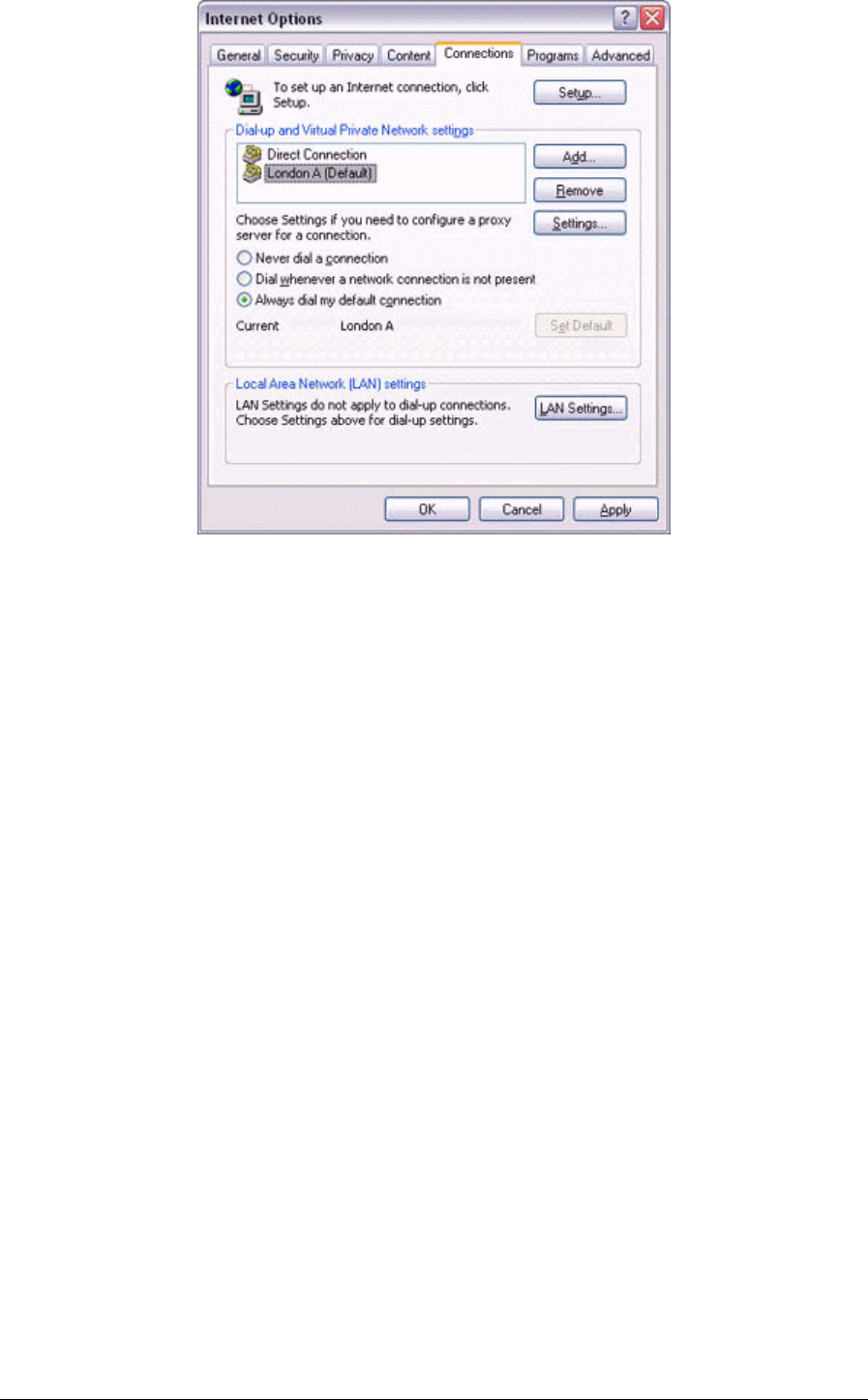
140
5.4 Manually creating a virtual Bluetooth COM port
In order for a PC to connect to and communicate with a Bluetooth device, the
Bluetooth Utility will create a gateway for data to be exchanged between the
respective devices. This gateway is known as a "port" (or "virtual COM port").
Since one virtual COM port will be allocated to each device, trouble-free
communication will still be possible even if several devices are being used.
When you use the Bluetooth Utility, a virtual COM port will be automatically created
on set-up; however, virtual COM ports can be created manually if so needed.
5.4.1 Clients and servers
When Bluetooth communications are performed, there will always be a
"client/server" relationship between the various devices. A "client" is a device that
sends certain requests to another device, while a "server" is a device that provides a
service on receipt of such requests from another device.
For example, when a PC issues a print command to a wireless printer, the PC
functions as the client, while the printer functions as the server.
When a PDA or other device attempts to receive files located on a PC by means of
file transfer protocol, the PC functions as the server, while the PDA functions as the
client.
Virtual Bluetooth COM ports can be created both for clients and servers.
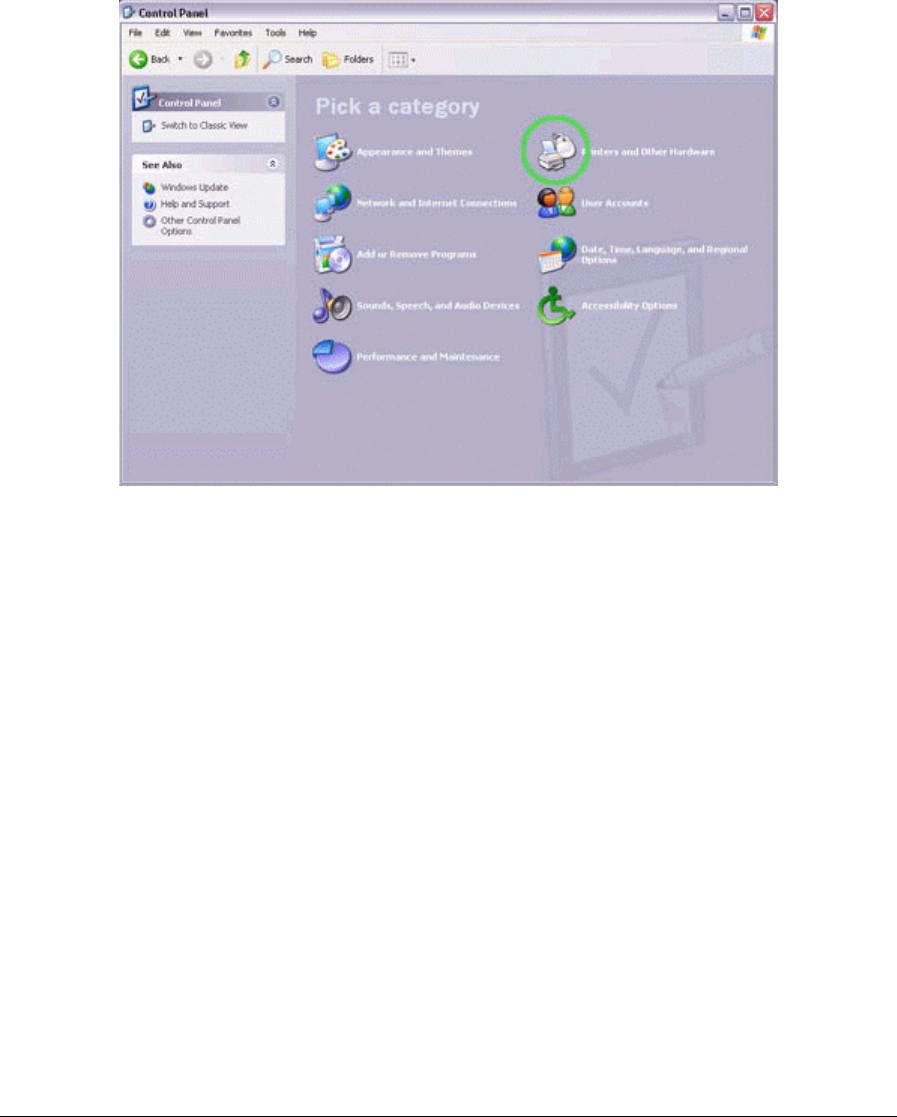
141
• Bluetooth virtual COM port for a client
Virtual COM port used when your device is the client, and requests are sent
to another device.
• Bluetooth virtual COM port for a server
Virtual COM port used when your device is the server, and requests are
received from another device.
5.4.2 Creating a virtual COM port
1. Click on the [Printers and Other Hardware] icon in the Control Panel.
The [Printers and Other Hardware] window appears.
2. Double-click on the [Bluetooth Local COM] icon.
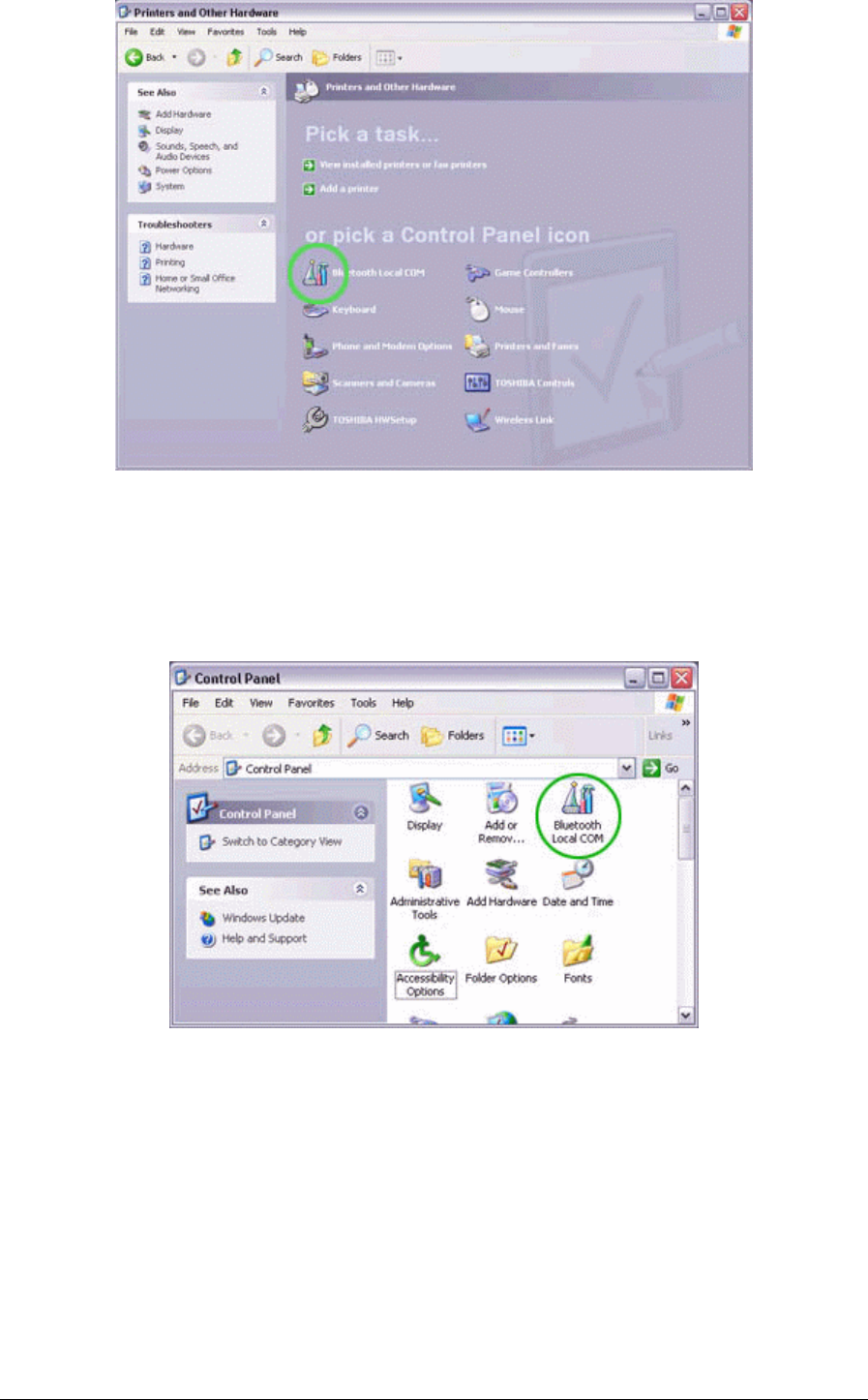
142
The main Bluetooth Local COM window will appear.
Note
.Even when the Control Panel appears in Classic view, please simply click
on the [Bluetooth Local COM] icon.
o No such distinction between viewing formats exists in Windows 2000.
3. Click on the [Add...] button.
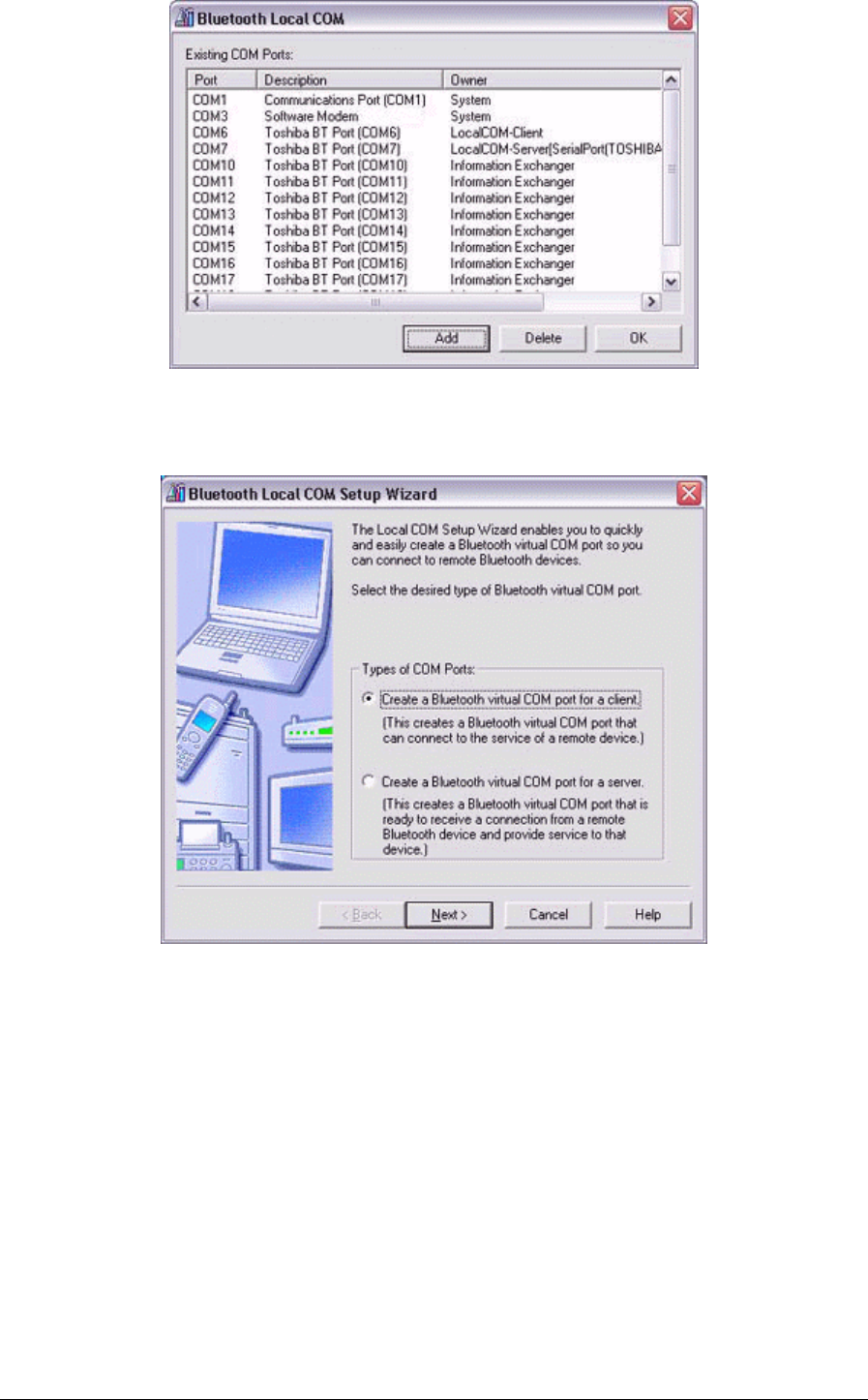
143
The [Bluetooth Local COM Wizard] window, from where you can create a
virtual COM port, will appear.
Start from this window when creating Bluetooth virtual COM ports for either
servers or clients.
5.4.3 Deleting a virtual COM port
Note
.You can only delete virtual COM ports created by the Bluetooth Local
COM utility.
1. Select the port you wish to delete from the [Bluetooth Local COM]
window, and then click on the [Delete] button.
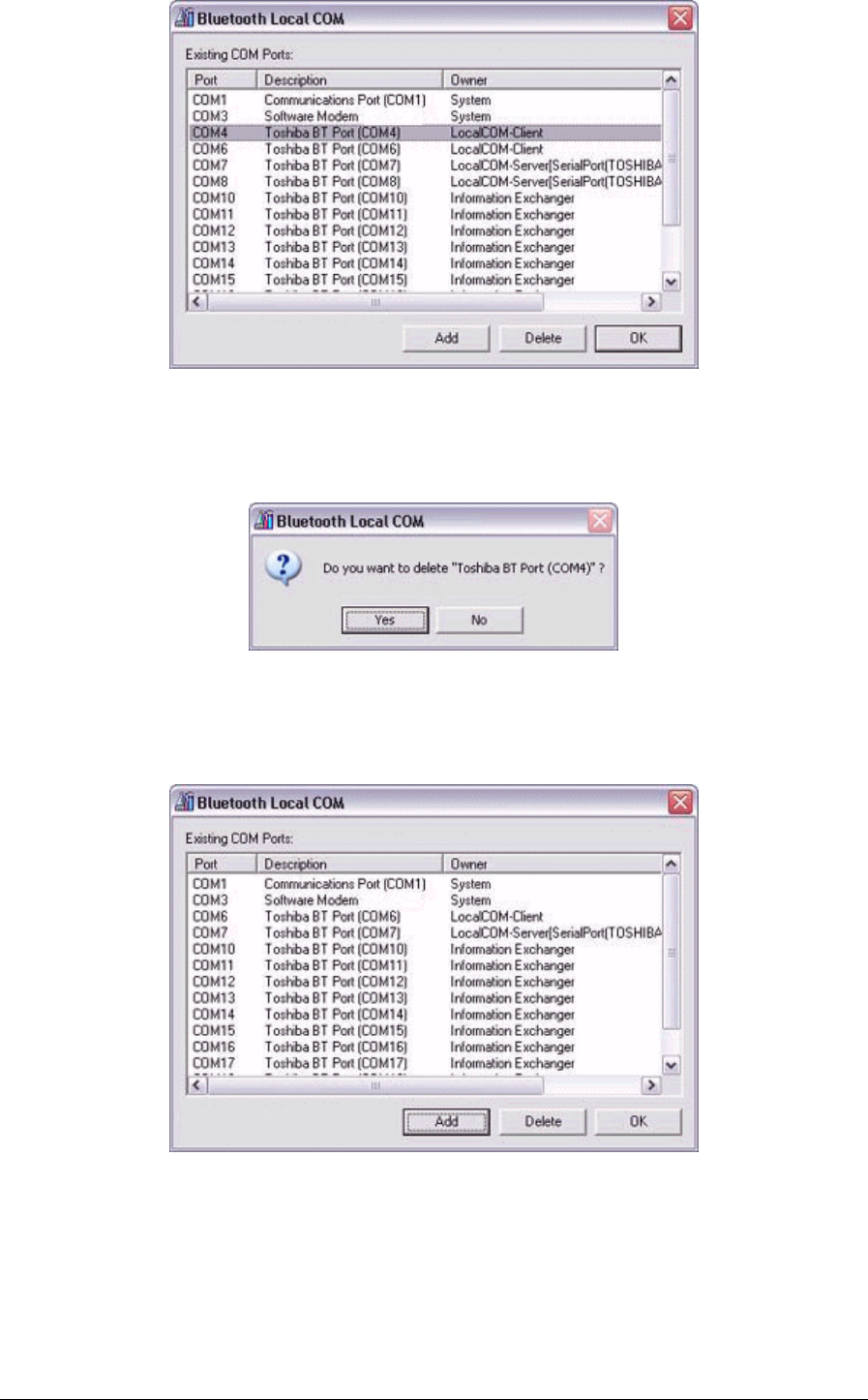
144
A message will appear asking you to confirm that you wish to delete the port.
2. Click on the [Yes] button.
The port will be deleted.
3. Click on the [OK] button.

145
Chapter 6
Troubleshooting
6.1 General operation of the Bluetooth Utility
Bluetooth Manager
Q: Bluetooth icon does not appear in task tray.
• If the Bluetooth icon does not appear in the task tray, Bluetooth Manager will
not be active, which will prevent you from being able to use any of the
functions of the Bluetooth Utility.
Start the utilities as instructed below to enable Bluetooth Manager to start
automatically and allow all functions to be utilized.
Bluetooth Settings
(from Windows XP)
[Start] > [All Programs] > [Bluetooth] > [Bluetooth Settings]
(from Windows 2000)
[Start] > [Programs] > [Bluetooth] > [Bluetooth Settings]
Remote Camera
(from Windows XP)
[Start] > [All Programs] > [Bluetooth] > [Remote Camera]
(from Windows 2000)
[Start] > [Programs] > [Bluetooth] > [Remote Camera]
Wireless File Transfer
(from Windows XP)
[Start] > [All Programs] > [Bluetooth] > [Wireless File Transfer]
(from Windows 2000)
[Start] > [Programs] > [Bluetooth] > [Wireless File Transfer]
Q: Unable to turn on Bluetooth.
• If the wireless communication switch on your PC has been turned off, the
message below will appear, and you will not be able to turn the power on from
Bluetooth Manager.
6

146
Please confirm whether the wireless communication switch has been turned
on.
Bluetooth Settings
Q: Clicking on the [New Connection] button brings up the message "Unable to
prepare
Bluetooth."
• The wireless communication switch is turned off.
Please switch it on.
Q: Remote device(s) cannot be detected
• The other device(s) may have been set to Non-discoverable mode.
Please check the mode settings on the device.
Q: Services on a remote device are undiscoverable
• The other device may be using a profile that is not supported by the Bluetooth
Utility
Please check the profile being used on the other device.
• The following profiles are compatible with Bluetooth Settings.
DUN, FAX, LAP, SPP, HID, HCRP, FTP, OPP, HSP, PAN and BIP
Devices running profiles other than those above will not be able to be
registered with Bluetooth Settings
Bluetooth Information Exchanger
Q: Bluetooth Information Exchanger icon does not appear on Desktop
• Bluetooth Information Exchanger is not active. Please follow the procedure
below to start the utility.
1. Right-click on the Bluetooth icon in the task tray
2. Click on [Options] > [Enable Bluetooth Information Exchanger],
and then check [Enable Bluetooth Information Exchanger]

147
The Bluetooth Information Exchanger icon will appear on the Desktop.
Q: Transfer failed when sending a file using the right-click menu.
• FTP or OPP are the sending profiles available when you select a file,
right-click it, and then click on [to Bluetooth] to send it.
If the destination device does not support either of these profiles, you will not
be able to send files using the right-click menu.
File transfer will also be unsuccessful if you use FTP to send a file to a device
that only supports OPP.
In such cases, please click on [Bluetooth] > [Profiles] from [Bluetooth
Information Exchanger], and enter the settings shown under Transfer mode.
Q: Cannot open shared folder on other device with "File Transfer".
• The other device may have a certain security level enforced
(Non-connectable mode etc). Please confirm the security settings of the other
device.
Please enter the correct password if you are asked to enter one.
Remote Camera
• See "Using a camera"
Bluetooth Local COM
Q: Cannot add port
• A maximum of 64 virtual COM ports can be added. You will be unable to add
another port if 64 ports have already been configured.

148
6.2 Using a wireless modem station
Q: Modem station cannot be detected.
• If the modem station is connected to and is being used by another device, the
modem station will be undetectable even if you search for it.
Q: Cannot connect to modem station
• If the modem station is connected to and is being used by another device, no
other device will be able to connect to the modem station.
Q: Bluetooth passkey entry failed
• The Bluetooth passkey (PIN code) comprises a sequence of alphanumeric
characters, with the letters able to be rendered in upper and lower case.
If [Caps Lock] is on, the Bluetooth passkey may not be able to be entered
correctly.
Q: Cannot connect to telephone line
• Please ensure that the telephone cable is connected from the socket to the
"LINE" terminal on the modem station.
Note
.If the telephone cable has come loose because it has not been fully
inserted into the socket, the resulting poor contact may prevent data from
being transmitted accurately.
.Communication will be impossible if the interior of the cable has been
broken. Please replace the cable with another one.
• Please ensure that the two slide switches on the underside of the main unit
have been set to the "NORMAL" and "MODEM" positions respectively.
Q: Cannot connect to the Internet
• The telephone number of the connection (i.e., the telephone number for the
access point of your Internet service provider) may not be correct. Please
check the telephone number.
• The user ID and/or password for the provider with whom you have signed up
may have been entered incorrectly. Please check the user ID and password.
• The default connection may have been configured with different settings.
Please set the connection configured for mobile telephone use as the default
connection.
• When you place a call using a company switchboard or other exchange, the
system may require you to enter a "0" before the telephone number itself.
Please check the type of telephone line you are using.
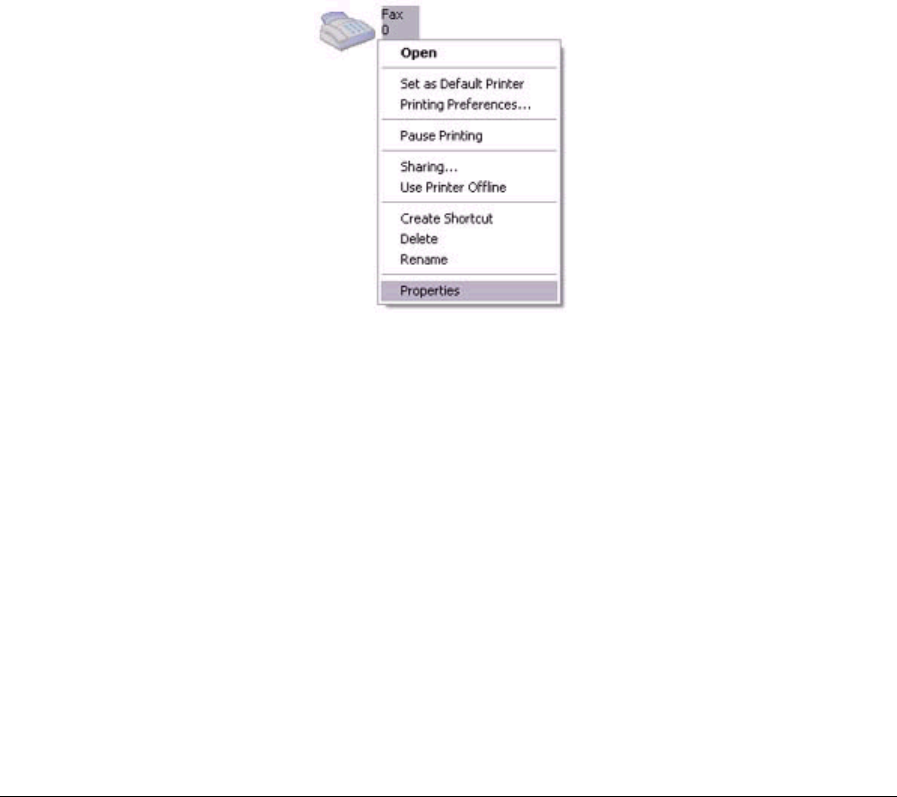
149
Q: Cannot send or receive faxes
• Once you have registered a wireless modem station as your fax server, you
will need to enter the fax settings from the [Printer and Faxes] window in the
Control Panel.
Please refer to "Using a modem station for fax transmissions" for information
on the configuration procedure.
• The telephone number of the fax destination may have been entered
incorrectly. Please check the telephone number.
• If the setting under COM Auto Connect Settings has been set to "Off", a
connection will not automatically be established with the modem. Please
connect to the modem manually.
• When you place a call using a company switchboard or other exchange, the
system may require you to enter a "0" before the telephone number itself.
Please check the type of telephone line you are using.
• The fax service may not have been enabled for sending (or receiving).
Please check the settings by following the procedure below.
1. Open [Printers and Faxes] from the Control Panel, right-click on
the [Fax] icon, and then click on [Properties].
The [Fax properties] window will appear.
2. Select the [Device] tab, right-click on the modem you wish to use,
and then click on [Properties].
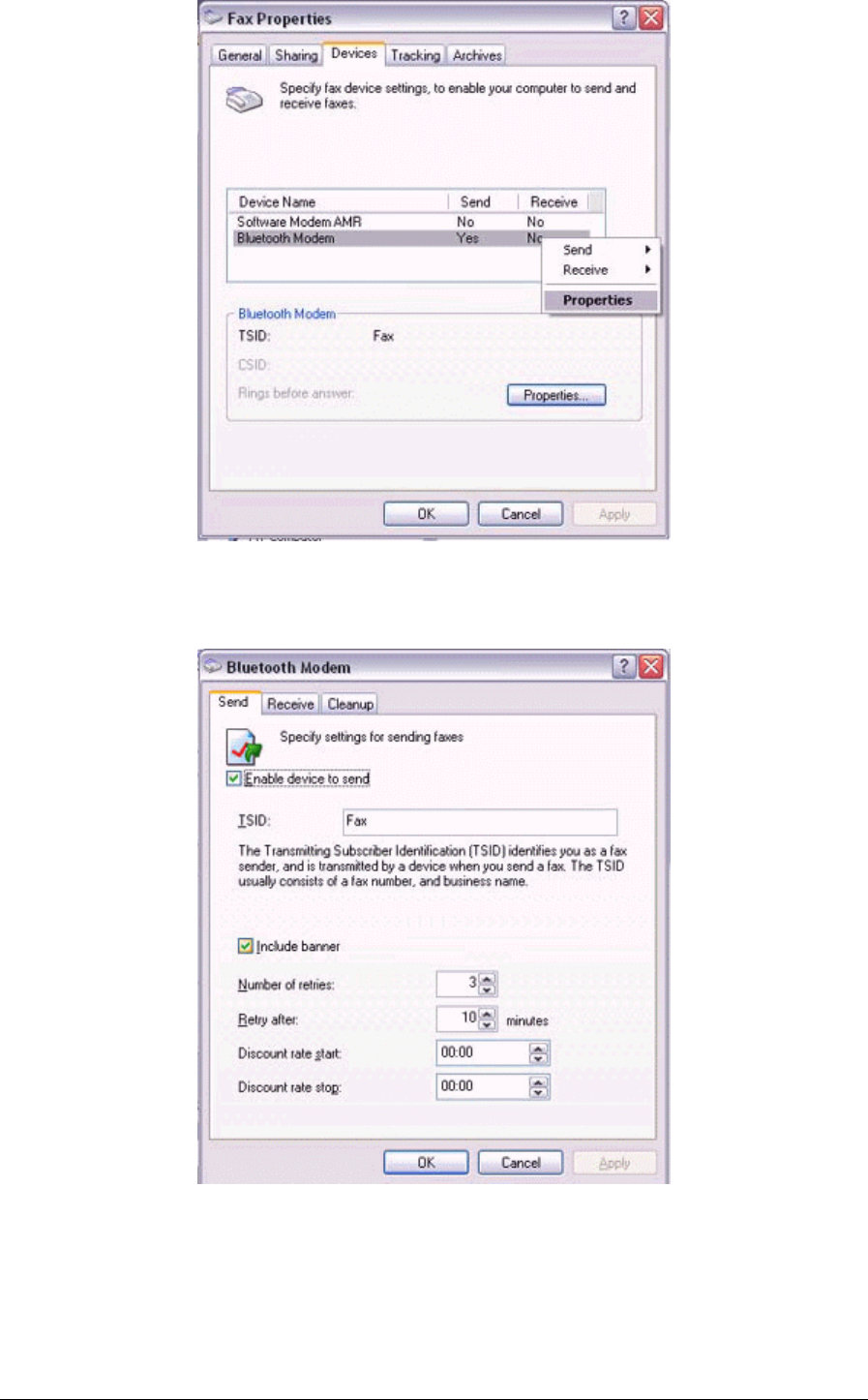
150
3. Select the [Send] tab, and then confirm that "Enable device to
send" has been checked.
4. Select the [Receive] tab, and then confirm that "Enable device to
receive" has been checked (when you wish to receive faxes).
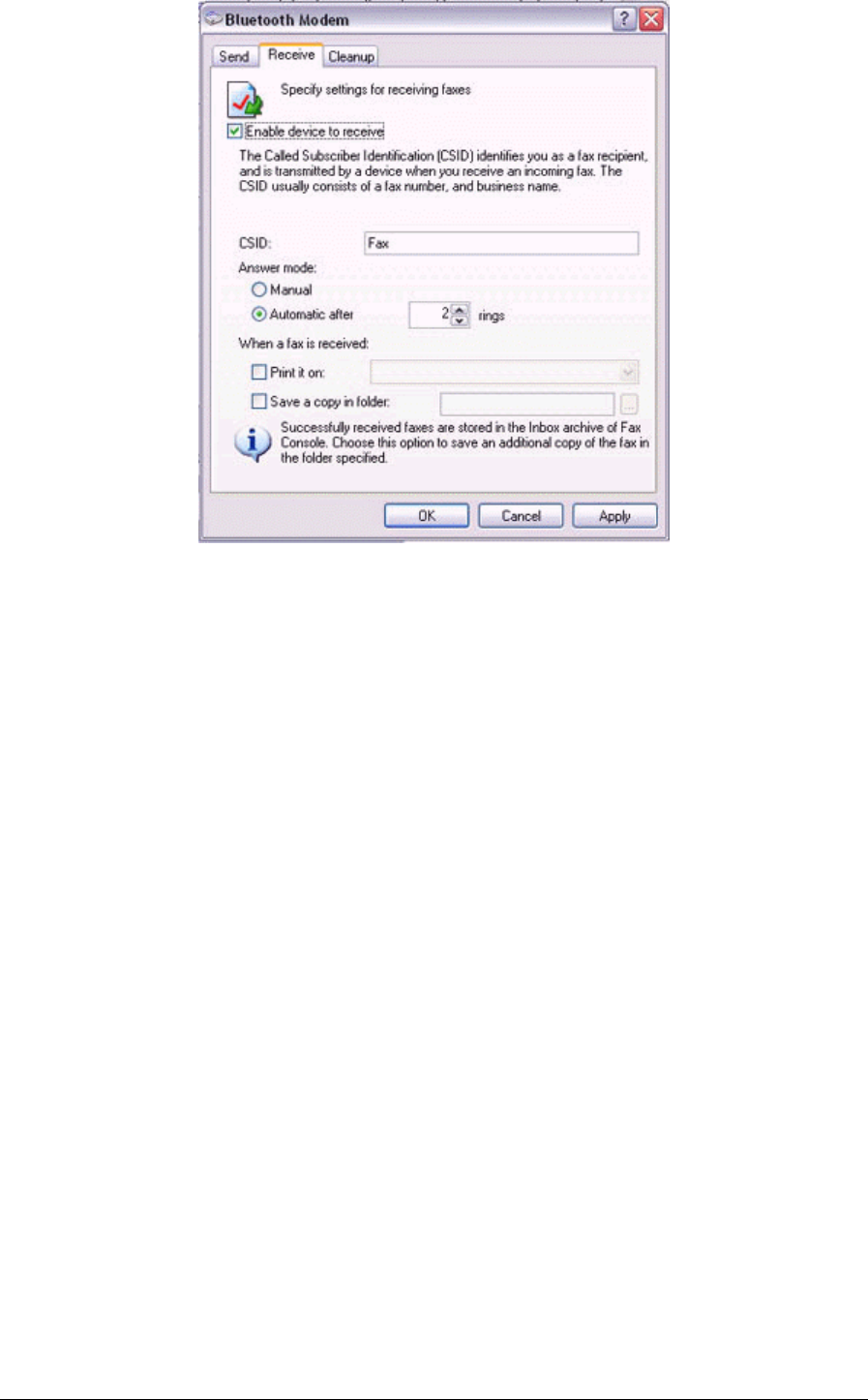
151
5. Click on the [OK] button.
6.3 Using an access point
Q: Access point cannot be detected.
• If the access point is connected to and is being used by another device, the
access point will be undetectable even if you search for it.
Q: Cannot connect to access point.
• If the access point is connected to and is being used by another device, no
other device will be able to connect to the access point.
Q: Cannot connect to LAN.
• The LAN cable may not be properly connected to the access point. Please
check the connection status.
Note
.If the LAN cable has come loose because it has not been fully inserted
into the socket, the resulting poor contact may prevent data from being
transmitted accurately.
.Communication will be impossible if the interior of the LAN cable has been
broken. Please replace the cable with another one.
• The access point may not have been configured correctly, and may not be
able to maintain the connection to the LAN.

152
Please refer to the product instruction manual for information on how to
configure your access point.
Q: Cannot connect to the Internet.
• If you are using a LAN to connect to the Internet, the LAN environment of the
company or location where you are trying to establish the connection may
require you to connect via a proxy server.
6.4 Using a mobile telephone
Q: Mobile telephone cannot be detected.
• If the mobile telephone is connected to and is being used by another device,
the mobile telephone will be undetectable even if you search for it.
Q: Cannot connect to mobile telephone.
• If the mobile telephone is connected to and is being used by another device,
no other device will be able to connect to the mobile telephone.
Q: Cannot send images to mobile telephone.
• Please use the appropriate transfer method, according to the profiles
supported by your mobile telephone.
If OPP is supported: right-click on a file to send it
If BIP is supported: use "Image transfer" under Bluetooth Information
Exchanger to send images
Q: Cannot connect to the Internet.
• The telephone number of the connection (i.e., the telephone number for the
access point of your Internet service provider) may not be correct. Please
check the telephone number.
• The user ID and/or password for the provider with whom you have signed up
may have been entered incorrectly. Please check the user ID and password.
• The default connection may have been configured with different settings.
Please set the connection configured for mobile telephone use as the default
connection.
Q: Cannot send or receive faxes.
• Once you have registered a mobile telephone as your fax server, you will
need to enter the fax settings from the [Printer and Faxes] window in the
Control Panel.
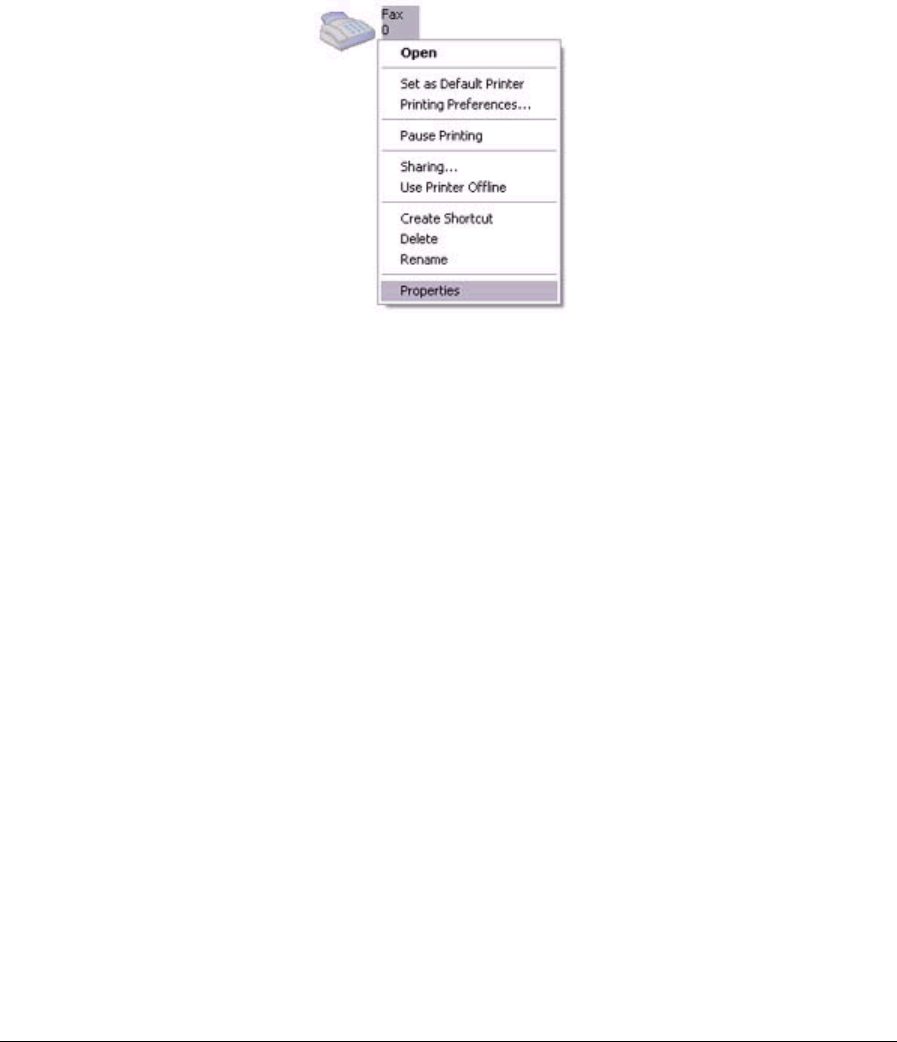
153
Please refer to "Using a modem station for fax transmissions" for information
on the configuration procedure.
• The telephone number of the fax destination may have been entered
incorrectly. Please check the telephone number.
• If the setting under COM Auto Connect Settings has been set to "Off", a
connection will not automatically be established with the modem. Please
connect to the mobile telephone manually.
• The fax service may not have been enabled for sending (or receiving).
Please check the settings by following the procedure below.
1. Open [Printers and Faxes] from the Control Panel, right-click on
the [Fax] icon, and then click on [Properties].
The [Fax properties] window will appear.
2. Select the [Device] tab, right-click on the modem you wish to use,
and then click on [Properties] .
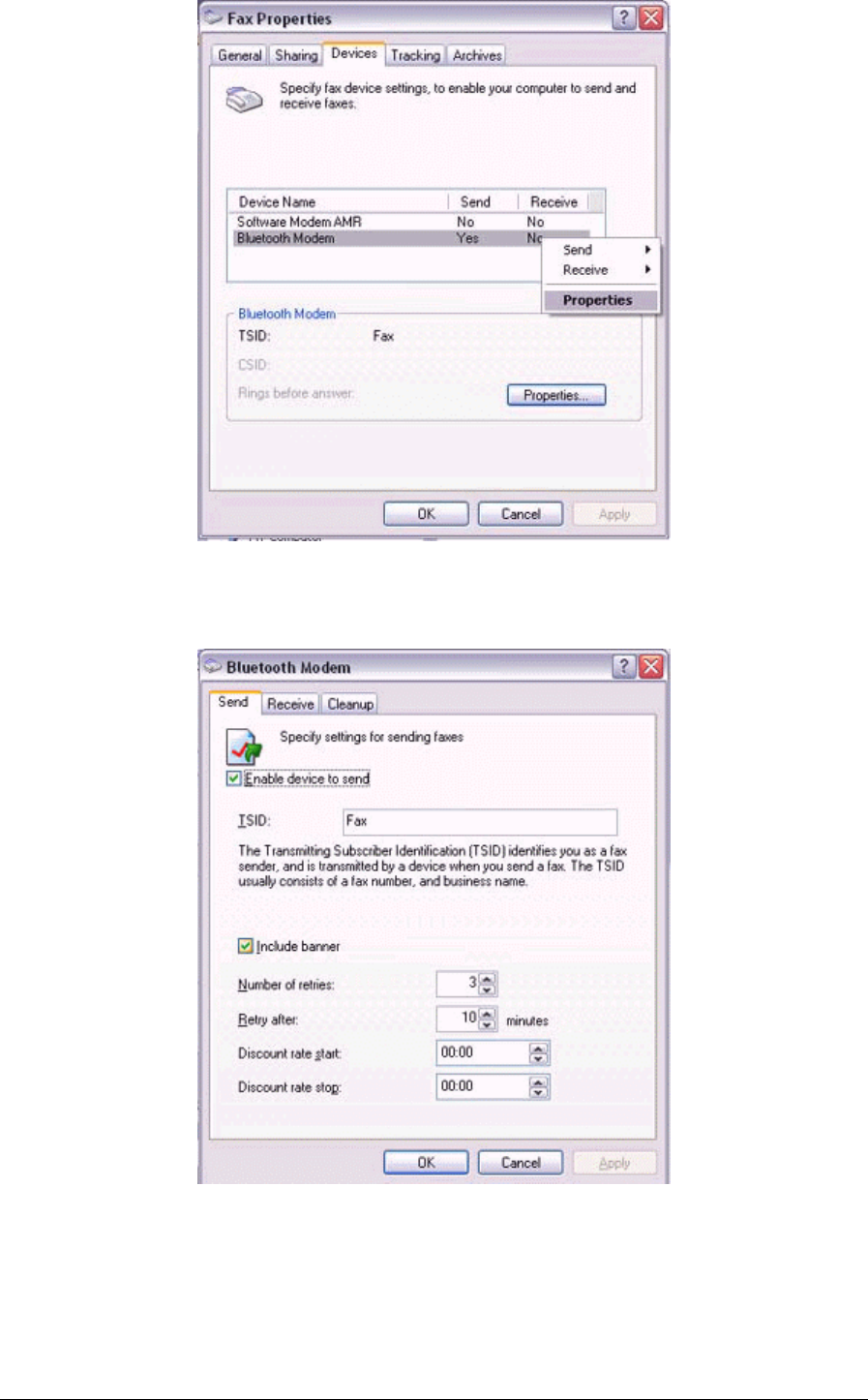
154
3. Select the [Send] tab, and then confirm that "Enable device to
send" has been checked.
4. Select the [Receive] tab, and then confirm that "Enable device to
receive" has been checked when you wish to receive faxes).
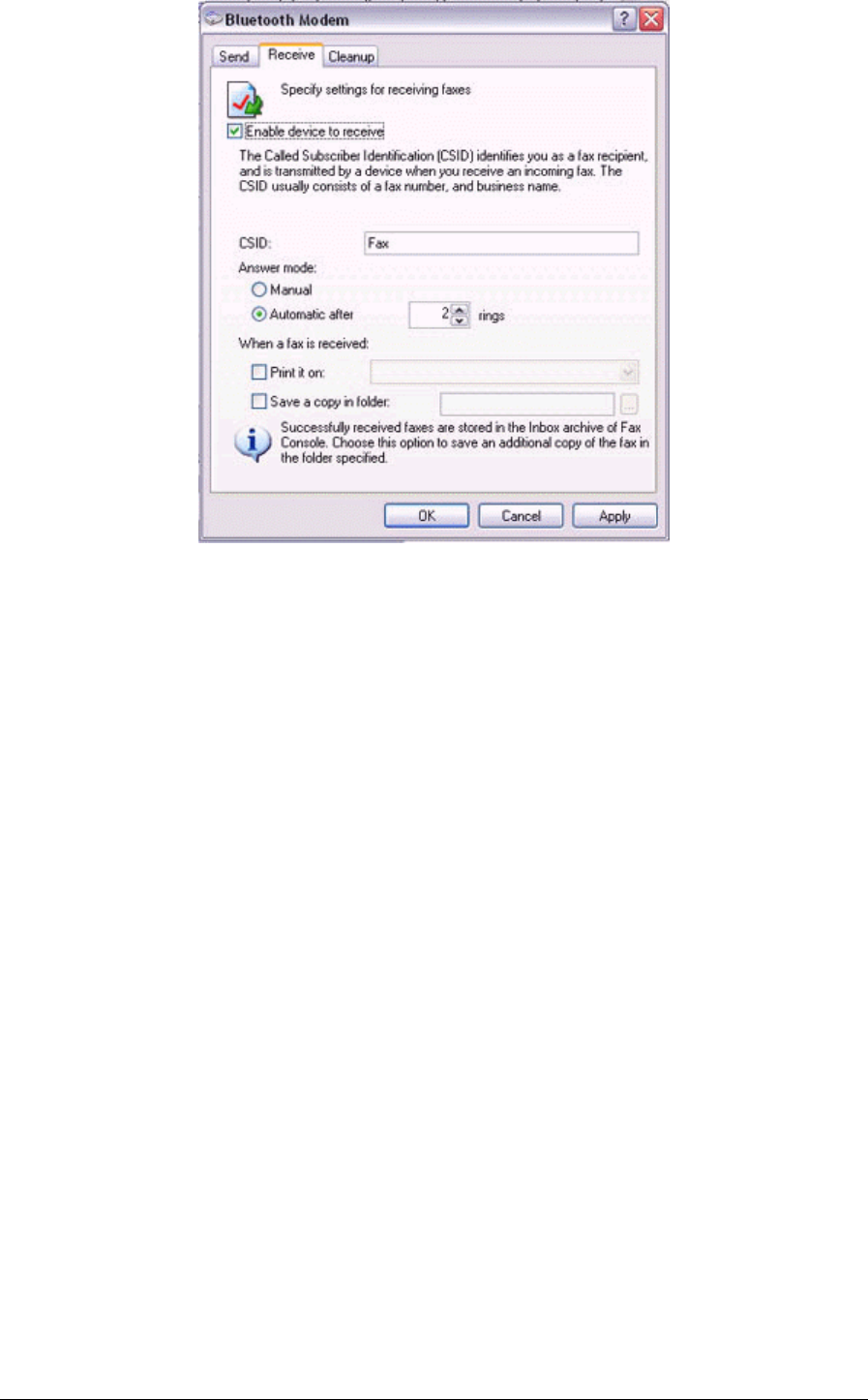
155
5. Click on the [OK] button.
6.5 Using a PDA
Q: Cannot make an ActiveSync connection.
• Please confirm that you have installed ActiveSync v3.7 or higher on your PC.
• ActiveSync is installed to COM7 as a default. Please refer to "Synchronizing
data with a PDA" and re-configure your ActiveSync connection.
If a port other than COM7 has been used, please amend the ActiveSync
connection settings accordingly.
Q: Cannot locate a saved file.
• The type of file sent to your PDA, as well as the profile used to send the file,
may affect where folders saved on your PDA are located.
Examples:
Images transferred to your PDA using "Image transfer" > saved in the "Image
transfer" folder
Images transferred to your PDA using "File transfer" > saved in the "Shared
folder"
6.6 Using a camera
Q: Camera cannot be detected.

156
• If the camera is connected to and is being used by another device, the
camera will be undetectable even if you search for it.
Q: Cannot connect to camera.
• If the camera is connected to and is being used by another device, no other
device will be able to connect to the camera.
Q: Images from the camera can be displayed, but no pictures can be taken.
• The memory card in the camera may be full.
Please make a backup of all your necessary data on alternative media, then
delete the images from the memory card, and ascertain how much free space
remains.
Q: Camera images do not appear in window.
• The camera may not have been set to remote camera mode (image browse
mode, configuration mode, etc).
Certain cameras will end the Bluetooth connection automatically if you
change the settings in a mode other than remote camera mode. Please
re-connect to the camera when you next wish to use the device in remote
camera mode.
6.7 Using a Bluetooth Headset
Q: Bluetooth Headset cannot be detected.
• If the Bluetooth Headset is connected to and is being used by another device,
the Bluetooth Headset will be undetectable even if you search for it.
Q: Cannot connect to Bluetooth Headset.
• If the Bluetooth Headset is connected to and is being used by another device,
no other device will be able to connect to the Bluetooth Headset.
• A Bluetooth connection will be impossible if the Bluetooth Headset is
connected to a power adaptor.
Please remove the power adaptor and re-connect.
Q: Sound cuts out/cannot hear anything.
• Using a Bluetooth headset with other Bluetooth devices may cause problems
such as interruptions in sound, reduced transfer speed or failure during file
transfer, and disconnection of the other Bluetooth devices. We strongly
recommend using a Bluetooth headset on its own and not in connection with
other Bluetooth devices.

157
• Please confirm that the Bluetooth Headset is being operated correctly (for
example, ensure that the correct mode (audio or communications) mode has
been selected).
• Please confirm that the voice file or CD is being played back normally on your
PC.
• Please check the volume settings on your Bluetooth Headset and PC.
• If Windows Media Player or another audio-related application is active when
you try to connect your Bluetooth Headset, you may find it impossible to
connect properly to the Bluetooth Headset, or even to use it at all.
Please start such applications after you have connected to the Bluetooth
Headset.

158
Federal Communication Commission Interference Statement
This equipment has been tested and found to comply with the limits for a Class B
digital device, pursuant to Part 15 of the FCC Rules. These limits are designed to
provide reasonable protection against harmful interference in a residential
installation. This equipment generates, uses and can radiate radio frequency energy
and, if not installed and used in accordance with the instructions, may cause harmful
interference to radio communications. However, there is no guarantee that
interference will not occur in a particular installation. If this equipment does cause
harmful interference to radio or
television reception, which can be determined by turning the equipment off and on,
the user is encouraged to try to correct the interference by one of the following
measures:
- Reorient or relocate the receiving antenna.
- Increase the separation between the equipment and receiver.
- Connect the equipment into an outlet on a circuit different from that to which the
receiver is connected.
- Consult the dealer or an experienced radio/TV technician for help.
FCC Caution: Any changes or modifications not expressly approved by the party
responsible for compliance could void the user's authority to operate this equipment.
This device complies with Part 15 of the FCC Rules. Operation is subject to the
following two conditions: (1) This device may not cause harmful interference, and (2)
this device must accept any interference received, including interference that may
cause undesired operation.
The antenna(s) used for this transmitter must not be co-located or operating in
conjunction with any other antenna or transmitter.